


























Arecent Shabbos guest, who is a baal teshuva, told us about a woman whom he was dating a few years ago. She was being megayer, but he realized that she never fully grasped the concept of how important details are in everything we do. He had grown up frum and lost his way at some point in life. But he knew how careful we are with bringing in Shabbos on time, how important it is that not a drop of milk and meat don’t mix, how we can’t have a stitch of shatnez in our garments. But for someone who didn’t grow up like that, it is very hard to understand how our lives revolve around what seem to be trivial particulars. For us, these minutiae are not inconsequential; they are the backbone of Yiddishkeit.
Ultimately, when he noticed how she couldn’t grasp the significance of these details in Judaism, he broke off the relationship. He understood that she wasn’t really on board with becoming a Jew.
I’ve thought about his comment a lot this week. During the year, we are careful with our mitzvos and minhagim. We keep our dairy and meat dishes separate. We rush to light candles for Shabbos on time. We ask shailos and look up halachos. But Pesach is the time when so much of how we prepare for the yom tov and how we celebrate the holiday revolves around the “little things.”
Watch a woman clean for Pesach. She vacuums. She scrubs. She sprays cleaner on the crumbs she can’t reach, “just to make sure.” Her heart is all about getting rid of those “little things.” And then, when she cooks, she’s even more careful about kashrus than she is year-
round. She washes any of the eggs she uses. She doesn’t use anything that is dropped on the floor. She would never use some salt from a dish she uses during the year. Everything is fresh and new, specific for Pesach.
And what about at the Seder and on yom tov itself? Each family has their own ways of fulfilling and saying the Hagaddah. Does each person say the “Mah Nishtaneh” or just the youngest? Do they use shemurah matzah or machine matzah? Do they eat gebrochts? Is the matzah allowed on the table if there is any liquid on the table as well? Do they peel every vegetable? Do they use sugar on Pesach? Fish? Spices?
Try to explain to someone who is not Jewish how we celebrate this yom tov. They may see us as neurotic or foolish or irrational. But Judaism is not about being neurotic. It’s about being mindful. It’s about awareness. It’s about understanding that there’s a bigger, cosmic significance to what we’re doing. The “little things” are just part of the Big Plan. When we are careful with how we perform our mitzvos, we’re contributing to something so much greater than ourselves.
This year, as we clean our homes and grate the marror, let us remember that the tasks we are completing are not just physical, mundane undertakings. They are commissions assigned to us by the One Above, spiritual assignments that are so much greater than we can comprehend.
Wishing you a wonderful week, Shoshana






Many rabbonim have analyzed the spiritual significace of Monday’s eclipse — especially since it occurred just a few days after another phenomenon, an earthquake, hit New Jersey and shook the tri-state for a few seconds.
There was, though, a key difference between the two events.
The earthquake, which registered 4.8 on the Richter scale, was fully unexpected, and for many people evoked fear and confusion.
On the other hand, the eclipse, which was predicted years before, brought out diametrically opposed emotions.
Amid the continuing war against Hamas, the Russian invasion of the Ukraine, and the persistent divisiveness in this nation, millions of people gathered along the “path of totality” crossing several states, including upstate New York, to watch the eclipse with closeness to the natural work of Hashem — and to each other as fellow human beings sharing a sense of awe and fascination
Even in the five boroughs, where the moon’s shadow blocked out the sun 11 percent short of totality, tens of thousands of people came together in parks, museums, and science centers to watch together as the sun slowly “disappeared.”

There were no protests, political confrontations, or name-calling.
As I viewed the event on the sidewalk in my Flatbush neighborhood, perfect strangers commented how “amazing” and “fascinating” the sight was. Several of them, who hadn’t gotten the special glasses, asked me if I could let them use mine for a few seconds to view the once-in-a-generation phenomenon. I was glad to do it— especially since it could only enhance appreciation of Hashem’s handiwork.
The eclipse, from beginning to end, lasted less than 40 minutes.
Hopefully the feelings stirred by it, will last much longer.
David J. GlennDear Editor,
Our first Av intersected with the colossal mitzvah of milah . Avraham was trembling until he realized that upon doing milah ( Nedarim 32a) he would be considered complete.
How is it that milah brings completeness?
Turnus Rufus asked ( Tanchuma , Tazria 5) Rabbi Akiva why Jews aren’t born circumcised. Rabbi Akiva answered that the mitzvos are given to refine and purify a person and therefore it is up to man to complete himself.

Continued from page 12
And this rectification is possible if we examine another verse where the notion of orlah is mentioned. The Israelites are commanded (Deuteronomy 10:16), “Circumcise therefore the foreskin of your heart, and be no longer stubborn.” The Ramban explains that this circumcision refers to the uncovering of the heart – to see and accept the truth. The mitzvos can only fully refine us if we’re willing to listen and absorb the realities from the Torah and our sages on how to correctly incorporate them into our beings.
Rabbi Aharon Lopinasky uses the menorah to exhibit how we must be complete people, the reason why milah was given. The menorah was carved out of one complete piece and then chiseled into its shape. So too, we must be one complete piece, carving ourselves into full rectification. Only then can we be a vessel to bring forth G-d’s light into the world.
One bad middah terminates completeness, whether it be a grab for power, egoistic movements or weak belief.
Like milah that’s on the eight day, the eighth sefira is hod , glory. In our travels toward completeness and in ultimately capturing it, we bring G-d’s
This in turn exhibits G-d’s completeness and brings peace amongst the nations, as shalom , peace, comes through being shalem , complete.
Steven GenackThe Biden Administration continues its interference in Israeli politics and is attempting to bring down the government of Prime Minister Netanyahu in the middle of the Gaza war. As the Israeli Defense Forces (IDF) are poised to begin Rafah operations which includes relocating 1.5 million Palestinians, the Biden Administration is focusing on splitting the country with riots. They are headed by Ami Dror, who is the leading “rioter” and is in touch with the White House according to his WhatsApp group chat.
There are four components to the U.S. program to destroy the government of Israel: 1) the use of the UN Security Council; 2) actions in Gaza; 3) pressure on government ministers; and 4) mass protests in Israel. Actions have already been happening. The U.S. enabled the Security Council to vote for an immediate cease fire by abstaining from the vote and not vetoing it. Over the weekend there were

mass protests in Tel Aviv and Jerusalem from those in support of bringing the hostages home at any cost. Also, the IDF announced it was withdrawing all but one of its brigades from southern Gaza. There is a sensitivity surrounding Rafah because it is Hamas’ last stand and the remaining hostages, if alive, are probably there.
If Prime Minister Netanyahu is not allowed by the U.S. and world community to finish the job, then Israel may not only lose the war but may cease to exist.
Jan Henock Woodmere, NYDear Editor,
I cannot agree more with educator Etti Siegel, who writes about Pesach prep and how it affects the people in our home.
Every year, I make a very detailed list of things that have to be done in our house for Pesach. It’s very detailed – I write out each drawer and closet in every room. But then I show it to my kids and they each get to decide what works for them to do in each room. This way, they know they are being part of something bigger and know that they are setting themselves up for success by choosing tasks that they feel will work for me. Of course, there are times when some kids will choose only
“easy” jobs. I may ask them to take on something else to help bring in Pesach. Of course, hard work is rewarded, and we all go out to eat together as a family when the kitchen is turned over and the cooking is about to begin!
Gila JankowitzDear Editor,
Now that all the yeshiva boys and seminary girls are back from Israel, it is good for the community to be reminded about driving and parking etiquette.
There are going to be a lot more cars on the streets over the next week or so. Drivers, be careful and be alert. Also, be considerate! Don’t double park or even sit in your car double parked. It creates a traffic jam behind you. When coming back to your car, don’t idle in the car for a long time; let others take your spot – a mitzvah! Keep your phones hands-free when you drive.
Pedestrians, be careful crossing streets. Cross at the crosswalk. Watch young children. Don’t text on your phones as you’re walking. Be alert.
We’re all busy this season but we can make it a safe one as we enter yom tov!
Chana R.

Twenty-two people were arrested in the EU last week after police determined that they were involved with alleged fraud linked to the European Union’s post-pandemic recovery fund. Assets worth more than $650 million were seized, including luxury cars and villas.
After an investigation by the EU prosecutor, eight people were detained,
14 were placed under house arrest and two others were barred from practicing their profession. The arrests took place in Italy, Austria, Romania and Slovakia.
The Italian financial police said it had seized Lamborghinis, Porsches, Rolexes, Cartier jewelry, cryptocurrencies, luxury villas and other items during dozens of raids on homes and offices.
The alleged fraud is likely to renew concerns about the misuse of the EU’s €800-billion recovery fund to help revive the bloc’s economy. Italy was the largest beneficiary of the fund, with grants of more than €194 billion.
The European Public Prosecutor’s Office (EPPO) said a criminal organization is suspected of running a fraud scheme between 2021 and 2023 to swindle Italy’s recovery packages.
In 2021, the group applied to receive non-repayable grants to support small- and medium-sized companies, but later cooked up false balance sheets “to show that the companies were active and profitable, whereas in fact they were non-active, fictitious companies.”
The group received more than €600 million in funds from the Italian National Recovery and Resilience Plan (NRRP) and then transferred the funds
to their bank accounts in Austria, Romania and Slovakia, the EPPO said.
The prosecutor’s office claimed the group used cryptocurrencies, artificial intelligence and offshore cloud servers to carry out and conceal the fraud.
The United States has also attempted to crack down on alleged fraud involving Covid-19 relief resources. A federal watchdog warned in June that the Small Business Administration distributed more than $200 billion in potentially fraudulent post-pandemic funds.

After Germany’s environment ministry called for stricter restrictions on elephant hunting trophy imports, President
Mokgweetsi Masiisi of Botswana criticized the European country, threatening to send 20,000 elephants to Germany.
“Twenty thousand wild elephants for Germany. It’s not a joke,” Maisisi said in a conversation with Bild, a German newspaper. “It is very easy to sit in Berlin and have an opinion about our affairs in Botswana. We are paying the price for preserving these animals for the world.”
German Environment Minister Steffi Lemke, a member of the Green Party, urged Botswana to implement stricter rules to limit the importing and exporting of hunting trophies in order to prevent poaching. Germany is one of the top importers of hunting trophies in the European Union.
Hunting trophies include horns, tusks, heads, antlers, and other animal parts that are collected after the animal is hunted and can subsequently be sold. While many feel that trophy hunting can cause underpopulation for an animal species, Maisisi says that Botswana does more “than any country in the world” to protect animal populations.
Before speaking out against Botswana, Germans should live “together with the animals, in the way you are trying to tell us to,” said Maisisi, adding that Botswana, which is home to the biggest el-








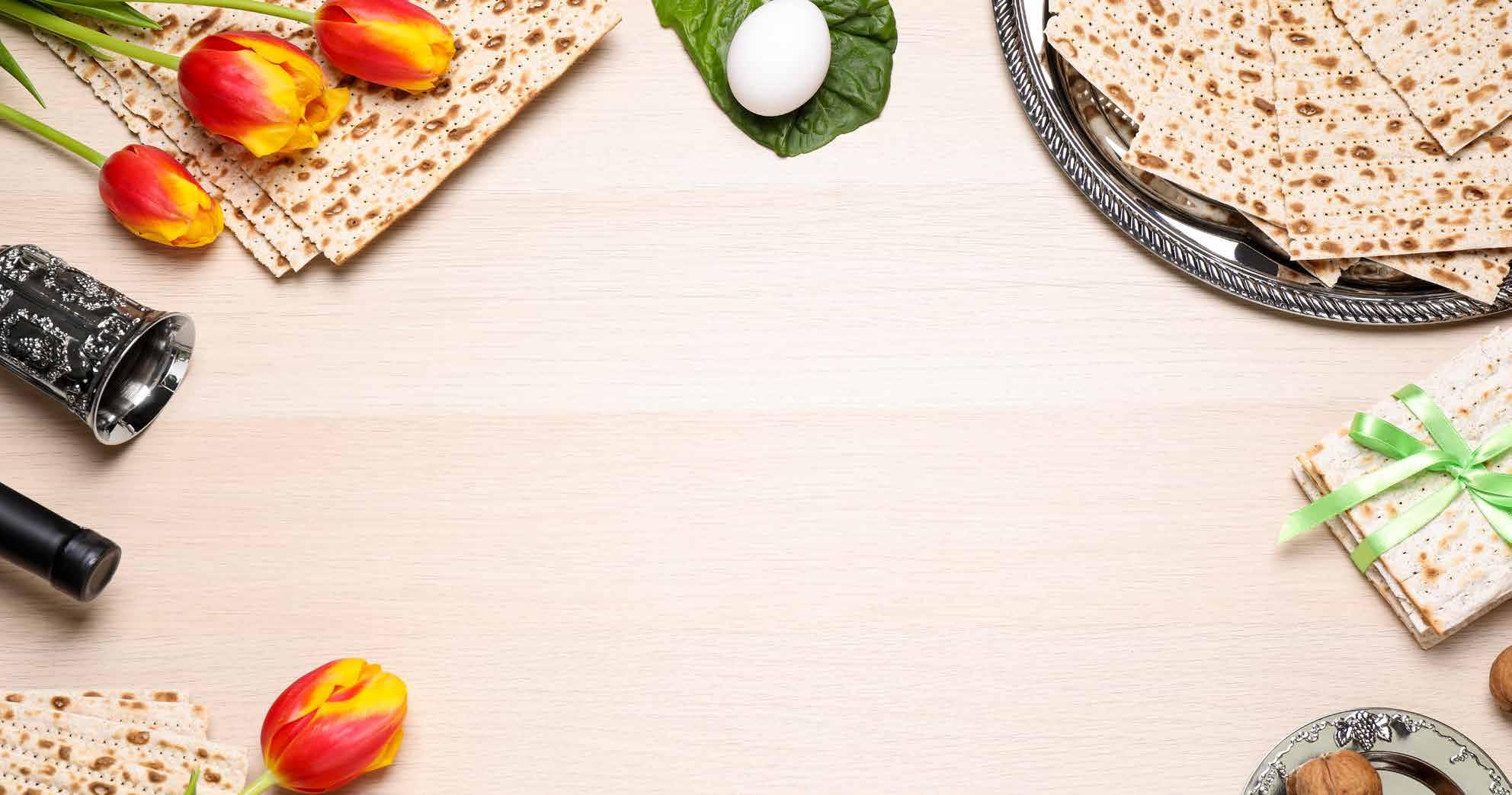












































ephant population in the world, is “one of the last strongholds for African elephants.” There are more than 130,000 elephants in the country.
In fact, the southern African country has said that it has a problem of elephant “overpopulation,” an issue that can potentially be solved by trophy hunting.
Botswana implemented a trophy hunting ban in 2014 in response to the dwindling elephant population. In

A ferry boat carrying 130 people in Mozambique capsized this week, killing at least 100 of its passengers, with 20 others missing, according to the Southeast African country’s Maritime Transport Institute (INTRASMAR). The ship capsized off the country’s northern coast on Sunday; its passengers had boarded the boat to try to escape a cholera outbreak.
Ten people had been rescued.
The boat was not licensed to transport people, but was rather an overloaded fishing boat, said INTRASMAR administration Lourenco Machado on Monday.
The ship, which was traveling to Mozambique Island from Lunga in Nampula province, was likely hit by a tidal wave, according to initial reports.
“Because the boat was overcrowded and unsuited to carry passengers, it ended up sinking,” said Jaime Neto, the Nampula province’s secretary of state, adding that many of the victims were children.
Since 2023, several countries in southern Africa, including Mozambique, have been facing cholera outbreaks. Mozambique has recorded 15,051 cases of cholera since October, resulting in 32 deaths. As of Sunday, Nampula province had recorded 5,084 cases and 12 deaths.
2019, however, the ban was lifted after local communities began complaining about the rule. Now, Botswana has hunting quotas for elephants and other animals.
According to Maisisi, bans on trophy imports would encourage poaching, eliminate natural habitats, and cause poverty in the country. Dumezweni Mthimkhulu, the Environment and Tourism minister of Botswana, noted that trophy hunting is a means of “con-
trolling elephants” rather than eliminating them and generates revenue for the southern African country.
“Minister Mthimkhulu reiterated that hunting is a significant wildlife conservation measure widely used in Southern Africa and other parts of East Africa that generates income and is used to combat poaching, support community development, habitat protection and adapting to the effects of climate change,” the environment ministry said.

On Tuesday, an international court in France ruled that Switzerland’s failure to adequately tackle the climate crisis was in violation of human rights.

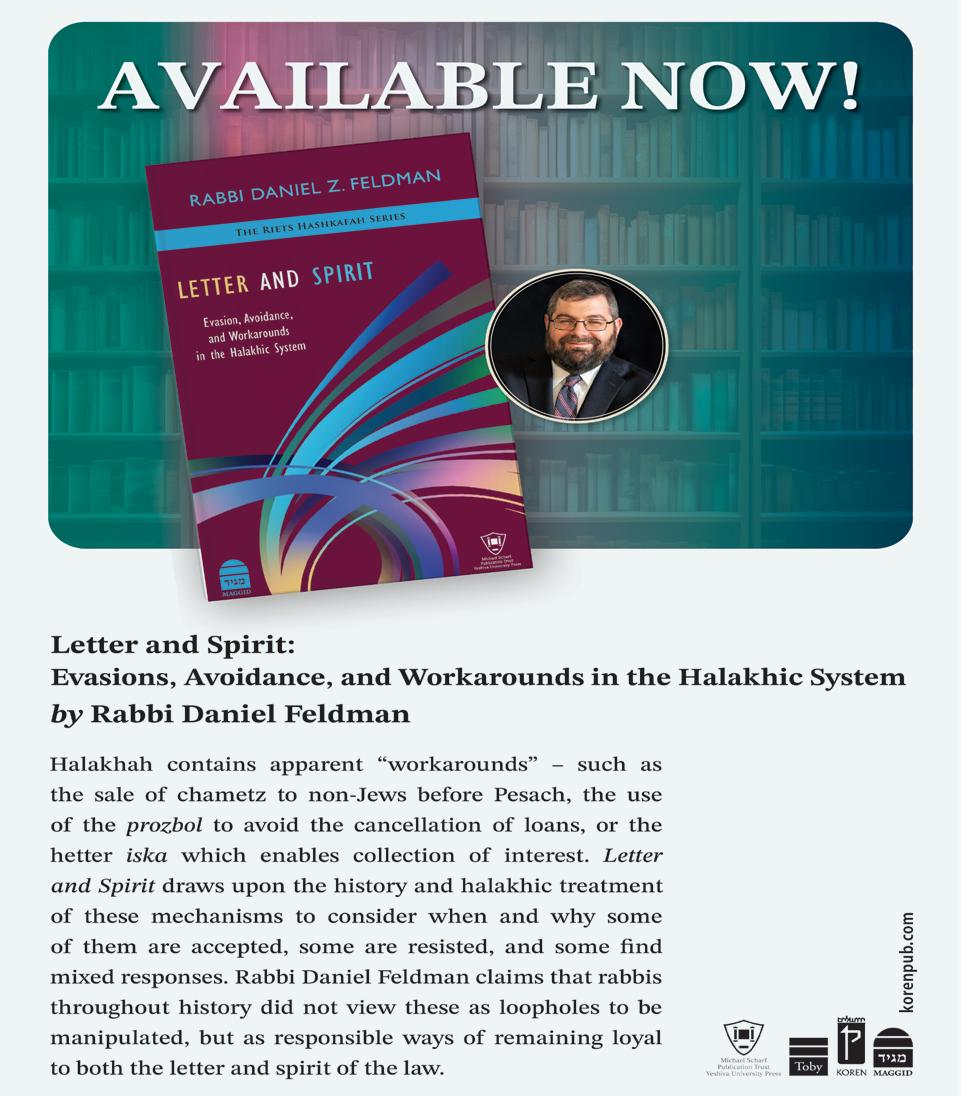


The European Court of Human Rights (ECHR) in Strasbourg, France, delivered its ruling in a case brought by more than 2,000 Swiss women, the majority of whom are in their 70s, against Switzerland’s government. They argued that climate change-fueled heat waves undermined their health and quality of life and put them at risk of dying.
The court ruled that the Swiss government had violated some of the wom -
en’s human rights due to “critical gaps” in its national legislation to reduce planet-heating emissions, as well as a failure to meet past climate targets.
This amounted to a breach of the women’s rights to effectively protect them from the “the serious adverse effects of climate change on lives, health, well-being and quality of life,” the court said in a statement.
The decision is significant because it marks the first time the court has ruled
a lawyer at Global Legal Action Network, which supported the case, said.
“It means that all European countries must urgently revise their targets so that they are science-based and aligned to 1.5 degrees. This is a massive win for all generations.”
The ruling could also force Switzerland to reduce its consumption of fossil fuels more rapidly. Activists say that fossil fuels are the main driver of human-caused climate change.
Environmental activist Greta Thunberg, who attended a demonstration, told reporters outside the court that “this is only the beginning of climate litigation.”
“All over the world more and more people are taking their government to court, holding them responsible for their actions,” Thunberg said, adding: “We are going to use every tool in the toolbox that we have.”

Former Ecuadorian Vice President Jorge Glas had been hiding in the Mexican embassy in Quito when Ecuadorian officials stormed the embassy on Friday night and arrested Glas. On Monday, Mexico said it will file a case against Ecuador at the International Court of Justice after the arrest of Glas which prompted Mexican President Andrés Manuel López Obrador to order the immediate suspension of diplomatic ties with Quito.
In a post on X, Obrador called the act a “flagrant violation of international law and the sovereignty of Mexico.”
on climate litigation. There is no right of appeal, and the judgment is legally binding.
Experts say the court’s ruling could bolster other human rights-based climate cases pending before international courts and could open the floodgates for numerous similar lawsuits to be launched in the future.
“Today’s rulings against Switzerland sets a historic precedent that applies to all European countries,” Gerry Liston,
The breach of diplomatic convention has sent shockwaves through the region, with Latin American leaders from across the political spectrum condemning the incident.
Under diplomatic norms, embassies are considered protected spaces.
It marks the culmination of a series of diplomatic provocations between Mexico and Ecuador this week.
Glas, 54, has since been transferred to a maximum-security prison in Guayaquil known as La Roca. His lawyers

26 have filed an appeal for his release on the grounds of unlawful detention.
The diplomatic staff of the Mexican embassy in Quito and their families arrived in Mexico City on Sunday after leaving Ecuador, according to the Mexican Foreign Ministry. Mexico said that its embassy in Ecuador will remain closed indefinitely, as will its consular services. Mexicans in Ecuador can still get help through a communications system for nationals abroad and from the Mexican embassies in Chile, Colombia and Peru.
Glas, who has been convicted twice on corruption charges, served under leftist President Rafael Correa between 2013 and 2017.
He has been accused by Ecuadorian authorities of embezzling government funds meant to help rebuild after a devastating 2016 earthquake.
Following his arrest, a host of Latin American countries – including regional giants Brazil and Argentina – rallied around Mexico to condemn Ecuador.
Several pointed to a violation of the Vienna Convention on Diplomatic Relations, the international treaty that defines a framework for relations between countries.
Some also pointed to a breach of
Glas’s right to asylum. Nicaragua has joined Mexico in severing diplomatic ties with Ecuador.

On its busiest days, Venice swells with tourists who clog the city’s narrow streets, leave behind piles of garbage, and often frustrate locals. Now, the canal-crossed city is fighting back.
Starting April 25, and for another 29 days scattered mostly around national holidays and weekends through mid-July, day trippers to the historic part of Venice will have to pay 5 euros (about $5.40), a measure city officials hope will encourage people to come during less busy times.
All visitors to Venice will also have to register their presence in the city on the
specified days, filling out an online form that will help officials gauge how many visitors to expect and strategize about how to handle them.
“It’s not about making money — the costs of the operation are higher than what we’re going to make,” Mayor Luigi Brugnaro told reporters. Instead, said Michele Zuin, the city official in charge of budgeting and economics, the aim is “to better manage the numbers of tourists and disincentivize mass tourism, which is what creates, let’s say, the difficulty of living in this city.”
Visitors staying overnight in Venice will not have to pay, nor will those traveling there to work, to visit relatives or to study. Anyone born in the city is also exempt, as are minors younger than 14. And Brugnaro said there would be no cap on the number of visitors allowed in.
Rising improbably from the waters of the Venetian lagoon, the city has struggled to protect a uniqueness that is threatened by rising seas, as well as by mass tourism.
To counter that figurative and literal erosion, the city has installed giant gates at four mouths of the lagoon to keep seawater out and pavements dry, and banned cruise ships from the inner canals.
After registering on the website, vis-
itors will receive a QR code that they will be required to show when entering the city. There will also be spot checks throughout the city.
For now, anyone arriving in Venice without a QR code will be allowed to buy it at the last minute, either on a smartphone or at kiosks set up leading up to the access points, officials said.
Transgressors will face fines of 50 euros to 300 euros plus a 10-euro fee, Zuin said. (© The New York Times)

The Kingdom of Bahrain announced on Monday that it released 1,584 prisoners, some of whom were serving life sentences and others who had been convicted in connection to the protests of 2011.


This mass pardon includes individuals who were implicated in acts of violence or public disorder during the period of political unrest.
The government’s decision to release these prisoners also capitalizes on the “alternative sentences” law, enacted in 2017, which allows inmates who have completed at least half of their sentence to fulfill the remainder through community service, rehabilitation courses, or electronic monitoring, among other methods.
According to a government spokesperson, approximately 65% of those pardoned had been convicted on charges associated with the riots. Bahrain continues to grapple with the aftermath of the 2011 anti-government uprising, primarily led by the Shi’ite opposition against the Sunni royal family’s rule. The unrest was part of the wider Arab Spring protests, marking Bahrain as the only Gulf monarchy to experience significant turmoil during that period. Since then, the Bahraini government has been criticized for its harsh crackdown on dissent, leading to the imprisonment of thousands of protesters, journalists, and activists, often in mass trials. Bahrain has said that its judicial proceedings adhere to international law standards.

Most of us can’t afford a Hermès Birkin bag, which costs thousands of dollars. But some people are so upset that they can’t afford one, that they are challenging the French luxury brand in court by claiming that the exclusivity makes these bags illegal.
The lawsuit was filed on March 19 in a Northern California district court.
The plaintiffs have accused Hermès of exploiting the “incredible market power” that comes from the “unique desirability, incredible demand and low supply” of its most prestigious bag to drive up prices and increase their own profits. They allege that access to Hermès’ perpetually sold-out Birkin bag is predicated on the purchase of

other products, resulting in an “illegal tying arrangement” that violates U.S. antitrust law.
Hermès’ enigmatic selling practices — where the most desirable items, like Birkin and Kelly bags, are offered intermittently and usually to clients who already have a purchase history at the brand — have been the subject of many in the high-fashion world, and more recently have become the subject of countless TikTok videos and Reddit threads about how to play “the Hermès game.”
Last year, Hermès told Business of Fashion it “strictly prohibits any sale of certain products as a condition to the purchase of others.”
Tightly controlled distribution (and scarcity) helped make the Birkin one of fashion’s most consistently covetable products and an asset class all its own — prices can more than double at resale. Still, the exclusivity has benefited Hermès’, with Birkin bags continuing to overperform even when other luxury brands see demand slowing. Revenue rose 21 percent year-over-year in 2023, while net profit was up 28 percent.
Like most luxury houses, Hermès tightly controls its distribution — it sells its leather goods only through its own stores, where stock is never marked down. Birkin and Kelly handbags, in particular, aren’t sold online and sometimes aren’t even displayed in stores.
The brand’s retail experience varies from city to city; local Hermès staff determine how its handbags — for which demand outstrips supply — are sold. Some bags are allocated via waitlists, others offered at the sales associate’s discretion. Others are reportedly offered on a first-come-first-serve basis, particularly at the brand’s original flagship location in Paris. Clients’ preferences are registered, but when customers are offered a particular Birkin, they don’t necessarily get to choose the style or color.
When Simon Harris took office on Tuesday, he became the youngest-ever prime minister of Ireland.
The 37-year-old had run unopposed for leader of the ruling Fine Gael party after Leo Varadkar suddenly stepped down last month.
Harris has held a number of government positions since being earmarked
as a rising political star in his late 20s, most recently serving as the minister for higher education and science.

But he faces a daunting political challenge in the coming months; a general election in Ireland must be held by late March 2025, and Fine Gael is trailing in opinion polls to the Irish republican group Sinn Fein, which was once the political wing of the Irish Republican Army (IRA).
Varadkar led a charge to liberalize some of Ireland’s socially conservative laws, most notably easing the country’s strict anti-abortion mandates. But his government faced backlash over Ireland’s housing crisis and soaring immigration numbers.

Religious authorities in Malaysia have stepped up moral policing efforts during the month of Ramadan.
Ramadan is considered to be the holiest month in the Islamic calendar. During the month, Muslims around the world abstain from eating and drinking during daylight hours and break their fasts after sundown.
In many parts of Malaysia, Muslims caught eating or drinking during daytime hours can find themselves facing fines or even prison.
Around 20.6 million of Malaysia’s 34 million-strong population are Muslims, but the country is also home to sizeable ethnic Chinese and Indian minorities that include Buddhists, Christians and Hindus, as well as indigenous communities.
Under the country’s unusual dual track legal system, which is also federal and varies from state to state, Muslims




are subject to sharia law on a host of social issues including marriage, divorce and fasting.
During Ramadan, religious police patrol the streets even more visibly. Some of them stake out popular eateries to try to catch those flouting Ramadan rules.
Those caught eating or drinking during daytime hours face fines of up to 1,000 Malaysian Ringgit (about $200) and prison terms of up to a

Authorities in the Russian Republic of Chechnya have banned music that they consider too fast or too slow.
Minister of Culture Musa Dadayev announced the decision to limit all musical, vocal and choreographic compositions to a tempo ranging from 80 to 116 beats per minute (BPM) at a meeting on Friday, the Russian state new agency TASS reported.
“[I] have announced the final decision, agreed with the head of the Chechen Republic Ramzan Akhmatovich Kadyrov, that from now on all musical, vocal and choreographic works must correspond to a tempo of 80 to 116 beats per minute,” Dadayev said.
Under Kadyrov’s directive, the region now ensures that Chechen musical and dance creations align with the “Chechen mentality and musical rhythm,” aiming to bring “to the people and to the future of our children the cultural heritage of the Chechen people,” Dadayev added.
Under the new law, many song styles including pop and techno will be banned.
Chechnya sits in the North Caucasus region between the Caspian Sea and the Black Sea. It is an almost entirely Muslim republic, which includes part of Russia’s border with Georgia.
year. Non-Muslims caught selling food, drinks or tobacco to Muslims during fasting hours are also subject to penalties.
Arrest figures have not yet been released for this year, but in 2023, religious officials in the state of Malacca, a major tourist destination, recorded nearly 100 arrests of Muslims caught eating in public during the fasting month, an increase from 41 arrests the previous year, they said.
This year, more than 10 “hotspots” were identified throughout the state, said the chairman of its Islamic Religious Department, JAIM.
Like much of South and Southeast Asia, Malaysia has historically practiced a moderate form of Islam but religious conservatism has been on the rise in recent years. The ultra-conservative hardline Islamist political party PAS made major gains during Malaysia’s 2023 general election and wields great
Kadyrov has been leader since 2007 and has used his time in office to stifle any form of dissent.
The pro-Kremlin leader has also subdued the Chechen separatist movement that fought for independence from Russia for almost two decades.
In July 2020, the U.S. State Department sanctioned Kadyrov for his “involvement in gross violations of human rights.”
According to a statement from the then-Secretary of State Mike Pompeo, the department has “extensive credible

information” of Kadyrov’s responsibility “for numerous gross violations of human rights dating back more than a decade, including torture and extrajudicial killings.”

This week, the IDF recovered the body of hostage Elad Katzir and brought it back home to Israel. The 47-year-old had been murdered by the Palestinian Islamic Jihad terror group.
The operation to retrieve the body was carried out by the Commando Brigade,
following intelligence provided by the Shin Bet security agency and the IDF’s Military Intelligence Directorate.
Elad was among 253 people abducted by Hamas-led terrorists during the October 7 massacre. Palestinian Islamic Jihad operatives took him from his home in Kibbutz Nir Oz along with his parents.
He had appeared in two propaganda videos by the terrorists. In December, Islamic Jihad published a propaganda video showing Elad and another hostage, Gadi Mozes, alive. A second video with Elad was published in early January.
The IDF believes that Elad was killed by the terrorists in mid-January, shortly after he appeared in that video.
Elad had been buried in Khan Yunis in Gaza, at a site used by terror operatives. Information on the grave was obtained around a week ago, with final confirmation on the location received on Friday night. Within a few hours, troops of the Maglan and Egoz commando units reached the site, exhumed the body, and brought Elad’s body back to Israel for identification.
Shortly before the IDF announcement, Elad’s sister posted that her brother’s body had been recovered. In an angry post, she blamed the government for failing to secure a hostage release deal
in time to save him. Carmit Palty Katzir wrote on Facebook that her family had been notified that his body was extracted from the Gaza Strip and will be buried in Kibbutz Nir Oz.
“Elad was brought to Israel last night, after being murdered in captivity,” she wrote, adding that the IDF spokesperson would announce the “brave rescue operation.”
“The IDF spokesman will not tell you that the prime minister, the cabinet and the IDF have no idea where most of the hostages, alive and murdered, are held. He won’t tell you either that they have no way to protect the hostages, even when they know where they are,” she added in the post, claiming that her brother “could have been saved if a deal would have happened on time.”
Addressing the “cowardly” government, she says, “Look at yourselves in the mirror and see if your hands didn’t spill that blood. You have 133 more hostages to redeem, worlds to save.”
Elad was a farmer and social activist who volunteered for the Hadar Foundation, showing up each week to support the fight for the release of Hadar Goldin and Oron Shaul, two soldiers whose bodies are held in Gaza.
Elad’s mother, Hanna, was also kid-
napped by Hamas on October 7. She was released on November 24 as part of a temporary ceasefire deal. The Palestinian Islamic Jihad had falsely announced Elad’s death, allegedly in an IDF attack, days before her release.
Rami Katzir, Hanna’s husband and Elad’s father, was murdered on October 7.

Ankara on Tuesday announced Israeli export restrictions after Jerusalem denied a Turkish request to airdrop aid to Gaza.
The government of Recep Tayyip Erdoğan, which openly supports Hamas in its war against Israel, said that the trade measures would apply to 54 different categories and would last until a ceasefire is



declared in Gaza.
Turkey’s Trade Ministry said that the restricted exports would include iron and steel products, construction equipment and materials, machines and more.
Turkish Foreign Minister Hakan Fidan said on Monday that the country would take punitive measures following the Israeli rejection of its offer to drop deliveries of aid into Gaza.
Israeli Foreign Minister Israel Katz responded on X to the move, writing that
Erdoğan “is once again sacrificing the economic interests of the people of Turkey for his support of the Hamas murderers in Gaza who [assaulted], murdered and desecrated the bodies of women, girls and adults, and burned children alive.
“Israel will not succumb to violence and extortion, will not overlook the unilateral violation of our trade agreements and will take parallel measures against Turkey that will harm the Turkish economy. I gave the directive to prepare an
news site Globes reported on Tuesday, citing agencies working with Israeli importers who say there is no timetable for when the obstructions will end.
Turkish Airlines announced last week that it would continue to suspend its Israeli operations until March 2025.
Erdoğan, whose ruling Justice and Development Party (AKP) just took a thumping at the polls in local elections, has been displaying open hostility to Israel and support for Hamas since the start of the Gaza war in October.
The hostile atmosphere in Turkey prompted Israel’s National Security Council to issue a travel warning for Israelis not to visit the country.
Last month, Erdoğan compared Israeli Prime Minister Benjamin Netanyahu and his government to “Hitler, Mussolini and Stalin, like today’s Nazis.”
Jerusalem “continues to commit massacres against the Palestinian people,” he said, adding that Turkey would do “what is necessary to hold Israeli officials accountable.”
Erdoğan also stated that Turkey “cannot be coerced into designating Hamas as a terrorist organization. We communicate with them openly and stand behind them.”
Netanyahu blasted the Turkish leader over the remarks, saying, “Israel upholds the laws of war and will not be subject to moral preaching from Erdoğan, who supports [the] murderers and rapists of the Hamas terrorist organization, denies the Armenian genocide, massacres Kurds in his own country and cracks down on regime opponents and journalists.” (JNS)

additional list of products that Israel will prevent Turkey from exporting and to contact countries and organizations in the United States to halt investments in Turkey and prevent the import of products from Turkey and to our friends in the American Congress to examine the violation of the boycott laws and impose sanctions on Turkey accordingly.”
Ankara has already been blocking exports to Israel, delaying or not approving shipments since March 12, the business
Lidor Levy was stabbed in Gan Yavne last Sunday. On Thursday, he passed away due to the injuries he sustained in the terror attack.
Lidor was a 34-year-old computer engineer. He had a one-year-old daughter. His wife is pregnant.
Lidor was seriously wounded last Sunday when a Palestinian terrorist went on a stabbing spree at a local mall. Another man was seriously injured, and a teenager was moderately injured. All three were rushed to Assuta Medical Center in


Ashdod, with Lidor later transferred to Ichilov for neurosurgery for a penetrative head injury.
“Lidor was an exemplary father, spouse, brother and son. He was a person full of love, nobleness, and generosity… We are left with a huge hole in our hearts. We will continue to live our lives according to the values he inculcated in us as a way of memorializing him,” his family said in a statement.
The terrorist, a 19-year-old Palestin-
ian from Dura in the southern West Bank, was shot dead by security officers who responded at the scene.
Lidor was previously seriously wounded in 2009 during his service with the IDF Combat Engineering Corps in Gaza. Although he received an exemption from reserve military duty, he tried to get the army to call him up during the current war with Hamas in the Gaza Strip. Following the Gan Yavne attack, Hamas released a statement praising it as
assassinate National Security Minister
Itamar Ben Gvir and attack Israeli army bases, government locations, Ben Gurion Airport, and the West Bank settlement of Kiryat Arba. The terrorists also planned on kidnapping IDF soldiers. The nefarious plot was thwarted by the Shin Bet, the security agency said on Thursday.
“Within this framework, there was even an intention to assassinate National Security Minister Itamar Ben Gvir, by obtaining an RPG rocket in order to carry out the attack,” the agency said.
Ben Gvir resides in Kiryat Arba and is the leader of Otzma Yehudit, a far-right political party. He is currently the Minister of National Security.
The group of terrorists planned on renting a piece of land in Rahat, a city in southern Israel, or in the West Bank, in order to build an underground weapons factory and training facility. According to the Shin Bet, the group also sought funding and instructions from Hamas, with a Hamas terrorist from Gaza offering to fund the cell’s attacks.
The Arab Israelis involved in the plot were identified as Bilal Nassara, Wissam Siwati, Hamza Ghaith, Saud Abu Laban, and Sameh al-Obra, all of whom were from Rahat, as well as Yousef Abu Hawli, who was from Lod, and Fahmi Kathani, who was from Ma’ale Iron.
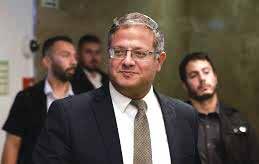
The terrorists from the West Bank included the group’s recruiter, Akram Ammer, and Muhammad Sabheh, who were from Tulkarem, and Ahmed Atiq and Ahmed Saleh, who were from Jenin.
Charges were brought against ten individuals suspected of involvement in the terror plot at the Beersheba District Court last week.
a “heroic operation” and calling on Palestinians to “escalate” attacks on Israelis. Hashem yishmor
A group of seven Arab Israelis and four West Bank Palestinians plotted to
Last Thursday, the IDF, Defense Ministry, Western Wall Heritage Foundation, and IDF Orphans and Widows Organization hosted a ceremony at the Kotel, celebrating the bar and bas mitzvahs of fifty-two children who have lost at least one
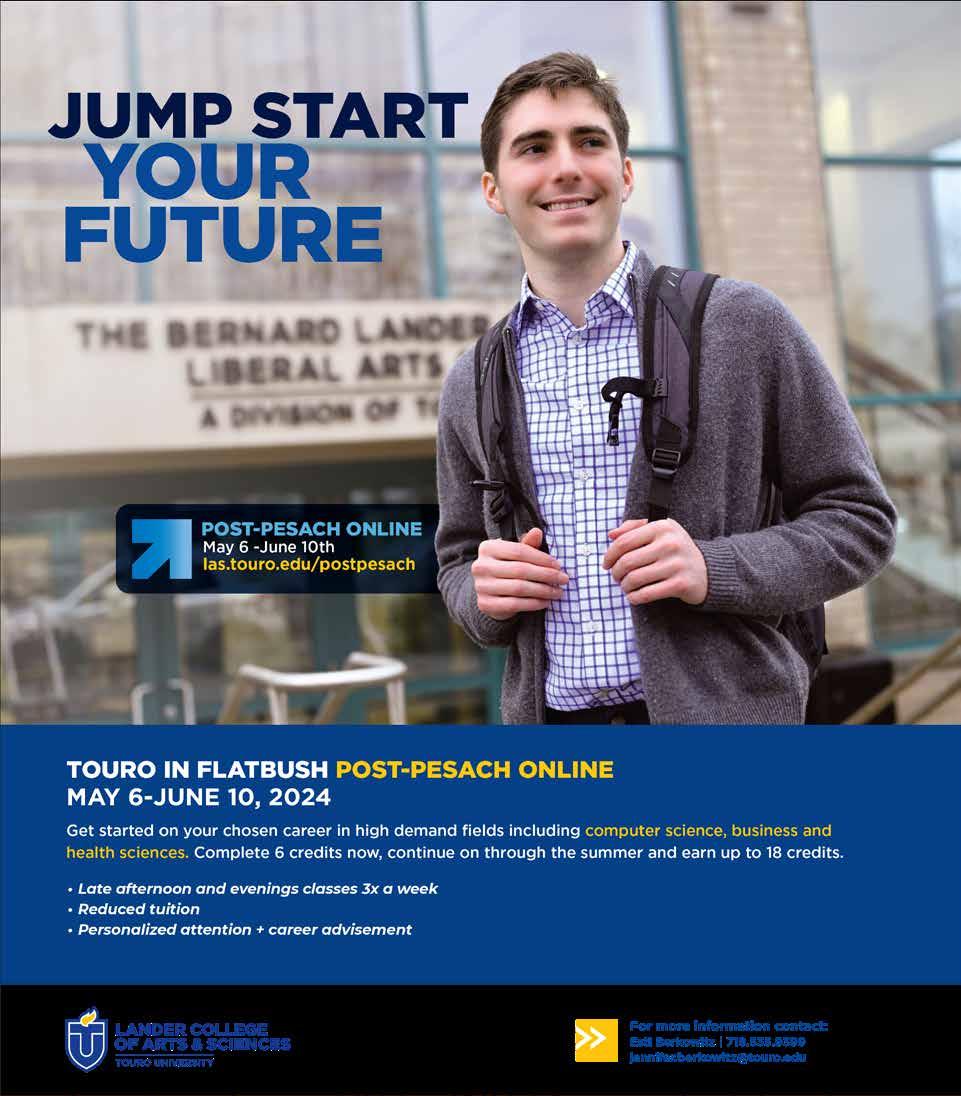

parent serving in Israeli security forces. The event was funded by private donors.
Of the fifty-two orphans, five lost a parent as a result of the war in Gaza, which Hamas instigated on October 7.
“These events really do bring happiness,” said the mother of Lidor Shlomo, whose father Sgt. Maj. Adir Shlomo, a Sderot police officer, was murdered on October 7. “It gives us a chance to get out of…the sadness. It is heartwarming.”
The father of twelve-year-old Oria Go-
lima, Sgt. Maj. Shmuel Smatzo Golima, was also killed at the Sderot police station on October 7.
Golima said, “I feel happy today because I met my friends from the IDF Widows and Orphans Organization camp I went to in December. Only they can understand what I feel. And I miss my father. This is my first birthday without him, and he should have been at my bat mitzvah.”
Rabbi Shmuel Rabinowitz, the Kotel’s
chain of generations; you are leaders,” said Rabbi Rabinowitz.
Following the ceremony, the bar mitzvah boys donned tefillin in the Kotel’s men’s section, with IDF soldiers helping them. Afterward, each boy had the opportunity to make a blessing on the Torah. The bas mitzvah girls were in the Western Wall Heritage Center, where their widowed mothers blessed them.

Later that day, the children and their families congregated at Jerusalem’s Museum of Tolerance, where President Isaac Herzog delivered a speech.
“Today is a holiday for you and for us,” Herzog told the families. “From a young age, you were already exposed to profound pain, loss and hardship. It’s hard to argue that you didn’t grow up too fast. But you learned to grow from the pain, beside the pain. Each and every one of you is a hero in your own right. And I am very, very proud of you.”

Nili Margalit, 42, on a tour of Europe to raise awareness of the 133 Israeli hostages still in captivity, told France’s Le Point magazine on Monday that it was Palestinian Arab civilians, not Hamas, who abducted her from her home in Nir Oz on Oct. 7.
chief rabbi, and Rabbi Eyal Moshe Krim, the IDF’s chief rabbi, jointly officiated the ceremony.
“In each and every one of our lives, there are important moments which can change one’s path and create one’s identity,” Rabbi Krim said in his speech. “Every single one of you has already had one of these moments, a scarring moment in which your path changes suddenly. You did not ask for this.”
“You are not just another link in the
“They negotiated with Hamas to sell me. When they were paid, I was taken straight into a tunnel,” she said.
Margalit described the day of the attack. At 6:30 a.m., she jumped up when she heard the alarms warning of incoming rockets and ran to her safe room. WhatsApp messages flooded in, some warning of terrorists in her kibbutz.
At 9:00 a.m., the terrorists, actually civilians, reached her home. They set fire


inside her house and pulled her out of her safe room. They put her on a golf cart, covered her in a white sheet and drove her to the Gaza Strip border. She was surrounded by shouting Palestinian Arab civilians with Kalashnikov rifles.
She was then transferred to a car at the border and taken to Khan Yunis. At that point, she was “sold” to Hamas.
Margalit was taken to a “reception room” in a tunnel, which held about 30 people, some of whom she recognized from Nir Oz. The Israeli men had swollen faces and injured legs from being dragged on motorcycles.
They were divided up into smaller groups, including one for people over 70, the weak and sick. Margalit mentioned that she was an emergency room nurse. “Helping was my way of surviving,” she said.
Margalit was released on November 30 along with seven others as part of a hostage-prisoner deal between Israel and Hamas.
One of the other hostages released that day was Mia Schem, who was captured while attending the Nova music festival. Schem told Israeli television in December that what she encountered in Gaza was “pure hatred.”
“There are no innocent citizens there. They are families controlled by Hamas. There are children who from the moment they are born are taught that Israel is Palestine and just to hate Jews,” she said. (JNS)

According to Forbes’ 2024 ranking of billionaires, there are now thirty-six Israeli billionaires, which is six more than in 2023.
Assaf Rappaport, 40, Yinon Costica, 41, Ami Luttwack, 40, and Roy Reznick, 35, the founders of Wiz, an Israeli cloud security company, joined the billionaires’ club, with each having a net worth of approximately $1 billion. Roy Mann, a 45-year-year-old who co-founded Monday.com, was added to the list, and David Fattal, a hotel chain owner, was re-added
to the list, with both billionaires amassing a fortune of around $1.3 billion.
Miriam Adelson, the 78-year-old widow of businessman Sheldon Adelson, is the richest Israeli and the 53rd-richest person on Forbes’ list, with a fortune of $32 billion. Although Adelson is Israeli, Forbes, in its ranking, considered her an American, since she has U.S. citizenship and resides in Las Vegas.
The richest person in Israel, according to Forbes, is Eyal Ofer, a 73-year-old who chairs Ofer Global Holdings, with his 68-year-old brother Idan Ofer taking second place. The brothers, who are the sons of deceased Israeli businessman Sammy Ofer, who was, at one point, the richest man in Israel, have net worths of $24 billion and $15.8 billion respectively.
After the Ofer brothers come brothers Igor and Dmitri Bukhman, who own Playrix, a mobile game company, and have a fortune of $9 billion.
The fifth richest person in Israel is Teddy Sagi, a 52-year-old with a net worth of $6.4 billion who founded Playtech, a gambling software development company.
Bernard Arnault, the CEO of French luxury goods company LVMH, was named the richest person in the world by Forbes, with a fortune of around $233 billion. In second place came Tesla and SpaceX founder Elon Musk, who has $195 billion, and in third, Jeff Bezos, the founder of Amazon, with a fortune of $194 billion.
In the top ten, there was also Mark Zuckerberg, the CEO of Meta; Larry Ellison, the co-founder of Oracle; Bill Gates, the co-founder of Microsoft; Larry Page, the co-founder of Google; Steve Ballmer, the former CEO of Microsoft; and Warren Buffet, the co-founder and CEO of Berkshire Hathaway.
Taylor Swift, Magic Johnson, and OpenAI CEO Sam Altman joined the list as well this year.
In all, there are 2,781 billionaires in the world, according to Forbes.
Since October 7, when the Israel-Hamas war broke out, there have been increased concerns of IDF soldiers sustaining traumatic brain injuries (TBI), or concussions, with findings indicating that 25% of Israeli soldiers wounded in nonblast situations and 75-80% of those injured in a blast have concussions.

Dr. Raquel C. Gardner, the director of clinical research of the Joseph Sagol Neuroscience Center at Sheba Medical Center, is particularly concerned with concussions that are “invisible” and are not obvious. In 2021, Gardner, along with her family, immigrated to Israel and has since established a wartime TBI program at Sheba Medical Center.

“We still do not know what the longterm effects of single or multiple occurrences of TBI are,” Gardner explained.
“At least one of three things needs to happen after the exposure for there to be a clinical TBI diagnosis. One is a loss of consciousness for any period. Another is what we call peritraumatic amnesia, or a loss of memory immediately after the exposure,” said Gardner. “The final one is an alteration of consciousness, which is essentially confusion, disorientation, or repeated questioning. You can categorize the severity of the injury based on how
bad the symptoms are and how long they lasted after the exposure.”
From 2000 to 2019, 413,853 United States Army officials were diagnosed with TBI, according to the U.S.’s Defense and Veterans Brain Injury Center. Although those with TBI can receive treatment and have a full recovery, concussions generally cannot be detected by medical imaging, making it a difficult injury to diagnose.
According to Gardner, if symptoms of injury are serious enough, a head CT can be conducted on the soldier.
“If blood is seen on the CT, that is another way to make a clinical diagnosis of TBI,” she said.
Gardner’s program at Sheba employs top TBI screening tools, interviews with injured soldiers, and educates soldiers on how to rehabilitate. The program also uses FDA-approved blood testing technologies from Abbott Laboratories that could help diagnose injured soldiers by potentially ruling out intracranial hemorrhage.
On early Sunday morning, all IDF troops were withdrawn from Gaza, ex -

cept for the Nahal Brigade, which is currently operating in the Netzarim Corridor, which traverses Gaza from southern Israel’s Be’eri region to the coastal area of the Strip. The Netzarim Corridor will allow the Israeli military to conduct operations in northern and central Gaza and will block Gazans from coming back to the north for the time being. The corridor will also help humanitarian groups bring aid to northern Gaza.

Following the withdrawal, terrorists in Khan Yunis fired five rockets at communities in southern Israel, but the Iron Dome shot down some of the rockets and no damage or injuries were reported.
The IDF views targeted military operations, such as the recent attack on Shifa Hospital in Gaza City and other actions in the northern Gaza Strip,
based on new intelligence, as a better method of battling Hamas.
According to the IDF, the military accomplished its mission in Khan Yunis, as the city’s Hamas brigade was defeated, about thirty kilometers of tunnels were destroyed, and thousands of terrorists were eliminated. Additionally, the 98th Division, which was withdrawn from the area on Sunday, was in need of rest and relaxation time following months of intense battling.
Of Hamas’ twenty-four battalions, eighteen are no longer operational as organized military units, according to Israeli officials. However, some smaller groups of Hamas terrorists are still operational.
Two Hamas battalions are operating in central Gaza, while four are still in Rafah, a city in southern Gaza. Although Prime Minister Benjamin Netanyahu has approved a ground offensive into Rafah – a military plan that has been heavily criticized by the United States and other countries –the prime minister has yet to order the IDF to begin the operation. The Rafah operation will not be impacted by Sunday’s withdrawal.



It wasn’t sunny skies for Southwest Airlines on Sunday when a Boeing 737800 experienced difficulties during takeoff. The engine cover of the aircraft fell off during takeoff in Denver and struck the wing flap, prompting the Federal Aviation Administration (FAA) to open an investigation.
The plane safely returned to the airport and was towed to the gate after losing the engine cowling. It had climbed around 4,000 feet before returning 25
minutes after takeoff.
The 737-800 is in the prior generation of the best-selling 737 known as the 737 NG, which in turn was replaced by the 737 MAX.
There is heightened sensitivity around the Boeing brand right now as the company faces intense scrutiny. The company has come under intense criticism since a door plug panel tore off a new Alaska Airlines 737 MAX 9 jet at 16,000 feet on January 5. In the aftermath of that incident, the FAA grounded the MAX 9 for several weeks, barred Boeing from increasing the MAX production rate, and ordered it to develop a comprehensive plan to address “systemic quality-control issues” within 90 days.
Boeing production has fallen below the maximum 38 MAX planes per month the FAA is allowing. The Justice Department has opened a criminal investigation into the MAX 9 incident.
In December, the FAA proposed mandating engine housing inspections and component replacements on Boeing 737 NG airplanes after a 2018 Southwest fatal fan blade incident.
With regard to this week’s incident, it is not uncommon for a loose cowling to snap off if not fitted properly, and doesn’t pose a safety issue to passengers.


Ellis Island’s museum will undergo a $100 million renovation, over a century since it served as the entry point for millions of immigrants to the United States.
“This is a historic effort in a really important place to assure that it remains vital and relevant,” said Jesse Brackenbury, the Statue of Liberty-Ellis Island Foundation’s CEO and president.
Ellis Island opened for immigrants in 1892. According to the National Park Service, around 40% of U.S. residents are descendants of people who immigrated through the island, which is in New York Harbor.
“This is kind of the emotional core of a visit to the island. You get off the ferry in the exact same place where 12 million people got off the ferry, and you walk into the baggage room, and you follow in their footsteps…in a place where the walls are just vibrating with history,” Brackenbury said.
One of the features that will be expanded in Ellis Island’s museum will be its ancestry database, which will see 90 million new records that visitors can search through.
“In broadening the database to have not just the Port of New York records, but records from the Port of San Francisco, and from New Orleans, and so on, we broaden that experience that so frequently right now brings people to tears,” he said.
After Ellis Island, from which twelve million immigrants were processed, stopped operating in 1954, the location fell into disarray.
“It was a ruin… there were trees growing in the great hall,” said a former CEO of the foundation.
However, in 1982, Ronald Reagan, who was president at the time, requested that Lee Iacocca, the chairman of Chrysler, organize a private fundraising campaign to renovate Ellis Island’s museum and the Liberty Island, where the Statue of Liberty stands. It has been over thirty years since that restoration, and further renovations are now required, according
to Brackenbury.
“Right now, it can feel in places like a book on the walls, because it’s a 34-yearold museum,” Brackenbury said. “We’re adding close to 100 media pieces — films and interactives. When you walk in the front door, that experience will be transformed.”
The foundation has, thus far, secured 60% of the funds required for the renovation. Those who donate $18.92 (in reference to 1892, when Ellis Island first opened) or more will have their names digitally featured in the museum’s new baggage area. The foundation expects the museum to be fully renovated in 2026, but the museum will stay open during the restoration process.

A San Fernando Valley money storage facility, which is operated by private security company GardaWorld, was robbed last week of up to $30 million, making it the largest cash heist Los Angeles has ever seen. The FBI and Los Angeles Police Department have jointly launched an investigation into the crime.
The theft occurred last Sunday night, a holiday, in Sylmar, a suburban area within the San Fernando Valley. Authorities were notified about the crime on Monday. The facility had been storing money from businesses in the region.
On Thursday, FBI Los Angeles announced that it, in collaboration with the LAPD, is looking into “a large theft” in the San Fernando Valley. No alarms were set off during the heist, leading experts to believe that the robbers responsible are skilled in the art of evading security measures. Part of the investigation is exploring the possibility that the culprits had internal knowledge of the premises.
The previous record for a cash heist in Los Angeles was set on September 12, 1997, when $18.9 million was stolen from Dunbar Armored Inc. facility on Mateo Street. The individuals involved in that heist were later arrested.



In 2022, fifty or so illegal migrants were flown from Texas to Martha’s Vineyard by Florida transport company Vertol Systems Company in flights organized by Florida Gov. Ron DeSantis. Alianza Americas, an immigrant rights organization, and three of the transported migrants, who were each from Venezuela, have since filed a lawsuit, accusing DeSantis, his administration, and the company that brought them to Martha’s Vineyard of lying to the migrants about where the flights would be taking them. A Boston federal judge has since allowed the rights group and migrants to go ahead with their lawsuit against the transport company, but not against DeSantis or his administration.
The suing migrants, who have been named as Yanet, Pablo, and Jesús, alleged that they were told that, if they got on the flight, they would be brought to “a city in the Northeast” where “they would be provided with stable housing, work, educational resources” and assistance in their immigration processes. Some were told to sign a consent form that “identified Massachusetts as the final destination,” but they only learned that they were being transported to Martha’s Vineyard at the end of the flight, according to the lawsuit. Days after their arrival in Martha’s Vineyard, the group of migrants were brought to Joint Base Cape Cod via bus and ferry and were “housed in dormitory-style spaces … with separate spaces accommodating both individuals and families,” according to Charlie Baker, the governor of Massachusetts at the time.
“As we’ve always stated, the flights were conducted lawfully and authorized by the Florida Legislature,” DeSantis’ office said. “We look forward to Florida’s next illegal immigrant relocation flight, and we are glad to bring national attention to the crisis at the southern border.”
In September 2022, DeSantis said that the migrants consented to the flight, were shown a map of Martha’s Vineyard, and were not deceived or lied to in any way.
U.S. District Judge Allison Burroughs’ ruling came last week and blocked the migrants from suing DeSantis based on jurisdictional issues.

At riding stables in New Jersey, near the epicenter of the earthquake, the ground shook so forcefully that it sent three horses galloping around the ring.
Five miles away, at a general store, the quake created a sound so loud that the staff thought a truck had crashed into the building.
And within hours, a custom T-shirt shop in Manhattan was already selling a souvenir: a shirt emblazoned with “I Survived The NYC Earthquake, April 5th, 2024.”
For most of the millions of people who felt the magnitude 4.8 earthquake that sent tremors from Philadelphia to Boston on Friday morning, it was a harmless novelty in a part of the country unaccustomed to seismic shaking.
But the rattling shook buildings in New York City and drove startled residents into the streets.
Officials in New York said they had been in touch with counties as well as nuclear facilities across the state, with no reports of damage aside from a gas leak in Rockland County. “Fortunately here in the state of New York, we are masters of disasters,” Gov. Kathy Hochul said. “We know how to handle this.”
Gov. Phil Murphy of New Jersey, who is out of the state at a conference, said in a televised interview that reports of structural damage were “de minimis.”
Based on data from the U.S. Geological Survey, the earthquake, with an epicenter in Whitehouse Station, New Jersey, about 40 miles west of New York City, was the third strongest within 250 miles of the city since 1950.
Even as sirens could be heard across New York, the Police Department, Fire Department and Con Edison said they had no immediate reports of damage. Mayor Eric Adams, who was attending a gun violence prevention meeting at Gracie Mansion, said he did not even feel the

50 earthquake and was informed of it by his staff members. “New Yorkers should go about their normal day,” he said at a midday news conference.
By the standards of the biggest earthquakes that can cause mass devastation, Friday’s shaking was very minor. The magnitude 6.7 earthquake that struck the Northridge neighborhood of Los Angeles in 1994, causing billions of dollars in damages and killing 57 people, was more than 700 times as strong as the temblor in the Northeast on Friday. (© The New York Times)
Norfolk Southern has agreed to a $600 million settlement to resolve a class action lawsuit related to the train derailment in East Palestine, Ohio, in February 2023.
The settlement still needs to be approved by a judge.
“If approved by the court, the agreement will resolve all class action claims within a 20-mile radius from the derailment and, for those residents who choose to participate, personal injury claims with-
in a 10-mile radius from the derailment,” Norfolk Southern said in a statement.

Thirty-eight cars of the 150-car train derailed on the evening of February 3, 2023. Some of the cars were carrying hazardous materials, which sparked safety concerns, as five tankers carried vinyl chloride, which posed serious health risks, burned, sending a massive plume of black smoke into the sky. Burning vinyl chloride can create dioxins, which are carcinogenic, according to the U.S. Environmental Protection Agency.
Two days after the crash, residents were evacuated over fears the tankers could explode. The evacuation order was lifted on February 9, with the EPA saying the air had returned to normal levels.
Norfolk Southern outlined how the settlement will be split up: $104 million for community assistance, including $25 million for a regional safety center, $21 million for a park, $21 million in direct

payments to residents and $9 million to first responders; $4.3 million to improve water infrastructure; $2 million for “community-directed projects”; and a $500,000 grant for economic development.
“The agreement is designed to provide finality and flexibility for settlement class members,” the company wrote. “Individuals and businesses will be able to use compensation from the settlement in any manner they see fit to address potential adverse impacts from the derailment. This could include healthcare needs and medical monitoring, property restoration and diminution, and compensation for any net business loss.”
No one was injured in the derailment itself, but residents of the area have complained about a variety of nagging health issues in the months after the crash, including rashes, numbness, blood in their ears, and hair loss.
The National Transportation Safety Board released a preliminary report from its ongoing investigation into the derailment two weeks after the crash, saying surveillance video showed “what appeared to be a wheel bearing in the final stage of overheat failure moments before the derailment.” NTSB Chair Jennifer Homendy called the derailment “100% preventable” and said it was “no accident.”

John Alfred Tinniswood is officially the oldest living man. The 111-year-old resident at a British retirement home was officially awarded the title by Guinness World Records after the deaths of 114-year-old Venezuelan Juan Vicente Pérez and the former second-oldest living man, 112-year-old Japanese man Gisaburo Sonobe, who died March 31. Tinniswood, born August 26, 1912, still gets out of bed himself, manages his own finances, and listens to the radio each day to keep up with the news.
Want to live long? According to Tinniswood, there’s not much that you can do about it.
He attributes his longevity to “pure luck.”
“You either live long or you live short, and you can’t do much about it,” he said.
He doesn’t follow any specific diets but finds that moderation can be helpful in remaining healthy.
“If you drink too much or you eat too much or you walk too much; if you do too much of anything, you’re going to suffer eventually,” he said.
He also shared advice for the younger generations: “Always do the best you can, whether you’re learning something or whether you’re teaching someone.
“Give it all you’ve got. Otherwise it’s not worth bothering with.”
The world’s oldest living woman is Maria Branyas Morera of Spain. She celebrated her 117th birthday in March.
Age is just a number, you know.

Looking for a pet? Or maybe a living lawn mower? Consider getting a goat. And now, you can get one for free.
Riccardo Gullo, the mayor of Alicudi, in Sicily’s Aeolian archipelago in Italy, is offering free goats to anyone who can catch them. He introduced the “adopta-goat” program when the small island’s wild goat population grew to six times the human population of about 100.
Gullo said anyone who emails a request to the local government and pays a $17 “stamp fee” can take as many goats as they wish, as long as they transport them off the island within 15 days of approval.
“Anyone can make a request for a goat, it doesn’t have to be a farmer, and there are no restrictions on numbers,” he said.
The island’s goat herd originated about 20 years ago, when they were purportedly brought to Alicudi by someone who intended to breed them, but they ended up wandering loose and became wild.
The goats have become a major tourist draw for the island, but Gullo said the population boom has caused the animals

Sometimes goats are just not the GOAT.

It’s all in the family.
The Lesinski family is celebrating the birth of their newest grandchild: Daniel Lesinski III. But Daniel wasn’t born on just any old day. He was born on March 26 – the same day his father and his grandfather celebrate their birthdays. Oh, and both his father and his grandfather are also called Daniel Lesinski.
Daniel Sr. was born in 1957; Daniel Jr. was born in 1990.
For Lesinski Jr., 34, the fact that they all have the same first and last names and birthdays hasn’t sunk in yet.
“From my perspective, it’s always been cool to share the same birthday as my dad,” Lesinski Jr. said. “But now to have this happen… the only thing that has crossed my mind is what are us three going to do special next year.”
“It was humbling,” adds Lesinski Sr., 67, who says the family “couldn’t believe” it when that happened.
According to a 2017 BBC report, the odds of a grandfather having the same birthday as his son and his grandson is 1 in 130,000.
Little Daniel was due to be born on
April 1.
“I said, ‘Cool. We might have a birthday buddy with Avy,’” Lesinski Jr. said, referring to his youngest daughter, who was born on April 2.
However, doctors eventually decided that this baby was ready to make his debut a bit earlier.
“That’s when the lightbulb really went off in my head,” says Lesinski Jr. “It was like, ‘This could really happen.’”
He added, “A lot of people have said, ‘Go buy a lottery ticket.’
“But I don’t know. We’ll do something special.”
It’s the name of the game.

“I don’t have many years left, [so] you hop to it. If you slow down, you don’t get anything done.”
That’s what Joy Ryan, 94, says.
Known as Grandma Joy, she became famous for becoming the oldest person to visit all 63 National Parks in the United States with her grandson last year. Now, she and her grandson, Brad Ryan, 42, are planning on visiting all seven continents in the world together.
The pair has already ticked off three continents, visiting Banff National Park in Canada last year to “represent North America well beyond just our own coun try,” and traveling to Africa, visiting both

Amboseli National Park and Maasai Mara National Reserve in Kenya, in 2023. They also visited Ecuador in South America and spent time in the Galapagos Islands, as well as Chile.
Years ago, when Brad was talking with Grandma Joy, he realized that she never saw a mountain in real life.
“That was one of her lifelong regrets,” he says. “Her travel had been limited to just a few road trips to Florida with my grandfather when he was alive. Her view of the world was always what she saw on the Travel Channel or just on the news.”
That conversation stayed with him.
A few years later, in 2015, Ryan, who had been experiencing some challenges while at veterinary school, decided to take a weekend road trip to the Great Smoky Mountains National Park, which straddles the border between North Carolina and Tennessee, and asked Grandma Joy if she’d like to join him. She was up for the challenge.
“At 85, she saw her first mountain, climbed her first mountain and went camping for the first time and fell off the air mattress a couple of times and didn’t complain,” adds Ryan.
Traveling with a nonagenarian requires one to move a bit slower, but Brad doesn’t mind.
“It made the experience of being in the great outdoors much richer. I wasn’t rushing through the places that I was visiting. I was really taking the time to appreciate smaller details.
“The lens through which she is seeing the world is very different to most people my age. She doesn’t visit a place thinking, ‘Well, I’ll be back again,’ so there’s more presence.”
They hope to visit Australia later this year along with a “hop over to Asia” and possibly visit the national parks of India, or travel to Borneo “to see the orangutans.”
Europe will be next on the list.
“Antarctica is the one that’s like the wildcard,” admits Ryan. “We would love that, but getting there is challenging.
“I’d like to end big, and I think Antarctica would be the cherry on top of this adventure.”
Grandma Joy says that traveling with the younger generation is an eye-opening experience.
“I tried to learn to enjoy his kind of music,” she says. “I can’t figure out how he calls it music, but whatever.”
When asked what she’s learned about herself through traveling with her grandson, she quips, “I guess I’ve got more patience than I thought I had.”






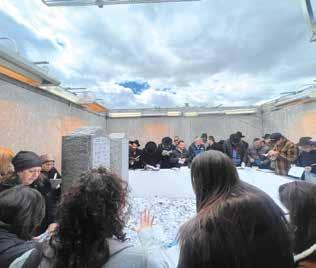


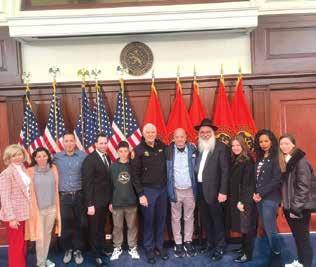

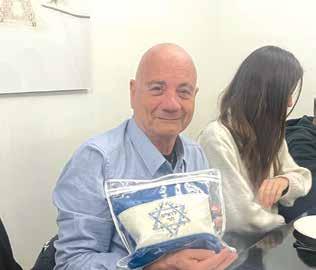




In a heartwarming display of compassion and purpose, a group of Ezra Academy girls embarked on a transformative journey to New Orleans, not only to lend a helping hand but also to discover the depth of their own spirits. This charitable mission, infused with the values of tikkun olam (repairing the world) and chesed (acts of loving kindness), aimed to build homes, nurture the environment, foster Jewish identity, and embark on a profound journey of self-discovery.
For these young volunteers, the trip to New Orleans was more than just a service project; it was an opportunity to connect with their faith, culture, and the wider world around them. As they rolled up their sleeves to assist in the construction of homes for families in need, they found themselves not only building structures but also forging bonds of solidarity and empathy.
Their commitment to environmental stewardship was equally commendable, as they engaged in activities aimed at preserving the delicate ecosystems of the region. Whether cleaning water barrels, priming water barrels or painting water barrels after being educated on the importance of the work, these young women demonstrated a profound respect for the environment and a dedication to the preservation of the water projects around the levies in the Lower Nine.
Yet, perhaps the most profound aspect of their journey was the internal transformation each girl experienced. Through acts of service and moments
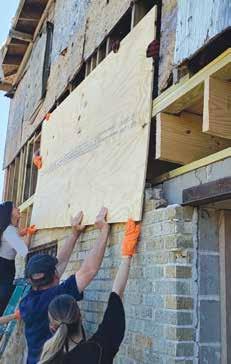
of introspection, they unearthed hidden strengths, discovered new passions, and deepened their understanding of themselves and their place in the world. In fact, their interactions with the members of the community and in particular Burnell, of Burnell’s market in the Lower 9, taught them the character trait of resiliency in ways they have never encountered before.
As they bid farewell to the vibrant city of New Orleans, these Ezra Academy girls carried with them not only memories of their impactful deeds but also a renewed sense of purpose and connection. For in giving of themselves, they found the greatest gift of all—their truest selves.


The second graders at HALB enjoyed a special trip to the Long Island Children’s Museum. They spent the day laughing and having fun with hands-on learning.


When will we make a bracha? Where will we hide the Afikoman? Who will find it?
This Pesach, along with baking matzah and tasting maror, the Pre-1A boys at YOSS ECC began their Haggadah activities with a lesson on diagraphs, and the first one was “Wh”!
Using our brand new upgraded ReadBrite Reading Curriculum, Hilary Newman, our curriculum coordinator, has inspired our Pre 1Aers to strengthen their reading, writing and handwriting skills.
Up next on the cutting board of diagraphs will be shredding maror and chopping apples for charoses.



What a week it has been at the Five Towns FM Home Loans Flag Football League. Week #4 was truly incredible. The boys were so excited to come back and play!
The first grade division had a lot of fun catching the ball and playing with their friends. In the second grade division, the Jets beat the Eagles, the Vikings beat the Giants, and the Broncos beat the Patriots with some awesome flag pulls by Dovi Zelman. In the third and fourth grade division, the Patriots beat the Dolphins, the Packers beat the Panthers, the Broncos beat the Vikings, the Giants beat the Eagles, the Steelers beat the Falcons, the Seahawks beat the Jets, and the Raiders beat the Saints led by Shua Williams who had three touchdown catches. Shua’s dad, who is a veteran coach in the 5 Towns Flag Football League, really was
Did you know?
excited about this win. In the fifth and sixth grade division, the Seahawks beat the Jets, the Broncos beat the Packers, the Raiders beat the Giants, the Panthers beat the Patriots, and the Steelers beat the Dolphins with some great flag pulls by Zevy Polakoff. In the seventh and eighth grade division, the Jets beat the Eagles, the Vikings beat the Giants, and the Patriots beat the Broncos led by Dovi Fruchter with an incredible touchdown catch. Week four was unbelievable! We can’t wait to see everyone on the field next week!
Sportsmanship of the Week Award: 1st: Zev Tepper; 2nd: Aryeh Rosenberg; 3rd and 4th: Eli Heimlich; 5th and 6th: Yaakov Schattner. All standings are now posted at www.5townsflagfootball.com.
Al Weider earned a place in the Guinness Book of World Records by tossing a horseradish root 80.5 feet in the air.

For the ninth year in a row, patients at both Northwell Health’s North Shore University Hospital and Long Island Jewish Hospital will enjoy Pesach Seder packages that were beautifully crafted by the families of the Young Israel of West Hempstead.
“Our sisterhood created the #Giveback Sunday as a way to do chessed for the larger Jewish community,” explains Kari Levine, former Sisterhood president. “It’s one of our most popular events.” This year, close to 100 children, along with their moms and dads, participated. “Over the years, we have gifted nearly one thousand packages to local hospital and nursing home patients,” Levine said.
As families arrive at the event, they are handed a drawstring bag. Inside are all the supplies needed to create a Pesach package, including a kiddush cup, electric candles, haggadah, matzo cover, seder plate, and afikomen bag. This year, it also included a bookmark and greeting card with Israeli motifs, in honor of our brothers and sisters in Israel. (The cards were designed by Ann Koffsky in memory
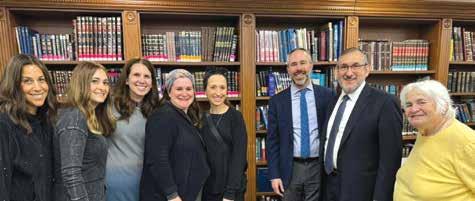
of Adira Koffsky, a”h.)
Families then bring their kits to tables that are teeming with craft items, like markers, glittery stickers, gems, dried pressed flowers, ribbon, tassels…and get to work! They decorate each item with their own, personal touches. By the time they are done, each package is a work of art, made with love.
Ayelet Mottahedeh, a chairperson of the event, explains that she chose to bring all four of her young children to the event because it’s “a fantastic way to teach my children the importance of giving back.”
Plus, they each loved the art projects, too.
“This event is so perfect for me to bring my kids to help out at,” Jen Toplan, another event co-chair, added. “I want to teach my kids to think of others, and this event helps me show that in action.”
Rabbi Dr. Hillel Fox, Chaplain of the North Shore University Hospital in Manhasset, agrees, “It warms my heart to see so many families volunteering their time to decorate religious articles for the Jewish patients.” He thanked the crowd saying, “Your kindness will bring smiles, comfort and joy to sick patients who are

hospitalized over Passover.” Fox accepted the packages on behalf of Northwell Health’s North Shore University Hospital, as did Dr. Ellen Cn for the LIJ Valley Stream hospital.
“It’s a chessed event that doesn’t feel like a chessed event,” says Meira Levine, age 16, “You get to spend time with your family, have fun being creative, all while doing something good for someone else.”
Everyone also got to enjoy a refreshing cup of Rita’s ices on their way out.
“It’s a win-win!” Meira concludes.






At a time when Jewish public school teens are grappling with relentless antisemitism and anti-Zionism on campus, Jewish Student Union (JSU) culture clubs in their schools have served as their literal safe havens, by helping students to cultivate a strong sense of Jewish pride and equipping them with the tools to respond to anti-Jewish and anti-Israel incidents both in and out of school.
A program of the Orthodox Union’s NCSY, JSU is a network of after-school Jewish culture clubs for North American Jewish students in public schools and non-Jewish private schools. JSU staff engage over 17,000 teens at 316 schools across the country in meaningful discussions, education and celebrations centering on Judaism and Israel, and help interested teens to develop relationships with their Jewish heritage, identities and values. JSUs are open to non-Jewish students as well, with the goal of fostering an understanding of, and allyship with, their Jewish peers.
Since October 7, 30 new JSU clubs have launched across the U.S. alone, including eight in New York and New Jersey, where JSU impacted 6300 teens in 2023, a 40% increase from 2022.
Sofie is president of her high school’s JSU. The East Meadow, New Jersey, resident says that JSU is the one place in her school where she feels most comfortable and safe.
“Because of the daily antisemitism at my school, it’s such a great feeling to be able to walk into a space where everybody is accepting of our Judaism and our religion,” she says. “Everybody there attends for the same reason; to find a Jewish community.”
In her leadership position, Sofie has brought in staff from Stand With Us and
other organizations to inspire JSU members to take pride in their Judaism and support of Israel. Sofie was also among the featured speakers at a November rally for Israel held in Long Island.
“The antisemitism I encountered at school was the reason I decided to speak out,” she says. “Even at a young age, it’s never too early to start making a difference. I feel it’s my responsibility to be that voice for the Jewish people. Just like all students from different backgrounds deserve to learn about their homelands and where they came from, as a Jewish person, I deserve to learn about, and feel the same sense of respect, for Israel.”
Earlier this month, Sofie and fellow JSU teens everywhere were celebrated for their courage and resilience, at New York and New Jersey NCSY’s Evening of Strength. Held at a hall in Lawrence, New York, and chaired by Rabbi Dov and Rina Emerson, and Jeremy and Dana Frenkel, the gala dinner also honored esteemed community pillars David and Stephanie Sokol of Woodmere, New York; Rabbi Aryeh and Yael Wielgus of Bergenfield, New Jersey; and Rabbi Tuvya and Sara Fried of Far Rockaway, New York, for their dedication to NCSY.
Dalia Sokol describes her parents, David and Stephanie, as “the Avraham and Sara of hachnasas orchim”; continually hosting people for Shabbos and holidays and trying to bring others closer to Hashem.
David and Stephanie became enamored with TJJ (The Jerusalem Journey, JSU’s summer program) for Moms — an eight-day Israel trip where participants connect to the land, to their Jewish values, and to one another — after they attended an NCSY Shabbat of Inspiration dinner at Young Israel of Woodmere. The two were so inspired by the event and the
women they connected with, that they decided to become actively involved with TJJ.
From reciting Modeh Ani with women daily, to accompanying them to the mikvah — a highlight of Stephanie’s involvement — and connecting nightly on Zoom to daven for Israel, Stephanie says she draws tremendous chizuk from her new TJJ friends.
“Seeing mitzvos that we do all the time through the eyes of someone experiencing them for the first time, is the most inspiring, awesome thing to watch,” says Stephanie. “There’s nothing like it.”
Young Israel of Woodmere’s Rosh Bais Midrash and Yachad Rabbinic and Halachic Advisor Rabbi Shay Schacter has observed TJJ for Moms develop over time, and credits the Sokols with helping the program to flourish.
“It is amazing to see the inspiring leadership of Stephanie and all of her friends, and of course of David and the entire family, who go along with everything that TJJ for Moms represents,” he says. “The Sokols welcome participants into their home and include them in every aspect of Jewish life.”
Former NCSY New Jersey Regional Director Rabbi Aryeh Wielgus is known by his colleagues for his passion, authenticity, spontaneity and “crazy schemes.” One summer, an organization called Athletes for Israel brought the Auburn Tigers, a Division 1 basketball team from Alabama, to Israel, to play against the country’s national team. Filling the stands at their biggest game were 400 NCSY Kollel participants, whom Rabbi Wielgus had brought in to watch. The yeshiva boys, he recalls, garnered more attention at the live broadcast than the basketball players.
That fall, Rabbi Wielgus created a tournament and Shabbaton in Auburn,
Alabama, for more than 120 yeshiva day school student athletes. The group also attended an Auburn Tigers home game in appreciation to Auburn Tigers’ Coach Bruce Pearl for his support of the Jewish People.
Rabbi Wielgus is most proud of overseeing the creation of NCSY’s 4G (For Girls) program, which caters to a broad spectrum of Modern Orthodox and Bais Yaakov high school girls. The success of the initiative, he says, surpassed everyone’s wildest dreams.
Rabbi Wielgus and Yael agree that their entire family has been shaped and enriched by their involvement with NCSY.
“The organization is everything to us,” says Rabbi Wielgus. “It’s where our family got started, it’s where our career began, but most importantly, it’s where we met so many amazing teenagers and staff who continue to inspire us every day.”
“Participation in NCSY will change your life,” adds Yael. “We will hold on to these feelings forever and look forward to continuing our involvement in whatever capacity we can.”
NCSY Managing Director Rabbi Moshe Benovitz says the couple have impacted more people than almost anybody he knows in the world of NCSY.
“They do it out of their incredible capacity for love, generosity and ability to connect to such a wide variety of people, with a goodness of spirit and energy that is absolutely contagious,” he says.
Rabbi Tuvya Fried has been a dedicated, driving force in NCSY for 22 years, seeing past people’s appearances and into their neshamos as NCSY’s Great Neck Educator. For decades, he and Sara opened their home to dozens of NCSYers who became part of their family.
Brought to you by Comfort Health
My five-year-old son, Chaim, refuses to ride a bike or play with other boys his age and clings to me whenever we are outdoors.
Are there any coping skills I can teach him to help him be less anxious and learn to take age-appropriate risks?
Dr. Chassia Boczko, a well-known


child psychologist in the Five Towns specializing in treating children with ADHD and anxiety, responds:
Definitely! As a parent, there are many skills you can teach your child to help him cope with difficult feelings. Here are a couple of practical tips to try:
1. Set a Goal
Help your child identify a goal he’d like to work on. For example: I want to learn to ride my bike down the block without Mommy right next to me. Identifying the goal makes it easier to work on.
2. Educate
Educate your child about their feelings, in age-appropriate terms. In my practice, we have names for the different parts of the brain. There’s Smarty — the prefrontal cortex, responsible for knowledge and rational thought — and then there’s Amy — the amygdala, cheerleader of emotion, who may sometimes overreact. When your child understands what

In honor of the upcoming solar eclipse, coinciding with Parshas HaChodesh and Rosh Chodesh Nissan, Rabbi Ahron Friedler enlightened his classes with a fascinating demonstration of the rotations and revolutions of the moon and its orbit.
The class was able to witness how and why the phases of the moon change throughout the Jewish month and why a solar eclipse is a rare phenomenon. Understanding when and why Rosh Chodesh occurs is key to realizing that a solar
their anxiety is, and that it’s a normal part of their body, it may lower the intensity of the feeling.
3. Name
Help your child name their feeling. When it has a name, you can “boss it back.” For example, your child can say: “Worry, I see you’re here now, please go away.”
4. Break it Into Smaller Steps
Take apart the goal into small, manageable pieces that your child can reach one at a time. Success builds on itself — each small goal will propel your child forward to the next step, i’yH.
Still concerned?
To find out if Comfort Health services for children with emotional health challenges can benefit your child, reach out to our Five Towns intake team at 718-4085400 ext. 452 or via email at intake@ comforthealthny.org.
Submit your mental health-related questions to be answered in a future column: info@comforthealthny.org.

Comfort Health services include at-home respite, care management, and parent support for children with emotional health challenges and their families. Comfort Health is a division of Hamaspik of Kings County. Services are covered by insurance.



eclipse can only occur either on erev Rosh Chodesh or on Rosh Chodesh itself.
The fact that this solar eclipse will oc-
cur on erev Rosh Chodesh Nissan, which bridges the two months of Geulah, will hopefully be a sign for us of the impend-

ing ultimate Geulah and bring to all of Klal Yisroel true freedom – a Zman Cheirusainu.
Yeshiva University hosted an event this past Sunday night and invited the MTA family to attend as well. It was an evening of Unity, Solidarity and Song, and featured the Goldberg-Polins and released hostage Luis Har, among other speakers.
The program was open to students in YU and Stern, faculty, parents and friends of the Yeshiva. Those who attended from MTA felt the significance of the night and found it truly moving.
The Goldberg-Polins both spoke about the hakaras hatov they have to the YU family for their unwavering support, tefillos, advocacy, chesed missions to Israel and the everyday Torah learning that takes place at the Yeshiva. One would expect that the people in attendance would

be the ones to bring them chizuk, but it was so much more than that. Rachel and Jon, despite the unimaginable pain and suffering they are experiencing as their child Hersh is being held hostage by Hamas, are pillars of strength, and ended up giving tremendous chizuk to all who were there.

It was also extremely inspiring to hear Luis Har’s story from the moment he was taken captive to the moment he was freed on day 137. Shortly after his release, Rabbi Shay Schachter helped him bench gomel remotely to a packed Gleuck Beis Medrash, and on Sunday, Luis went to the Beis Medrash and danced with the
As I pen these words, two weeks from today, the great yom tov of Pesach will be upon us. We will have already experienced the Seder and with that we will have said, “Kol dichfin yasai v’yachol, a declaration that all are welcome to join.” It is always so intriguing that we have already sat down to the Seder and made kiddush...then we utter those words to invite those who may “need” a place?
I don’t have a good answer and have never received a satisfying one. But what I’d like to suggest in this short snippet is that tremendous bracha comes when one person to another person (not an organization!) reaches out to each other, that is because it is a quintessential explanation of nosei b’ol; putting oneself in another’s situation.
Continued from previous page 64
Described by his colleagues as a coach, athlete, mashpia, rebbe, and person who is willing to take on any job at NCSY’s Camp Sports, Rabbi Fried first influenced NCSY Camp Sports Assistant Director Rabbi Dani Cooper in 1996.
“I was a camper then, and I remember my first time meeting him in the Bais Midrash, seeing his fire and the look in his eyes when he learns and interacts,” recalls Rabbi Cooper. “It made me realize
At this time of year, probably the most hectic holiday preparation – Pesach cleaning, spring cleaning, clothes shopping, grocery shopping, cooking, baking etc. – there are those that unfortunately don’t have those preparations because those people find themselves alone. Perhaps the pain of loneliness is something so big and hard to describe to those who experience it and it is one of the most difficult experiences a person can have. Perhaps the worst part of pain and suffering is the feeling that we are alone in our suffering. Aloneness may take up as much space and time as someone overwhelmed with their yom tov preparations. But their pain won’t allow them to reach out to you to extend their hand to be of help although they’d like to feel included and would love to feel part of your preparations. As long as we feel that we are together with others, we can overcome anything.
Rabbi Simon Jacobson explains, “You can’t necessarily tell that someone is lonely, but when you reach out to help him or her, he or she might open up to you. Whether you are offering support and advice, or you are lending a helping hand, just reach out to other people. Talk to your neighbors. Say hello to someone for no reason. We repair the world through baseless kindness.”
When someone invites another person – and then that guest never hears from them – it gives that guest a certain image of not caring. Those are the facts, but there are small subtle ways that one can make another feel included and welcomed even if the invite isn’t forthcoming or cannot be for any reason. A simple good Shabbos/yom tov call goes a long way. A little pre- Shabbos/yom tov gift is huge! And a during the week call/walk/ coffee, etc. is precious to the recipient!
Each month, Rebbetzin Feiner’s Rosh
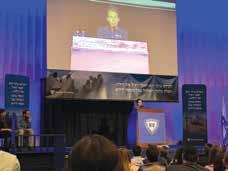
talmidim and Rebbeim.
It is such a privilege for MTA to be able to benefit from the meaningful programming that Yeshiva University arranges and is one of the benefits that make YUHSB so unique.
Chodesh shiur begins with a getting-toknow-you fun activity so that we can better pay attention to those we see in shul to befriend and create an aura of warmth and family, so that the pain of aloneness can be alleviated, even for that short time.
In the White Shul, our special Rebbetzin reaches out to just about every member (and it’s a large congregation!) to find out what their Pesach plans are. Our goal here at Be My Guest is to ensure that no person is made to feel alone. To reiterate, a tiny gesture of kindness goes a long way and although may not be articulated, the gratitude is deep.
The original kickoff shiur by Rabbi Paysach Krohn, shlita, can be heard on Torah Anytime, https://www.torahanytime.com/#/lectures?v=271912 . For comments, feedback, suggestions or to get involved and become an ambassador in your Shul, please email Bemyguest@ whiteshul.com.
that there was a way to go in terms of my own fire, my own passion. He continues to have that fire.”
NCSY Great Neck Director Rabbi Jonathan Zar sees Rabbi Fried as someone who always steps up to the plate: “A student of mine attended Camp Sports and he developed a connection with Rabbi Fried,” he recounts. “Once the student returned home, he wanted to start a regular class for himself and some friends. Rab-
bi Fried immediately offered to teach it. That shiur ran for close to 10 years, and was attended by hundreds of teens, entirely because of Rabbi Fried.”
The Frieds see NCSY as a wonderful tool to educate teens and contribute to their religious growth and inspiration.
“NCSY is so important to us and to all of Bnei Yisrael because it connects our youth who are not affiliated with their Jewish roots in a very emotional way,”
says Rabbi Fried. “NCSY does something that no one else can do with teenagers; it gets them to love Torah and mitzvos. That’s the magic of NCSY.”
The gala included entertainment by IDF paratrooper Sergeant Major Noam Buskila, a singer serving on Israel’s northern border, and an address by New York and New Jersey NCSY CEO Rabbi Gideon Black.

MTA is excited to announce the hiring of alumnus, Rabbi Yehuda Balsam (‘94), as Rebbe and Rosh Beis Medrash of the yeshiva, beginning September 2024.
Rabbi Balsam has served as a Senior Maggid Shiur and Rebbe par excellence at DRS Yeshiva High School for over 20 years. During the summers, he serves as a member of the Rabbinical Staff in Morasha Kollel.
An inspiring and relatable talmid chacham, Rabbi Balsam is also a mechaber sefarim and a dynamic mechaneich, who is now poised to become one of the many faces of Talmud Torah at YUHSB.
Rabbi Aryeh Lebowitz, one of the Roshei Yeshiva at YU & Director of Semicha at RIETS, describes Rabbi Balsam as a “first-rate talmid chacham, whose wisdom is only surpassed by his humility. He has an extraordinary ability to connect to talmidim of all levels and ages and to elevate their learning. As a close friend and former colleague of his, I have no doubt that Rabbi Balsam will seamlessly integrate into MTA’s already excellent team of talented rebbeim.”
In his new role at MTA, Rabbi Balsam will deliver daily shiurim in Gemara

Rabbi Konigsberg with Rabbi Balsam, giving him his first MTA swag
b’Iyun, Gemara Bekiyus and Tanach, and have an opportunity to mold the talmud Torah that takes place in the Beis Medrash throughout the day. MTA Principal Rabbi Konigsberg says that “it is rare to find the perfect blend of being such a relatable Rebbi who is extremely knowledgeable and personable. With Rabbi Wiener making aliyah this summer, MTA has large shoes to fill. The yeshiva is fortunate to have Rabbi Balsam step in to fill the void.”
MTA is very excited for Rabbi Balsam, with his clarity, breadth of knowledge and creativity, to impart his love for limud haTorah onto their talmidim and place his unique stamp on all of the extracurricular Torah programming that takes place in the yeshiva. Everyone at MTA feels fortunate that Rabbi Balsam will be joining us full time at MTA and they look forward to his tenure as Rosh Beis Medrash.
Rabbi Balsam lives in North Woodmere, with his wife Chavie and their four children.
Did you know?
Horseradish has only 2 calories per teaspoon, so eat up!


Last Wednesday, the Union of Orthodox Jewish Congregations of America (Orthodox Union) hand-delivered 180,000 physical letters—all written in the past six days—to the White House demanding the release of hostages from Gaza. The press conference and delivery marked the 180th day of captivity for 130 hostages, including eight Americans.

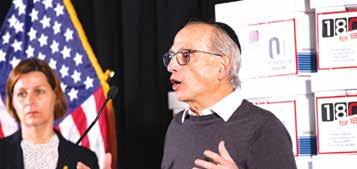
The letters call on President Joe Biden to support Israel materially and morally in its war to eradicate Hamas, combat antisemitism, and increase pressure to achieve the hostages’ unconditional, immediate release.
The Orthodox Union was joined by Maurice Shnaider, uncle of Shiri Bibas, who has been held in captivity with her husband, Yarden, and two young
children, Ariel and Kfir. Rachel Goldberg-Polin, mother of American hostage Hersh Goldberg-Polin, shared her emotional plea for her son’s release via video, and University of Maryland student Keren Binyamin spoke about the explosion of antisemitism on college campuses since Oct. 7.
Rabbi Moshe Hauer, Executive Vice President of the Orthodox Union, said,
Hindi’s Libraries, an international children’s nonprofit organization based in Long Island, is thrilled to announce a monumental achievement in its mission to foster literacy among children worldwide. Since its inception in late 2018, following the untimely passing of beloved teacher Hindi Krinsky, the organization has diligently worked towards its goal of providing free new and gently used children’s books to those in need. Today, Hindi’s Libraries proudly shares the news that it has surpassed the distribution of 500,000 books, marking a significant milestone
in its journey.
With a passionate commitment to honoring Hindi Krinsky’s legacy and continuing her dedication to literacy, Hindi’s Libraries has tirelessly worked to make a positive impact on children’s access to books. Through strategic partnerships, community engagement initiatives, and the unwavering support of volunteers and donors, the organization has been able to reach children in diverse communities, both locally and globally.
“Reaching the milestone of distributing over 500,000 books is a testament to the dedication and hard work of every-

one involved in Hindi’s Libraries,” said Dovid Kanarfogel, Co-Founder at Hindis Libraries and former spouse of the late teacher. “We believe that every child deserves the opportunity to discover the joy of reading and explore the endless possibilities that books offer. This achievement motivates us to continue our efforts and expand our reach to even more children in need.”
Hindi’s Libraries operates with the core belief that access to books is a fundamental right for every child, regardless of their socioeconomic background. By providing free books, the organization aims to inspire a love for reading, promote literacy skills, and empower children to reach their full potential.
In celebration of this significant milestone, Hindi’s Libraries is grateful to announce a special initiative. An anonymous donor has generously pledged to match up to $500 raised, doubling the impact of contributions made towards the organization’s mission. This opportunity allows supporters to amplify their support and contribute towards providing even more books to children in need.
“We are incredibly grateful for the outpouring of support we have received from our community and beyond,” added Leslie Gang, Co-Founder of the nonprofit. “Together, we can continue to make a difference in the lives of children across
“Today, hundreds of thousands of members and friends of the American Jewish community stood together, asking President Biden for complete and continued moral and material support for Israel’s mission to finish the job of defeating Hamas.”

the globe.”
As Hindi’s Libraries looks towards the future, it remains steadfast in its commitment to serving communities and promoting literacy as a tool for empowerment and education. The organization encourages individuals, businesses, and community organizations to join in its efforts to create a world where every child has access to the transformative power of books.
For more information about Hindi’s Libraries and how to support its mission, please visit www.hindislibraries.org.





Students across HALB learned all about the solar eclipse, and on Monday, they had the opportunity to watch it while wearing their special glasses
It’s springtime at the Yeshiva University High School for Girls (Central), which means a flurry of much-anticipated events: Color War, Senior Seminar, Envision Shakespeare, and the spring sports season. But there’s one performance that has a special place in Central culture: the annual spring musical. This year’s musical is a classic: The Wizard of Oz.
The Central Playhouse, in collaboration with Envision Theater, put their own special spin on the show, which ran on Thursday, April 4. Senior Meirah Leban took the stage as Dorothy, who joins forces with the Cowardly Lion (senior Chani Weinberger), the Tin Man (junior Serah Tolchin), and the Scarecrow (senior Halley Bench) to follow the yellow brick road, meet the all-powerful Oz (senior Rachel Berkowitz), and avoid the Wicked Witch of the West (senior Atara Peretz).
The cast members agreed that the show was a labor of love: “Having the opportunity to be a part of the play this year has been such a privilege and a joy,” Meirah said. “We worked so incredibly
hard to learn and choreograph dances, paint sets, and memorize lines, and it was all such a whirlwind. We hope everyone enjoyed watching it as much as we enjoyed creating it.”
Chani agreed that the production experience was a formative one: “The entire cast was supportive of each other, and practices were always full of laughs. We put in a lot of work staying after school to put this play together, and were so excited to perform for everyone.”
Atara, a longtime member of Central’s performing arts cohort, said, “Working with all the different grades for the spring musical is definitely the highlight of the year.” She added, “It’s always a bittersweet moment when the show ends. There’s excitement that we finally did it, but sadness that it’s over.”
This year’s show was produced in collaboration with Envision Theater, an organization working throughout New York, New Jersey, and Pennsylvania to promote active arts learning in schools, camps, and community centers. Teaching artists work with groups to develop
This year’s HAFTR Mock Trial team had an amazing season. For the first time in three years, the team had student participation from every grade, filling the group with a special achdut, sense of community, diverse perspectives, and the ability for senior members to serve as positive role models. We also welcomed a spectacular new coach, Ms. Shoshana Wallach, who is a HAFTR graduate and former Mock Trial leader. With guidance from Coach Wallach, our hardworking team captains, Sara Wallach, Stephanie Marcus, and Sara
Hersh, and our dedicated faculty advisor, Mr. Kenneth Goldman, the team ran a season for the books. Beginning in October, the team met each week to learn new skills about how a trial works, what it means to be a lawyer or witness, how to approach public speaking, and how to make a convincing argument. Whether a student had a role in the trial itself or not, each team member learned valuable skills to help them in the rest of their high school journey and beyond.
With everyone’s hard work and commitment, the team made it past the Preliminary Rounds against Sacred Heart Academy and Great Neck South to the In-

theater, musical performances, dance, film, and more. The Central Playhouse was fortunate to work under the tutelage of Envision Theater Teaching Artist, Mrs. Mackie Saylor. Mrs. Saylor is also the current manager of Turnaround Arts: NYC, a program of The Kennedy Center and Exploring the Arts, as well as a collaborator with the NYU Verbatim Performance Lab. The Central Playhouse is unanimous in its gratitude for Mrs.
Saylor, who was a devoted director and mentor throughout the process.
“It has been such an honor to collaborate with the students, faculty, and staff at Central to produce The Wizard of Oz,” Mrs. Saylor said. “I am so proud of the cast and crew who have worked hard to showcase their creativity, talent, and passion for theater. There is no place like…Central!”

termediates against Clark High School, an endeavor that’s no easy feat. Although the team’s time together has now come
to an end, it was an amazing experience and an opportunity to learn, grow, and have fun.

This past Monday, students at HAFTR had a fun and educational experience watching and learning about the solar eclipse.
In STEM classes, students made model eclipses to learn about the scientific principles involved. At the same time, students discussed the religious significance of the eclipse with their rebbeim and morot.
The best part of the day was when classrooms viewed the actual eclipse, giving students the chance to view it in-

side through live-streaming, established indoor observation stations inside, and outdoor viewing areas were offered to provide an engaging experience – all with the necessary eye protection. As the eclipse reached its peak, students were captivated by the spectacle.
The eclipse encounter demonstrates HAFTR’s dedication to a well-rounded education. By integrating science and religious studies, HAFTR continues to inspire a love for learning and exploration among its students.
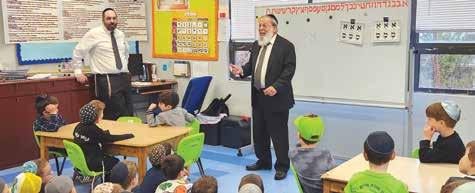

RThe Pre-1A boys took this idea to the next level as they dressed up as the tzaddikim who stayed up all night discussing Yetzias Mitzrayim!

Each week in HANC’s Elementary School in West Hempstead, the students and staff join together in the auditorium for the Rabbi Kelemer zt”l Shabbat Assembly. Singing, dancing, hearing meaningful stories and acknowledging the students who exhibit good middot are always included each week. This past Friday, Rabbi Ouriel Hazan, Head of HANC’s West Hempstead campuses, invited a very special guest to address the crowd. Mr. Dan Shmilovitch, who came all the way from Vancouver, Canada, is not only a HANC grandparent but is also Rabbi Hazan’s father-in-law. He came to share a very personal experience that he had just over a year ago and to show the children about how powerful one’s prayers can be to help save a person’s life.
Last January, Mr. Shmilovitch, a father and grandfather of ten grandchildren, was rushed to the hospital. In the course of determining what was wrong,
his heart stopped, and for three and a half minutes, two extraordinary nurses took turns administering CPR to restore his heart beat. They literally saved his life. It was then determined that he would require heart surgery, and the predetermined six hour surgery turned into a nine and a half hour ordeal. All across Canada and the United States, family, friends, and close to 2,000 school children all began to daven for him so that he should have a refuah shleima. After the surgery, the team of doctors were very concerned that he would not fully recover.
In the meantime, one of the HANC teachers, whose husband was on route to a famous rav and mekubal in Israel who is known for helping people achieve restored health, quickly texted him Mr. Shmilovitch’s Hebrew name. As the Rav read the list of names that were presented, he stopped and said, “This man should read Chapter 6 of Tehillim each
time he davens.” (Note: he did as was advised and still says that Perek of Tehillim every day as prescribed). In addition, through a friend of Rabbi Hazan’s who had a close connection to the Chief Sephardic Rabbi in Israel, it was determined that the name Refael should be added to his name to help bring about a full recovery. These and many other extraordinary occurrences led him back to restored health.
The students at HANC Elementary were particularly diligent about davening every day and including Mr. Shmilovitch’s name. As he looked out at the children in the room, he declared, “Your prayers helped me.” He then showed them a photograph on the jumbo screen of his wife, Sidney, and their three month old granddaughter, Nili. “On January 13th, our newest granddaughter was born. You changed the world for my wife and Nili and because of your prayers, Nili was able to meet her Saba. In the Talmud
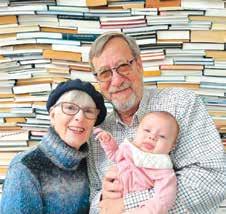
there is an expression that states, ‘If you save a life, it is as if you have saved a world.’ Would any of you wonderful students like to meet someone who saved a world?” As all of the students’ hands shot into the air he urged them. “Look around. Each one of you saved a world. You saved my world!”
It was a moving testament to the power of prayer that no one in the room will ever forget.
Ido Aharoni Aronoff, an Israeli diplomat, advisor to global companies and international relations professor, was named Global Distinguished Professor of Business at Touro University, Touro President Dr. Alan Kadish announced last week.
Aharoni Aronoff, who spent his entire diplomatic career in the United States, is a 25-year veteran of Israel’s Foreign service, a public diplomacy specialist, founder of the Brand Israel Program, and a well-known place positioning and branding practitioner. Aharoni has served as a Member of the Board of Governors of Tel Aviv University since 2015 and as a lecturer at the university’s Coller School of Management since 2018. He has served as a Global Distinguished Professor for International Relations at New York University and was Israel’s longest-serving Consul-General in New York, with the rank of Ambassador, serving in that role from 2010-2016. In recent years, Aharoni Aronoff has served, in advisory capacities, several global companies, such as Libra Group, MasterCard, APCO, Value Base, Bank Leumi USA, Perion Network, and others.
“Professor Aharoni Aronoff has
wide-ranging professional experience in the spheres of government, diplomacy, public service and branding and we are thrilled that he’ll be bringing his many talents and skills to Touro to benefit our students and faculty,” said Dr. Alan Kadish, Touro President.
In his new role, Professor Aharoni Aronoff will teach the practice of business diplomacy and non-product branding to both undergraduate and graduate students and will represent Touro in public forums.
“Touro University is known for its ability to provide real-world, hands-on training and skills to help its graduates join the workforce and have meaningful careers to benefit society. Touro has made great contributions to the field of healthcare and medical education and now it is focusing on business administration. I welcome the opportunity to share my marketing expertise with the students at Touro. Having been in the public sphere for over 35 years, I expect to share my practical experience overseeing Israel’s largest diplomatic mission worldwide as well as my experiences branding Israel and consulting with numerous international corporations,” said
Aharoni Aronoff.
Aharoni Aronoff established Brand Israel after 9/11 when there was a great need to build a strategy to celebrate Israel’s creative spirit. Today, and more so post 10/7, social media is disrupting the way people all over the world process information, according to Aharoni Aronoff. “The algorithms design a conversation that is binary, or black and white. People crave simplicity at the expense of dealing with complex issues. They feel compelled to express an opinion on issues, sometimes they know nothing about, and to ‘signal’ they are on the so-called ‘politically correct’ side of every topic. It’s become very hard to have nuanced conversations. The best example of that is ‘cancel culture’. If I can’t deal with what you’re saying, I don’t listen to you, I shut down, ‘cancel’ you and, indeed, there’s been a serious effort to ‘cancel’ Israel in the wake of October 7,” says Aharoni Aronoff.
Aharoni Aronoff believes education is the answer.
“As the largest institution of higher education under Jewish auspices, I believe in Touro’s ability to contribute to and influence that sphere and to provide

students with the tools to interpret and apply knowledge. We can educate about history and the complexity of the situation. Right now is a great time to step up these efforts, as there is such a dire need for nuanced conversation. I’m very excited for the opportunity to be part of Touro University, when there’s a greater role for Touro to play in academia, Jewish life, and the connection with Israel. I see myself as part of that bridge between Israel and the American Jewish community and it’s an honor and privilege to join Touro and help make a difference for our students and the larger community.”
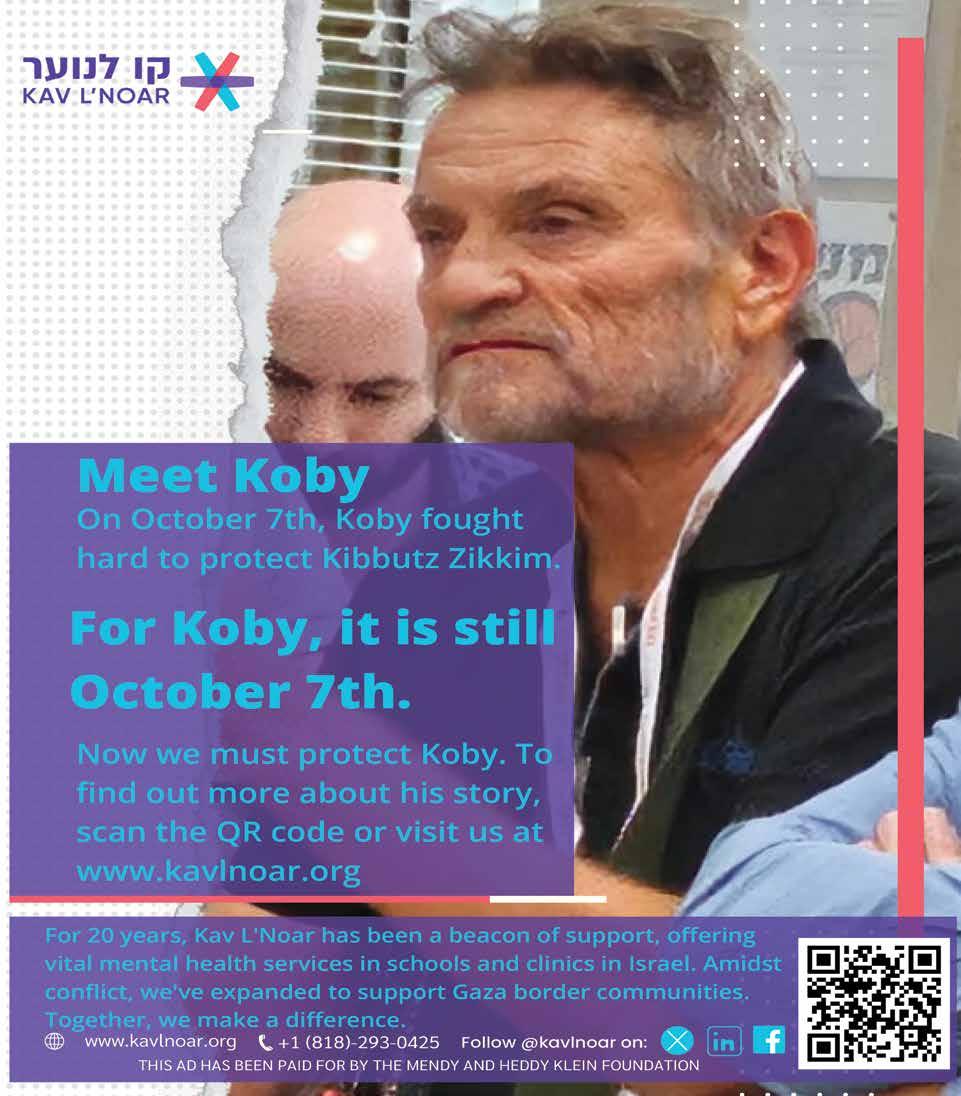
The weather was poor all week, but yet again, the sun shone bright this past Sunday for the Opening Day of the regular season at 5TLL by FM Home Loans! All the boys received Wieder Orthodontics baseball keychains and the incredible volunteer coaches received special coaches bags and polos in appreciation of their amazing dedication and work.
K/P Baseball & Soccer Highlights
K/P Baseball: Yosef Pollack smacked two home runs out of the park, while Dave Erez showed off his glovework at shortstop for Rita’s. Dovid Goldman and Yeruchem Moshayev played excellent defense.
K/P Soccer: Ben Galler & Akiva Jaspan did not stop all game, hustling hard for Maidenbaum in their great game against Wieder Orthodontics. Gabriel Sipzner and Mordy Zauderer played really well for Team Hamaspik in their game versus Tikva Fire.
1st/2nd Soccer: Maidenbaum led by Ari Kabacznik and Josh Halpern scored 3 goals and shut out Tikva’s offense to earn the victory. Wieder Orthodontics and Nojo Promo engaged in a tough defensive battle that ended in a 0-0 tie.
Minors (1st-3rd) Baseball Highlights
1st Grade: Moshe Sinnreich made a catch that lit up the field like Mittman Electric, leading them to a huge 17-7 win over The Jewish Home. Akiva Reisz was a home run hero for Marciano Pediatric Dentistry in their dramatic 19-18 victory over Barbacoa. Shlomo Wieder’s opening home run for Elegant Lawns was like planting the seeds for a beautifully land-
scaped win over Spray Foam Insulation.
2nd Grade: In a face-off between Graze and Wieder Orthodontics, Graze’s defense was grazing on greatness, with Shmuel Berger making a leaping catch to secure the win. John’s Automotive cruised past Town Appliance with Aryeh Rosenberg’s great plays and Shimon Muller’s defensive magic.
3rd Grade: Dovid Talansky’s deep homers were like precious gems, leading Molly’s Jewelers to an 18-11 win over Target Exterminating. Asher Kamenetzsky’s acrobatic catches were the talk of the diamond as 5TownsCentral extinguished any hopes of a comeback by Wieder Orthodontics. Binyomen Grinberg’s triple for CG Flooring was the floor plan for success, and Shmulie Sitzer’s diving catch was the highlight reel play of the week, securing their 6-4 win over BayRock Insurance.
4th Grade: Cheskiel Leiner was on fire with four hits and seven RBIs, leading Tikva Fire to a scorching 14-3 win over Bathtique. Shua Greenberg’s pitching for Newman Dental was as solid as a freshly filled cavity, securing their 8-3 victory over JNT. Azi Mendelowitz’s impressive performance for Newman Dental included a three-run homer, two singles, a double, and defensive plays that were as sparkling as a set of freshly polished teeth.
5th Grade: CG Flooring floored the competition by scoring an incredible 25 runs in their Sunday showdown. Yehuda Lifshitz pitched like a pro, weaving his magic on the mound to guide NY Custom Closets to a well-deserved victory over


Marciano Pediatric Dentistry. DOMA’s bats were blazing hot, as they circled the bases a whopping 18 times en route to their triumphant win.
6th Grade: Mordechai Markowitz’s game-tying grand slam fueled Maidenbaum’s thrilling 13-12 victory over Carving Block. Wieder Orthodontics flashed their winning smiles as they triumphed over Sliced with a solid 9-4 victory on the field.
7th/8th Grade: Yitzchak Weiss’s strikeouts were like a well-executed root

canal, stopping Bathtique’s comeback attempt as Wieder Orthodontics secured a 6-3 win.
In the Opening Day game of the week, Signature Coverage staged a remarkable comeback against Elegant Lawns. Down 16-12 in the final inning, they rallied, and Avi Pellman knocked in the tying run. With Chezky Osina on 2nd, Avi Gelnick ripped a line drive into the outfield that scored Osina, ensuring the victory for Signature Coverage.

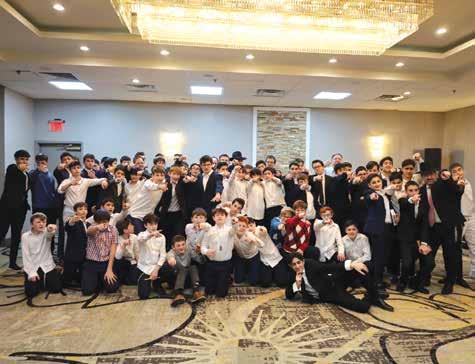
The YCQ seventh and eighth grade boys Shabbaton was a spectacular success, featuring unparalleled levels of ruach, inspiration, and camaraderie.
On Friday, students arrived at the gorgeous Quibbletown Park in Piscataway, New Jersey, for an afternoon of sports with their friends and rebbeim. They then journeyed to the nearby Holiday Inn, their destination for Shabbat, for a swim in the beautiful indoor pool. After getting ready for Shabbat, they participated in exciting “Pre-Shabbat Ruach” with singing and dancing. The energy continued throughout tefillah with a musical Kabbalat Shabbat.
During the Friday night seudah, divrei Torah were given by Chaim Peled and Yosef Haim. After dinner, students broke into small learning groups with their rebbeim. The ruach level stayed strong throughout the night with a “Schnitzel Extreme” show hosted by the Schnitzel Guys. The night wrapped up with some structured downtime for students to spend quality time with one another.
Shabbat morning kicked off with tefillah and a kiddush, followed by an engaging and entertaining trivia game, featuring questions about Torah and sports written by Rabbi Bernstein. A delicious lunch followed that featured divrei Torah from Eli Samet and Mikey Fried.
An unbelievably inspiring talk by Yitzy Haber of the Schnitzel Guys came next, which blew away the students and faculty. Yitzy was unfortunately diagnosed with cancer as a child which resulted in the amputation of his leg. Nevertheless, he remains one of the happiest, energetic, (and physically active!) people you will ever meet. Yitzy’s story is absolutely remarkable and made a lasting impression on everyone.
Mincha and a meaningful seudat shlishit, which included divrei Torah from Dovid Kopstick, Josh Gadol, and Eitan Berkowitz, wrapped up Shabbat, but the Shabbaton was far from over. After Havdalah, the ruach train was full steam ahead, with a musical melave malka featuring more singing and dancing. A tremendous amount of hakarat hatov must be directed towards Mr. Jacob Grossman, the Director of JHS Student Life and Activities, for organizing the best Shabbaton to date. Thank you to the alumni advisors, Rabbi Landsman, Rabbi Knapp, Rabbi Nat, Rabbi Greenberg, Rabbi Howitt, Rabbi Kravetz, Rabbi Steinberg, and Rabbi Bernstein (and their families!) for their efforts and for enhancing the weekend with their presence. It is thanks to them, as well as Mrs. Fishman and the business office staff, that our Shabbaton was so successful and truly one of the highlights of the year.






The 5 Towns Girls Hustle and Heart Basketball League just finished another amazing season! The girls in each division are learning the fundamentals of the game, learning to work together as a team and having so much fun while getting a great workout! Our energetic high school and college/adult coaches and refs are doing a
great job teaching the girls the skills and the rules of the game while still enabling the girls to have a fun experience every week. The Girls Only basketball league is in its ninth season and is run for girls from fourth to ninth grade.
The league was sold out last season, and we are looking forward to the next season beginning in September.





In today’s day and age, as many people are increasingly dependent on technology, Mesivta Netzach HaTorah has gotten its talmidim to step away from their phones. In the 30 weeks since Elul, the Mesivta had nearly 100% student participation in its Phone Incentive Program, which resulted in a clear increase in both the quality and quantity of the learning by the Mesivta talmidim.
The program is a tremendous commitment, and as we echo the sentiments of sur mei’rah v’asei tov, the talmidim do not only abstain from various phone activity, but they actively commit to ex-
tra learning over the duration of the program.
We are now at the incentive portion of the program, the 4-day trip to Orlando, where the talmidim are learning with their rebbeim and their shiur, as well as enjoying many extra-urricular activities. Baruch Hashem, the Phone Incentive Program has had, and continues to have, a tremendous positive impact on the bachurim, and enlightens them to the benefits of joining a program of this kind. To quote one of our talmidim, “This program is the glasses I needed to see life.”
The JSL 2024 Winter Hockey Championship sponsored by Molly’s Jewelers took place last Tuesday night! The gym was packed, and excitement gripped the FM Home Loans Arena as the top teams in 3 divisions matched up to take home the ship!
SDF Architect and Target Exterminating of 2nd/3rd Grade led off the night! Shmuel D. Flaum, the owner of SDF Architect, was in the building and sponsored personalized water bottles and towels for each of the boys on the team. Energized by their sponsor being in attendance and the amazing swag, SDF came out strong, scoring 4 goals to Target’s 2 heading into the final minutes of the game. Target managed to get one past Championship MVP Shaya Ribowsky to cut the lead to 1 but Shaya and SDF’s defense was locked down in the end, handing Shmuel Flaum, SDF Architect and Head Coach Doniel Pearlman the incredible victory!
In 4th/5th, the top two teams in the


The third graders at Shulamith showcased their incredible talents under the direction of Mrs. Rina Hirsch while learning about their roots in this year’s performance of Finding Our Roots: A Journey Home. With songs about our love and connection to Eretz Yisrael, the third grade will always remember: “No matter where we live now, no matter what is in our past, our journey will lead us HOME!”

division, Marciano Pediatric Dentistry and Town Appliance faced off and the two teams battled it out to start but Town Appliance pulled away after Netanel Biegacz sniped a shot from near half court and Binyomin Tennenberg unloaded with some incredible wrist shots. Championship and Season MVP Daniel Treuhaft was calm and graceful in net, shutting down all the late, desperation shot attempts from Marciano, giving Town Appliance & rookie Head Coach Eli Skaist the decisive win! The victory gives Town Appliance yet another championship tro-

phy to add to their massive trophy collection on display in their Central Avenue office!
In the final game of the night, 925 Sterling, the top seeded 6th-8th grade team, faced off against Wieder Orthodontics, who were coming off of one of the greatest JSL finishes of all time in the semi-finals! Led by Championship MVP Yaakov Levine and Dovid Balter, 925 Sterling dominated all night and Wieder’s powerful offensive attack was completely shut down by goalie and 925 Sterling’s owner’s son Dovi Holzberg as 925 Ster-
ling and the veteran and legendary Coach Charles Levine took home the Championship trophy! It was another incredible season. The league thanks all of the sponsors for their support, especially the league sponsor FM Home Loans, as well as the MVP Sponsors Maidenbaum, Island Roofing, Wieder Orthodontics, and Town Appliance! The next JSL season begins in September but there is 5TLL baseball for the spring so stay tuned for the highlights here, in TJH, each week!
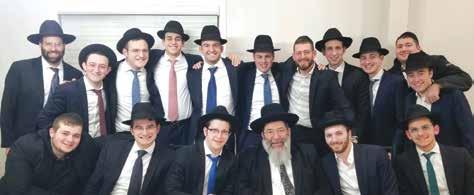
A seudas preidah for the third year talmidim of Yeshiva Darchei Torah’s Beis Medrash Heichal Dovid who are heading to yeshivos in Eretz Yisrael after Pesach, with the participation of Rav Yaakov Bender, Rosh HaYeshiva (seated, center), was held at the home of Rav Avrohom Bender, a menahel in the elementary school (standing at left).
Each bachur spoke about what he gained from his years at the Yeshiva.

As part of a new Chaver Tov initiative, where the talmidim work on their bein adam lechaveiro skills, Rabbi Gardenswartz’s third grade class at YOSS earned an amazing prize, a delicious ice cream party!
Their hard work in this point-based reward system is extremely important and earns fantastic class-wide incentives. We are very proud of their accomplishments in bein adam lechaveiro and IY”H they will only continue to grow!

On Monday, HANC Middle School sent five teams of students to compete in the CIJE (Center for Initiatives in Jewish Education) Inter-Yeshiva annual Vex Robotics Tournament at the Port Washington Armory. Over the course of the school year, each team built a highly sophisticated robot with a large arm that can be manipulated into several positions. Nine tournament fields were spread throughout the room, and each team participated in seven matches.
At each field, teams would navigate their own robot through a maze of objects, retrieving objects, and moving them to designated places on the field.
All of our teams performed well and enjoyed a healthy competitive atmosphere with the teams from other teshivot. It must be noted that the team of Nili Brukner, Noa Kaye, Shayna Wunder, and Ariella Leibowitz, ranked fourth out of the 117 teams competing!



Dear Rabbi Katz, Jack Forgash, and Steve Adelsberg, Since Simchat Torah, October 7, we have had the privilege at Just One Life to provide financial support to more than 475 families through our Project Chai, from cities including Sderot, Ashdod, Ashkelon, Eilat, Haifa, Tel Aviv, Kfar Maimon, Kiryat Shmona, Ofakim, and multiple kibbutzim.
Many families in the South of Israel have been able to return home recently, although adjustment has also been difficult for them. We are also still providing support to families from the north who remain evacuated with no return date in sight.
This week we received a referral for a young woman, Shira A, whose husband was killed in Gaza, leaving her to care for a newborn baby. Unfortunately, this is not a unique situation. We have received and are supporting multiple war widows with babies.
Sadly, this is the reality for many families, dealing with overwhelming sorrow and fear in every aspect of their lives.
Every year we launch a Pesach Tzedakah fund for a small group of our families that are really struggling. This year, I truly hope we will be able to expand the amount we can give out so that many families who are still evacuated and find themselves away from home for the holiday can continue to receive financial aid to alleviate some of the pressure. Additionally, we aim to support some of the many young moms who need to prepare for the holiday while their husbands are still away on the battlefront.
Since my time with Just One Life, I have never experienced such dire need. These past five months have been the most emotionally intense period of work any of us have ever experienced. On top

of daily struggles, the war has impacted every aspect of our families’ lives.
As we approach the upcoming holidays with heavy hearts, we know that we are doing our utmost to help many families, discreetly providing basic necessities and perhaps even something special for the holiday.
On behalf of the many families who have reached out to thank us for the support of Just One Life, I want to express my gratitude to our incredible donors in the US who have given us the opportunity to help and support families whose lives were turned upside down by terrorism and war, both financially and emotionally.
I also want to extend my gratitude to you on behalf of our professional staff. More than ever, we feel grateful and humbled to be part of Just One Life and to serve as your emissaries in this critical mission.
All the best, Chag Sameach!
Chaya Katzin, Director, Just One Life Israel


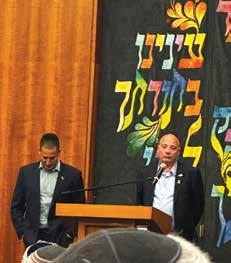

In just a few weeks, thousands of Lomdei Oraysa from around the globe will be celebrating the completion of Maseches Yoma with the Oraysa Amud V’Chazarah program that has revolutionized the Torah world.
On the first day of Chol Hamoed Pesach, Oraysa lomdim will begin Maseches Sukkah.
The timing of this next Masechta coincides beautifully with the calendar, as Oraysa is set to finish Masechta Sukkah just in time for Sukkos of 5785, be”H.
Participants describe the immense satisfaction that they receive from the in-
novative program that calls for the studying of one Amud a day, 5 days a week, in a thorough manner. Each day, one new Amud is learned and yesterday’s Amud is reviewed; Friday and Shabbos is dedicated to reviewing the two-and-a-half blatt learnt over the week. With this format, each Amud is learned and mastered.
The shiurim available on Oraysa’s website and hotline featuring top-notch Maggidei Shiur in English, Yiddish, and Hebrew have also proven to be a major attraction. The handy Oraysa calendar is one user-friendly tool that many carry around that helps lomdim stay up-to-date
and keep track of what they’ve learned and is just one of the many resources offered by Oraysa.
Participants also have the option of taking an optional bi-monthly bechina, which is given every other Sunday on five Blatt. The bechinos have become a valuable tool for testing one’s knowledge and promoting retention, motivating participants to do additional reviews at the end of each two weeks.
It has become a common sight to see lomdim proudly bearing the highly popular “Yalkut Oraysa.” This booklet is a masterfully created work of marei mekomos,
explanations, daily quizzes and halacha l’ma’aseh which are utilized as important aids to enhance the learning of thousands of avid Lomdei Oraysa.
For anyone looking to acquire a Masechta and gain daily satisfaction and simcha in learning, Oraysa may just be the program you are looking for!
To join Oraysa for Maseches Sukkah or for more information, contact Oraysa at 914.8.ORAYSA or email info@oraysa. org.
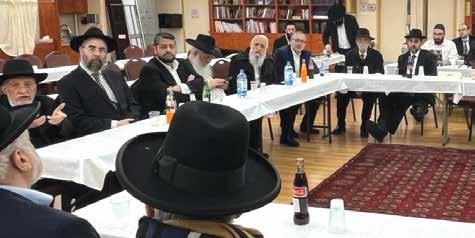
The Chief Bukharian Rabbinate of USA and Canada held its annual pre-Pesach shiur along with Q and A for all the rabbis of the Bukharian community.
Over 40 community rabbis joined at one point of the three-hour session which took place at the Beth Gavriel Communi-
ty Center in Forest Hills.
The program began with the Av Beit Din, Rav Eliyahu Ben Chaim delivering a class on hilchot Pesach. This was followed by a class by the Chief Rabbi of the Bukharian community in USA and Canada, Rav Yitzchak Yisraeli. The Chief Rabbi then answered a wide variety of
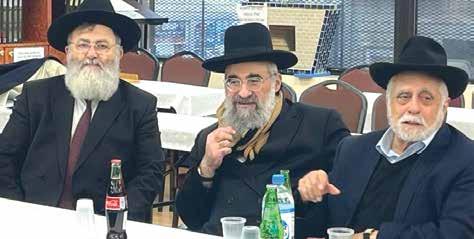
questions with the relevant sources and explanations in an awe-inspiring fashion.
Rabbi Nissan Gavrielov then provided an update on an initiative the Chief Bukharian Rabbinate started two years ago in providing proper guidance and kallah classes to the women of the com-
munity. Over 50 rebbetzins and kallah teachers have untied in teaching in a unified fashion following the rulings of the Shulchan Aruch as per the guidance of Rav Yisraeli. The goal is to further expand programs and services to the women of the community in the very near future.

 By Leah Kammerman
By Leah Kammerman
Every year, HAFTR High School students look forward to celebrating a festive Purim Chagiga with Holocaust survivors at the Marion and Aaron Gural JCC in Cedarhurst. It is a fulfilling experience that students enjoy and value. The spots for students who could participate filled quickly, as students rushed to sign up for this event as soon as it was announced. Even though students visit multiple times a year, the Purim Chagiga is a highlight.
On Thursday, March 28, students made their way to the JCC. Once there, they engaged in meaningful conversations with the Holocaust survivors, ate together, and helped clean up when the
programming concluded. One of the best parts of the day was dancing with the survivors and listening to their stories. The joy it brought to them, and the students, was unmatched. Most of the students chose to attend this event because they wanted to bring simcha to the JCC members but ended up receiving just as much simcha in return. A chance to do chesed and fulfill mitzvot turned into an incredibly meaningful experience for everyone.
The event was also a reminder that we need to spend every moment we can engaging with and learning from the Holocaust survivors in our community. This program highlights that even a small interaction, a short conversation, or a smile can be extremely fulfilling and meaningful.
Thanks to the overwhelming generosity and support from partners and donors globally, Aish, the Jerusalem-based Jewish education organization, exceeded its ambitious $4 million fundraising goal to further innovative Jewish education around the world.
The campaign, which took place last week, was dubbed Aish United, was an online campaign that also included hundreds of volunteers making calls to donors from a temporary call center set up in the Dan Family Aish World Center over three days. The outpouring of financial backing will allow the organization to further its mission of inspiring and connecting Jewish people around the globe by utilizing cutting-edge technology and innovative digital solutions.
“We were simply blown away by the incredible display of unity and support during the Aish United campaign,” said Rabbi Steven Burg, CEO of Aish. “Raising over $4 million is a tremendous achievement that will empower us to reach and positively impact more Jewish people

Congressman Tom Suozzi (D-NY), joined by a bipartisan group of congressional members, met with Ukraine President Volodymyr Zelenskyy and top-ranking Ukrainian, Polish, Moldovan, and U.S. military and civilian officials during his trip last week to Eastern Europe.
Matzah, Matzah
The Matzah Factory visited Lev Chana this week, and the students loved it! They had the chance to learn how matzah is made and to make it themselves. From grinding the wheat into flour, to mixing the dough and shaping the matzah, the students had a great time and learned a lot!

than ever before through dynamic digital engagement utilizing new platforms we have in active development.”
One of these new groundbreaking initiatives, Aish+, will harness advanced technological solutions that will facilitate meaningful online communities and is set to be launched in the coming weeks. The goal of the project is to create immersive, highly engaging, and personalized experiences that meet Jews wherever they are across digital spaces.
“This incredible success reaffirms that our donors believe deeply in the importance of our innovative approaches to spreading Jewish wisdom and values in exciting and relevant ways,” said Rabbi Ben Gonsher, Head of Development at Aish. “In today’s age of widespread assimilation and disconnect, especially among younger generations, there is a burning need to creatively utilize technology to reignite the inner spark within every Jew worldwide, and people relate to that mission and want to partner with us to achieve it.”

The organization has been a trailblazer in online Jewish education and now ranks as the fourth-largest online Jewish content provider. With this substantial new funding, it will be able to further scale its boundary-pushing initiatives and explore even more innovative ways to deliver dynamic, spiritually enriching content and experiences accessible on the digital channels that today’s genera-
tions are constantly engaged with.
“We are humbled by our donors’ vision and commitment to supporting our work to shape the Jewish future,” added Rabbi Burg. “This is just the beginning as we charge ahead applying cutting-edge technologies to illuminate the eternal wisdom and beauty of our traditions in unprecedented ways.”


The Gesher students had a blast at their annual Matzah Factory experience. Each child had a chance

to whack wheat, grind flour, roll out the dough and watch their matzos bake. The children were chanting “L’shaim Matzos

Mitzvah” throughout the process. It was a truly spectacular event!
Nassau County Executive Bruce Blakeman has been making national headlines lately. In 2024, being a normal Executive in a deep Blue state like New York apparently garners a lot of attention. He drove Democrats crazy when he decided to protect women’s sports and locker rooms by banning men from participating in women’s activities. Now he’s being called a Nazi because he wants to prepare for emergencies that may come up in the future.
The overreaction began when Blakeman put out a call for people who would be willing to be called to help in the case of an emergency. For example, if there is another Superstorm Sandy, there should not be a shortage of those who are trained instead of scrambling for volunteers. Part of the requirement is that those who are signing up must have a pistol license and are trained to use firearms. This sent Blakeman’s political enemies into a tizzy, claiming that Blakeman was raising his own militia.
The most ridiculous attack came from the Minority Leader of the Nassau County Legislature, Delia DeRiggi-Whitton (D-Glen Cove). “I’ve had some people tell me it’s actually causing them a lot of anxiety,” DeRiggi-Whitton claimed. “It reminds them not only of the Wild West but of times in Europe with uncertainty. There was something called the Brownshirts, which was basically having civilians all of a sudden become part of law enforcement without the training.”
First and foremost, comparing Blakeman’s plan to the Brownshirts is a gross
exaggeration and a disservice to historical accuracy. The Brownshirts, or Sturmabteilung (SA), were the paramilitary wing of the Nazi Party, infamous for their brutal tactics and role in the suppression of political opposition during Hitler’s rise to power. Equating a community emergency response initiative in Nassau County to the systematic terror and violence unleashed by the SA is not only absurd but also insulting to the memory of those who suffered under Nazi tyranny.
Furthermore, Nassau County’s plan to enlist armed citizens for emergency assistance bears no resemblance to the Brownshirts’ sinister agenda. Blakeman’s proposal aims to supplement law enforcement efforts during emergencies, not to establish a paramilitary force bent on political intimidation and violence. The individuals participating in this program would undergo rigorous training and scrutiny, ensuring that they are prepared to assist law enforcement responsibly and effectively. Unlike the Brownshirts, who operated with impunity and answered only to the Nazi Party, these citizens would be accountable to established legal authorities and subject to the same standards of conduct as law enforcement officers.
Given that Blakeman is a Republican, it’s literally the job of the Democrats to fight his proposals, regardless of how common-sense they may be. Instead of working with Blakeman to alleviate concerns people may have, DeRiggi-Whiton engages in baseless fearmongering. Drawing parallels to historical atrocities only serves to inflame tensions and hinder constructive dialogue about effective

emergency preparedness measures. Instead of resorting to hyperbolic comparisons, critics should engage in meaningful discussions about the practical implications and potential safeguards of Blakeman’s proposal.
In response to these baseless attacks, Bruce Blakeman, who is Jewish, went to the Holocaust Museum in Glen Cove, which is in DeRiggi-Whiton’s district, and demanded her resignation. “She has no right to be a public officer and a public servant in this county. She should resign,” Blakeman said. Blakeman was surrounded by rabbinic leaders and elected Jewish Representatives like Presiding Officer Howard Koppel, Nassau Legislator Mazi Pilip, and Assemblyman Ari Brown.
“Equating these men and women, who would be willing to donate their time to
protect our county,” Blakeman said at the press conference, “calling them brownshirts?” Blakeman went on to describe some of the 80 people who have already signed up, but withheld more information at this time. They included former marines and NYPD officers. Anyone who signed up will be subject to an approval process before being on the database.
This is just the latest example of how quickly Democrats are willing to trivialize the Holocaust for political gain. We are seeing it endlessly in the war against Hamas, with claims that Israel is acting like Nazis when they are actively attempting to prevent civilian death. It’s despicable, and it must end. Good for County Executive Blakeman for calling out this venom in Nassau County, even while it continues to spread to everyone else.




Rabbi Usher Jungreis with his class in Chaim Berlin watching the eclipse on Monday Shulamith ECC made matzah in preparation for Pesach
Plainview’s Mercaz Academy students in grades one through six were able to tour the states of Illinois, Ohio, New Mexico, California, Texas, Hawaii, Utah, Colorado, New Mexico, Massachusetts, Florida, New Jersey, Tennessee, and Pennsylvania in just one hour, guided by well-informed fifth graders.
For months, students in the fifth grade have been preparing for the annual Mercaz Academy State Fair, and all their preparation and hard work was on display last week for the rest of the school and their own families. After each student selected a state to represent–in some ways, the hardest part of the state report–students in the whole class researched every aspect of their respective states, from its history to its state symbols, from its population to which hotels are within walking distance of a shul . Students set up booths to represent their states, complete
with brochures, a miniature float that also features in a CGI-enhanced video, and a guidebook crammed with information. In what has become a tradition, the booths all featured “Blue Dog” paintings in the style of artist George Rodrigue, with each student painting a dog into a landscape of his or her state.
The fifth graders arranged a scavenger hunt for their visitors, and students scurried from booth to booth to find the answers to questions like, “What is the state bird of Illinois?” and “What is the population of New Mexico?” When the scavenger hunt was complete, students enjoyed playing with the giant interactive map of the United States. Each state led to a virtual “room” designed by the fifth graders and filled with items linking to the appropriate websites for their states.

In the evening, families of the fifth grade students attended the fair. The presentation opened with a parade of the miniature floats. Students then spoke about their states, with the goal of convincing their parents to visit for a weekend, and it seemed that a few may even be successful in achieving that goal.
This week, Rabbi Adler’s fifth grade at YOSS joined an enormous chessed organization and participated in helping hundreds of rabbeim’s families for Pesach. They had the wonderful opportunity to volunteer for Chasdei Lev. One of the fathers of Rabbi Adlers’s talmidim, Mordy Polatoff, volunteers every year with Chasdei Lev. He invited the class to join in this massive scale chessed packing all the goods, food and supplies for rabbeim and their families for Pesach. The class was extremely excited and jumped at the chance to participate in this incredible chessed. A few class parents and Rabbi Adler drove them to North Woodmere Park at 10:30 am where they grabbed their super comfy Chasdei Lev Sweatshirts and promptly started orientation. They were directed what to do and how the operation was going to use their help.
With incredible energy and simcha, they ran from car to car efficiently packing all the goods and sending off the recipient with a smile and a “good yom tov.”
According to Ari Ackerman, one of the fifth graders, it was very special “making the rebbeim’s and their families yom tov so much happier.” Ari said the highlight of his day was packing the car of his Rebbe for this coming summer.
“It was honestly just running around and doing all the chessed; you felt really good and accomplished,” exclaimed Shai Apfel, “When we finished filling up a car and seeing it drive off – it was a really good feeling inside.”
Both boys echoed that it was so unique doing chessed all together as a class and feeding off each other’s energy and excitement.
After all their hard work, Rabbi Adler’s class joined all the volunteers for a

All in all, Mercaz Academy’s fifth grade is proud to report that the states in our union are interesting as well as strong.

delicious lunch of fresh baked pizza in an on-location pizza oven and freshly made fries!
Rabbi Adler was happy to report, “The boys really worked hard and enjoyed the day, they got a lot of sipuk (inner satisfaction); it was a no ulterior motive kind of [chessed] – they were there to help and
that’s what they did, for an hour and a half straight!”
May their chessed be a zechus for them and an example to us all. IY”H they will continue seeking opportunities to do chessed for their fellow Yidden! Chag kasher v’sameach!
his Shabbos local unaffiliated Jews experienced incredible positivity, joy and inspiration in observing their first Shabbos. Most of the college students decided to drop off their phones in BJX before Shabbos and did not have access to their phones until long after the conclusion of the beautiful musical Havdalah. There were no distractions or diversions from the peace and holiness of Shabbos. They were serious about trying to keep a full Shabbos! Surprisingly, although this was their first time without technology for such a long period, not a single student complained of withdrawal symptoms. The Shabbos programming was so impactful and enriching that they never felt the urge to get back to their phones.
These students attend Baruch, LIU, Fordham, Brooklyn College, Pace, FIT, and St Johns. After Shabbos, two stu-
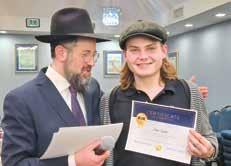
dents said that they would like to keep Shabbos for the rest of their lives!
“Shabbos was amazing and a spiritual retreat for myself,” said Elan, a student in Baruch College.
Another student, Joshua said, “I really enjoyed it. If I were to rate my Shabbos with BJX, I would give it 6 stars out of 5!”
This Shabbos was remarkable on so many levels. May it be a zechus for ALL of Klal Yisroel!
 By Avital Gil
By Avital Gil
On Thursday afternoon, April 4, a group of HANC High School seniors went to the Glen Cove Holocaust Museum for a press conference hosted by Nassau County Executive Bruce Blakeman. Participants heard from several representatives including Assemblyman Ari
Brown and Legislator Mazi Philips, who voiced their concerns of antisemitism towards the NYPD in connection to the Holocaust.
Students gathered for a photo with the representatives and were surprised to learn that other attendees included HANC alum, Mr. Gabe Boxer ‘98.


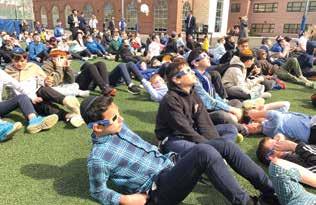
Ahead of the solar eclipse, the YOSS Abraham and Sara Silber Middle school had the privilege to hear about it from Dr. Zalman Burger, a research scientist, Professor at YU

and FDU, and amateur astronomer. He presented to each grade separately and taught them all about the science of the eclipse, how to safely view the eclipse and gave a firsthand account of the so -

On Sunday, the fifth, sixth and eighth grade boys in HALB celebrated the first annual Veshinantem Siyum. They were joined by their rebbeim, fathers and grandfathers and

spent the morning davening, learning and singing together. It was an incredibly meaningful and beautiful experience for everyone. Mazal tov!

Mah rabu ma’asechah Hashem! There was nothing partial about the amazing chinuch experience the entire Shulamith witnessed when viewing the solar eclipse on Monday, April 8. After preparing for the eclipse by hearing a Torah perspective from our principal, Mrs. Ginsparg, and science lessons from our outstanding science team, Mrs. Levine and Mrs. Ruck,

all students went outside to view this historical event. The girls were equipped with safety glasses provided by CIJE and saw models, videos and projects related to the eclipse that enhanced this special occasion. This experience truly represented Hashem’s hand in everything we see. With a Time Capsule project to close out the program, the girls are eager to see what will happen in 2044.
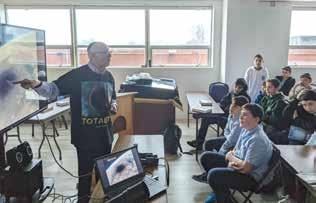
lar eclipse of 2017. His son, Rabbi Nossie Burger, a rebbe and middle school staff member, introduced the presentation to each grade providing the Torah perspective and how we can be inspired by Hashem’s amazing world. The boys absolutely loved it, and it made viewing the solar eclipse all the more real!

The magic of Matilda was brought to stage on Sunday at the SHS Production. Adapted from the musical, the play weaved the traditional storyline of Matilda with a Jewish twist, emphasizing the theme that the most potent superpower is maintaining your belief through hard times.
Production heads Tirzah Luchins, Leorah Shetrit, and Tova Scharf, who played Matilda, Trunchbull, and Mrs. Phelps respectively, blew away the audience with their confident stage presence and their ease in weaving between acting and singing. The cast’s performances across the board left everyone in the sold-out room mesmerized.
Ahuva Davidson, Tamar Frei, Ilana
Hayoun, Shayana Litvintchouk, and Nikki Weiss, our supremely talented dance heads, managed to coordinate over 100 students between 5 dances and choreograph numbers that added to the flow of the plot rather than interrupting it. The set design, tech, and backstage teams flawlessly reinforced the flow of the show, supporting the performers from behind the scenes.
Huge shout out to Esty Munk, SHS Director of Student Experience, who scripted, cast, and directed the show from start to finish, helping every Shulamith student find her individual superpower and giving her a stage on which to shine.
Gabe, which wines are you having this year for the Four Cups? I am asked this question every year, countless times. Does it really matter? It does, yes. But mostly to me. For you, dear readers, what should matter is which wines YOU like to drink for the four cups. Pesach is the celebration of freedom –freedom from Mitzrayim, from earthly, materialistic avdus, and the freedom to be the willful servants of Hashem. We have to drink four cups of wine on the night of the Seder, but B”H, we can freely choose the wines we enjoy most for that purpose. As I do every year, I plan on drinking the best rosé from Eretz Yisrael I can get for the first Seder, and the best rosé from the diaspora for the second Seder. But that’s me. I like using rosé, but if YOU prefer an off-dry white, a bold dry red, or a sparkling wine, go for it! Enjoy what you like. Yes, there are family customs and some rules that are interpreted in various fashions. However, in my humble opinion, drinking the Four Cups should be a pleasant experience done with hiddur mitzvah, and not merely a religious ritual we practice because we are asked to. And by hiddur mitzvah, I mean that the wine you pour in your daled kosos should be enjoyable to drink in that setting.
Therefore, here is a selection of a variety of wines, each appealing to different approaches and palates. This Pesach, may each of your cups be more enjoyable than the next. L’chaim, Chag Sameach!
Razi’el, Rosé, Brut, NV: Several of my friends use a rosé sparkling wine for some or all of the four cups. Rosé because
it counts as red, and sparkling because they say it’s refreshing and easy to drink. While I love a good sparkling wine, rosé or not, I personally find the effervescence calls for slow sipping rather than for quick drinking, the latter of which is how I drink my Four Cups. For my aforementioned friends and those among you who can relate to their preferences, I recommend this complex traditional-method sparkling wine from Israel made by Eli Ben Zaken, who is also the proprietor and founder of Domaine du Castel. It is a rich, complex wine with elegant bubbles, and layers of red berries and stone fruits notes alongside subtle yeastiness. A truly luxurious wine to elevate your Seder.
Matar, Cabernet Sauvignon, 2019: Matar’s wines have gained many fans for their clean, consistent, and fruit-forward wines. Matar Winery, situated in the Golan Heights, minutes away from both the Lebanese and Syrian borders, has a clear new world style of winemaking without ever succumbing to the temptations of in-your-face, overly ripe wines. This Cabernet Sauvignon will satisfy the most demanding drinkers of bold, generous wines with a long finish and linear tannins.
Rocca delle Macie, Chianti Classico, 2022: No wonder why this winery sells more than 80,000 cases/year to mainstream wine consumers! It is a delicious, easy-to-drink Chianti. With a medium body featuring juicy red and black fruits, earthy and savory notes of seared portobello in a balsamic glaze, refreshing acidity, and soft, silky tannins, this wine should also be a pleasure to drink throughout the meal.




Tura, Mountain Vista, Chardonnay, 2021: Yes, Tura makes white wines, as well. This Chardonnay shows a great balance of oak and fruit, it is neither too fruity nor too oaky, with medium acidity keeping it refreshing without feeling abrasive. It can also accompany an entire meal starting with matza ball soup, followed by gefilte fish, chicken, and fruit salad.
Herzog, Variations, Be-leaf, Cabernet Sauvignon, 2021: Last but not


least, we cannot forget those who are sensitive to sulfites. While sulfites naturally occur in every wine (and many foods too), winemakers usually add some during the process to prevent premature oxidation. The Be-leaf is made from high-quality organic Cabernet Sauvignon grapes grown in Paso Robles, without any added sulfites. It is a juicy, delicious, quality Cabernet Sauvignon with notes of black and blue fruits and polished tannins. It is also CCOF organic-certified.



1. How long does a typical earthquake last?
a. Less than 30 seconds
b. Less than 60 seconds
c. 2 ½ minutes
d. As long as it takes you to sit down in your chair
2. Which state has the most earthquakes?
a. Alaska
b. California
c. Nevada
d. New Jersey
3. Are there earthquakes on the moon?
a. Yes
b. No
4. What is a “fault line”?
a. When you tell your wife you were delayed because of traffic but you were really delayed because you stopped into Delicious Dishes for cholent
b. It is the place where two tectonic plates meet
5. How often is there an earthquake somewhere in the world?
a. At least once a month
b. At least once a day
c. At least once a year
d. Approximately every 30 seconds
6. What has come to be known as the “earthquake series”?
a. A series of four earthquakes that took place in California between 1890 and 1917
b. The sequence of tremors being followed by an actual earthquake, which is followed by a tsunami
c. The 1989 World Series between the Oakland A’s and the San Francisco Giants, during which the Loma Prieta earthquake occurred before Game 3 began, causing a 10day disruption in play
d. A series done by Discovery, which included never-before footage from 10 thousand feet underground Answers

1. B- A typical earthquake lasts under 60 seconds.
2. A- Alaska has the most earthquakes of any states in the U.S.
It has a magnitude 7 quake almost every year.
3. A- Well, obviously there are no earthquakes but there are at least four different kinds of moonquakes: (1) deep moonquakes about 700 km below the surface, probably caused by tides; (2) vibrations from the impact of meteorites; (3) thermal quakes caused by the expansion of the frigid crust when first illuminated by the morning sun after two weeks of deep-freeze lunar night; and (4) shallow moonquakes only 20 or 30 kilometers below the surface.
4. B
5. D- It is estimated that there are 500,000 detectable earthquakes in the world each year. 100,000 of those can be felt, and 100 of them cause damage.
6. C
4-6 correct: You took this earthquake too seriously or you are from the West Coast. So, you either need to get a life or “duuuude, really cuuz you’re from like Cali, huh?”
2-3 correct: Not bad, but your intelligence isn’t shifting any tectonic plates.
0-1 correct: Your intelligence level is a perfect 0 on the Richter scale.
Our house isn’t messy; we’re just playing “after the earthquake.”
It wasn’t an earthquake; I was just tasting the matzah.
It wasn’t an earthquake; it was my stomach rumbling for my pre-Shabbos cholent.
It wasn’t an earthquake; it was my stomach rumbling after my pre-Shabbos cholent.
It wasn’t an earthquake; it was my wife Pesach cleaning and throwing out all my old papers.
After the earthquake, I need a psychologist because I’m not a memologist.
Is this what Californians are all stressed about?
Three men are sitting on a bench in Florida and discussing how they achieved the financial ability to retire in comfort.
The first guy says that he had a factory, and there was a big fire; he collected the insurance and retired.
The second guy says that he had a warehouse filled with merchandise, and there was a flood; he collected the insurance and retired.
The earthquake was fine; having to talk about it at the water cooler for the next six hours was rather annoying.
I didn’t feel the earthquake, because I wasn’t wearing my earthquake glasses.
Dear Earth, Go to settings. Select sound. In vibration option, select “No.”
If you actually went under your desk, you definitely floss twice a day.
I didn’t feel the earthquake because it happened at 10:29 am, and my alarm clock is set for 10:30 am.
It wasn’t an earthquake; it was a stampede of women surrounding the potato starch section in Gourmet Glatt.


They ask the third guy how he made his money.
He responds, “There was a solar eclipse.”
“How did you arrange that?!” the first two guys asked in unison.
“I didn’t,” the man replies. “I’m the just one who sold everyone their eclipse glasses!”
 By Rabbi Berel Wein
By Rabbi Berel Wein
One of the primary commandments in Judaism is to marry and have children. In the Garden of Eden, we find Adam and Chava blessed by G-d and told to procreate and fill the world with people. For the Jewish people, having children has become a demographic necessity. Even though it is years since World II and the resultant Holocaust, the Jewish people has not as
of yet made good on those immense losses in terms of population. This is due to a lower-than-average birth rate amongst nonobservant Jews, a high rate of divorce, later-in-life marriages and an increasing population of singles. The ravages of assimilation and intermarriage also play a great part in the fact that Jews can hardly replace themselves, let alone make up for the deficit caused by the Holocaust.


The Torah places a high priority on children. It sees in children not only the physical continuity of the Jewish people but also a spiritual and heavenly connection that transcends one’s lifespan. The rabbis commented regarding our father Jacob that, as long as his descendants were alive and functioning, then Jacob
tors that are unavoidable in the raising and nurturing of a child. In all human society, it is natural, indeed expected, for parents to do everything possible to give their children a good and healthy life. Still, the Torah, which is the book of practical human life, minces no words in describing the difficulties – impurity,
The concept of the immortal soul is reinforced by being able to project forward in time, living vicariously in the lives of one’s descendants.
himself, so to speak, was also still alive. Seeing oneself “past the grave” is one of the hallmarks of Judaism and of the Jewish people. The concept of the immortal soul is reinforced by being able to project forward in time, living vicariously in the lives of one’s descendants.
But, my friends, we all know that having and raising children is no easy task. And we also know that a parent remains a parent for one’s entire life. I feel that this is one of the subtle messages conveyed at the beginning of this week’s Torah reading. The Torah speaks of impurity, sacrifice, and isolation of the mother after the birth of a child. This is the Torah’s indication that these are fac -
sacrifice, and separation from others –that having and raising children automatically brings to parents.
It is perhaps for this very reason that the Torah gave women such a strong maternal instinct and the desire to have children. For without that instinct, based only on the practicalities of life and the difficulties of raising children, Jewish demographics would, in a practical sense, offer us no hope whatsoever for the future. The rabbis in Avot correctly stated that “the reward is directly commensurate with the effort and sacrifice.” That is certainly true as far as children and generations and the Jewish future is concerned.
Shabbat shalom.

The Midrash (Vayikra Rabbah 16:2) relates the following story: A peddler, rachil, would travel to various towns and proclaim, “Who wants to buy the elixir of life?” R’ Yannai heard him and said, “Sell it to me.” The peddler took a book of Tehillim and showed him the verse, “Who is the man who desires life... guard your tongue from evil, etc.” (Tehillim 14 -34:13). R’ Yannai replied, “All my days I read this verse and I did not know how to interpret it until this peddler came and made it understood.”
R’ Yannai’s statement is confounding. What was so novel about the peddler’s interpretation? He merely explained the pasuk according to its plain meaning.
One of the names of the ten sefiros is netzach. Netzach means “victorious,” but it also means “eternal.” Combining these concepts, netzach means “eternal victory.” This idea contains and instructs us in a fundamental aspect of our avodas Hashem. It is relatively simple to understand, but it is not easy to live.
Everyone wants to win. We may not always be sure what the competition is, but we want to win. For example, in a war, there may be a skirmish over a little village. The fact that the little village was conquered does not mean that the conquering army or country vanquished the enemy. It merely means that along the way, they won a battle. Victory in the war, a lasting victory, is what counts. When building a house, one does not celebrate when he lays the first brick. That is merely part of the process. Netzach is the completion of the house.
As children, it never rang true when the adults said, “It’s not whether you win or lose – it’s how you play the game.”
In reality, it was all about winning. We wanted only to crush, defeat, humiliate and destroy. “It’s not whether you win
 By Rav Moshe Weinberger
Adapted for publication by Dov Elias
By Rav Moshe Weinberger
Adapted for publication by Dov Elias

or lose – it’s how you play the game” was only something adults told us to pacify the losers.
Now let us consider the example of two chavrusas , Reuven and Shimon. Both young men are serious, sincere and focused on growth. They arrive on time to davening. They attend every seder and every shiur. They review. They take notes. They have been learning together for years. The only difference is that Reuven’s dream is to be a scholar. He wants to hold his own with other rabbis. He hopes one day to be a renowned rosh yeshiva. He imagines himself surrounded by students who heap accolades on him. This is not always at the forefront of his consciousness, but it is always in the back of his mind.
Shimon is just as proficient in learning, but he does not have these visions of grandeur. He may teach Torah one day. But, equally plausibly, he could go into business. When Shimon learns, it is not about the conquest, the siyum, or writing a sefer What motivates Shimon is one thought: “There is a Creator of the
Universe, Who I believe in with all of my heart, and I was taught that there is no greater way to attach myself to the Master of All Worlds than by learning His Torah and entering into His ‘brain.’” He has complete emunah that every word of learning and davening provides Hashem with pleasure, nachas
Which one is a winner, and which one is a loser? For Reuven, victory will only come when he earns semicha, becomes a rosh yeshiva, impresses his rebbe with a sharp question, or writes a sefer. If those do not materialize, he is a loser. Even along the way, if he cannot understand a Tosfos, he is a loser. In the scheme of life, his chances of winning are very slim. By contrast, Shimon would never forgo the present moment of learning. He tastes the word of the Living G-d in every single word from the sefer. That is netzach He attains a new victory at every moment. What is he defeating? He defeats the urge to remain in bed for another two hours. He defeats the urge to succumb to illicit desires which would pull him away from what he is trying to
accomplish. He defeats the darker part of who he is, and he tastes the unbelievably delicious flavor of victory. That taste of victory in the present moment has nothing to do with whether or not he will succeed the next day. It is a moment of netzach; a moment of overcoming the impulse that tries to seduce us into believing that G-d does not care if we daven or learn. And his victory in that moment lasts forever, even if he stumbles the next day, or even at the next moment. There are examples in the material world as well. Let us imagine that Reuven and Shimon are both overweight and both want to lose weight. Reuven’s goal is to lose 50 pounds by Sukkos because he wants to feel good, be healthy, and fit into the suit that he used to wear. He plans to train and maintain a strict diet. Shimon is also on a diet. However, he is dieting because he realizes that, somewhere along the way, he became animalistic. He realized, after knocking over an 80-yearold woman at a smorgasbord to get some spare ribs, that he would no longer allow his baser urges rule over him any longer.
How do these two approaches differ?
If Reuven meets his goal of losing 50 pounds, he wins. But if he succumbs in the last few days of his diet plan, he is a loser. By contrast, every time that Shimon declines a piece of cake, he is liberated of his urges. He is G-dly. He is a winner who defeats his urges. He is not merely a body without a soul; he has a soul. He can even enjoy food – within reason. He is an eternal winner; every moment he holds back is an eternal victory. Even if he eats cake the next day, that is a different war. Today, he won.
Lest one question this assertion that every moment’s victory is eternal, even if followed by defeat at some other moment, let us learn what Rebbe Nosson zy”a ,
says about the matter. He writes (Likutei Halachos, Birchas Hariyah 5:2) that the main victory is an eternal victory. One who is victorious over himself and defeats his illicit desires and negative traits wins an everlasting victory. He can defeat any obstacle which attempts to prevent him from seeking truth or that tries to distance him from his Father in Heaven, G-d forbid. Since his intent is truly for Heaven, every moment in which he overcomes his darker impulses is a victory. Someone whose intentions are truly for the side of holiness, to do Hashem’s will – no matter what he does afterward, he always wins. Only Hashem is forever. Therefore, all those who sincerely desire to do His will merit netzach. That is true victory. “Netzach of Israel will not lie” (Shmuel I 15:29). All other victories are false. They are relative and dependent. Only the Infinite One is eternal.
Rabbi Yaakov Bender, rosh yeshiva of Yeshiva Darchei Torah, would sometimes walk my father, a survivor of Mauthausen, home from shul after Shacharis. He noticed that my father seemed to truly enjoy watching the children waiting for their school buses to go to yeshivah. Rabbi Bender told how, one time, he asked my father why he enjoyed watching the
children waiting to go to yeshiva. He answered very simply, “Because when I look at them, I know: we won.”
The numerical values of “Nachman” and “netzach” are the same. When Rebbe Nachman of Breslov, zy”a, died, at 38 years old, from tuberculosis, he famously said, “I have been victorious, and I will be victorious.”
before and watched what he should not have watched, today will be better. He is already a winner. He is victorious.
This is why Dovid Hamelech was open about his struggles and begins so many of his Psalms with the word “Lamnatzeach” – netzach. He knew how to take all the low notes and high notes and compose a song. Some days are better, some days
He knew how to take all the low notes and high notes and compose a song.
When a person sees himself as a loser because he occasionally gives into an illicit desire, he lets go of himself. Based on the many people I have spoken to, I believe that a vast majority of the lethargy and lack of motivation for davening, getting out of bed, or learning is due to having succumbed to the desire to gaze at forbidden images. Shimon is not perfect. Shimon also has problems with his illicit desires. However, Shimon’s attitude is that even if he erred the night

are worse. Dovid Hamelech always came out with a song. He also failed, on his level. Yet, when he looked back at his life, he was able to say, “I was victorious and I will be victorious.”
We began by asking what was so novel about the peddler’s interpretation to R’ Yannai. He merely interpreted the pasuk according to its plain meaning. R’ Tzakok Hakohen (Pri Tzaddik, Rosh Chodesh Sivan 2) explains that the peddler was called a “rachil,” which means a “trav-
eling salesman,” but also implies that he had been a “holeich rachil,” a talebearer (Mishlei 11:13). He had been a habitual speaker of rechilus and lashon hara Later in life, he had done teshuva. Once he repented, he tasted the sweetness of the pasuk, “Who is the man who desires life...guard your tongue from evil, etc.”
This Jew’s life – his history – added an entirely new depth to the pasuk. R’ Yannai learned that only a Jew who has been victorious can understand the depths of the sweetness of that pasuk in Tehillim.
Hashem has put each of us on the winning team. All we have to do is get off the bench. May Hashem help each of us, in whatever war we may be fighting, succeed in being present at the celebration for the final and ultimate victory. May we will all be able to say, “We won. We defeated Amalek, Hitler, Hamas, our illicit desires, and the evil inclination.” We are winners. May Hashem cause us to sing the song of the grandson of Dovid, the King Moshiach, on that day.
Rav Moshe Weinberger, shlita, is the founding Morah d’Asrah of Congregation Aish Kodesh in Woodmere, NY, and serves as leader of the new mechina Emek HaMelech.

 By Rabbi Shmuel Reichman
By Rabbi Shmuel Reichman
Time is a prominent theme of Pesach, but it expresses itself in a unique and somewhat puzzling manner. On Pesach, we are commanded to eat matzah (unleavened bread), and eating chametz (leavened bread) is absolutely forbidden (Shemos 12:15). This is an incredibly strict prohibition; the punishment for eating chametz is kares (spiritual excision). This seems extreme, as the difference between matzah and chametz can come down to a matter of seconds. This means that a single second can decide a person’s spiritual reality, determining whether one performed a mitzvah or violated the most severe of prohibitions. Why is time so central to Pesach, and how can a single second of time have such significant implications?
Let us trace this theme of time through the story of Yetzias Mitzrayim, the exodus from Egypt. The Torah commands us to eat matzah on Pesach because the Jewish people left Mitzrayim “b’chipazon” – in great haste (Devarim 16:3). The Jewish people were forced to eat matzah because they did not have enough time to make bread. Although this is the most wellknown reference to time in the Pesach story, there is another.
The Arizal makes an intriguing statement about time and its significance in the Pesach story (See Beis Halevi, Derush 2, quoting the Arizal). He states that had the Jewish people remained in Egypt for even one more second at the point of the Exodus, they would have reached the 50th level of tumah (impurity), a point of no return. Chazal explain that the Jewish people in Mitzrayim were on the forty-ninth level of tumah, the very lowest level of spiritual impurity (Ohr Hachayim, Shemos 3:8). Had we sunk even one level

lower, we would have been lost completely, beyond the point of rescue. The Arizal emphasizes that it was necessary for us to leave with such speed to save us from falling to this lowest level. It is thus clear that the speed with which we left Egypt was of fundamental importance, but we must still answer the question of why.
Before answering our questions, we must analyze the Arizal’s comment more closely. The Arizal says that had the Exodus been delayed for even one more second, we would have been completely lost within the depths of impurity. However, the moment of the Exodus seems to be the furthest thing from a spiritually dangerous time. In fact, it appears to be the moment at which Klal Yisrael was at an ultimate spiritual high, far from spiritual risk.
The Jewish people had just witnessed Hashem unleash His wrath on the Egyptians through the performance of the ten miraculous plagues, a systematic process of openly revealing Hashem to the world.
On the night of the exodus, Hashem performed Makkas Bechoros (the Plague of the Firstborn), devastating Egypt and causing even Pharaoh to panic. Makkas Bechoros was unique in that Hashem Himself performed this makkah (Rashi, Shemos 12:12). The Ramban explains that all the principles of hashgacha pratis (Divine providence) were displayed through these events. We were clearly then on an immensely high spiritual level.
On this same night, the Jewish people brought the Korban Pesach (the Passover sacrifice) – and painted their doorposts with blood, instilling within their hearts the knowledge that Hashem watches over and protects us. This night contained some of the loftiest moments imaginable – one would expect the Jewish people to be on an equally lofty level. This was the birth and creation of Klal Yisrael, the root of their journey to Har Sinai to accept the Torah. How could one more second in this intensely holy atmosphere possibly have caused the destruction of the Jewish people?
If the Arizal’s statement was not al-
ready difficult enough to understand, he takes his statement one step further. The Arizal says that not only would going out one second later have placed us beyond hope, but even if we had gone out just the slightest bit slower, it would have been too late as well. Not only did we have to leave right away, but the pace itself had to be quick. Not only when we left, but how we left was important. What is the meaning of all this?
These questions all come back to the concept of time. In order to understand time, we must take a step back and look at the nature of physicality in general. Time is a dimension of physicality and in some ways is even emblematic of the physical. Therefore, our approach to physicality will illuminate our understanding of time.
Most spiritual schools of thought are focused wholly on the spiritual; they view the physical world as lowly and dangerous. They therefore claim that the physical should be avoided to the greatest extent possible. In order to live a spiritual life, one must escape the physical, completely rejecting their physical nature. Therefore, spiritual systems such as Buddhism prescribe meditation, abstinence, and the suppression of physical desire. In such a system, the ideal is to sit isolated on a mountaintop and meditate on our navel.
Avraham, however, introduced a novel, idealistic approach to life. He understood that while the physical can be dangerous if misused, the ideal is not to transcend the physical but to use the physical to reflect something higher. In other words, he introduced the ideal Jewish spiritual system.
Think, how many mitzvos are com-
mandments of the mind? Incredibly few! You can count them on your hands: Believe in Hashem, love Hashem, be in awe of Hashem, don’t be jealous, and just a few others. The overwhelming majority of mitzvos are physical actions which connect you to the spiritual Source, Hashem. The act is physical, while the intentions and mindset must be infused into it. We eat matzah, shake a lulav, blow shofar, and wear tefillin; all actions, all physical. We don’t believe in transcending the physical, we wish to use the physical to connect to the transcendent.
While the ideal is for the physical to be utilized and elevated, there is an important qualification. When the physical is channeled properly, it enables the highest of spiritual accomplishments, but when misused, it has infinitely negative reverberations. We must therefore maintain control and focus while using the physical. Our root must be transcendent, fully connected to the spiritual, and only then, while maintaining that foundation, can we descend and use the physical. This is why the first stage in the process must always be transcendent. We begin with Yom Kippur, where we transcend as malachim (angels), and only then do we have Sukkos, in which we come back down and embrace the physical aspect of life. We start with the first night of Pesach, a night of transcendence, and then we descend into the physical world, where we build (count) our way to Matan Torah. Without rooting ourselves in the transcendent, we risk getting stuck within the physical.
Applying these concepts to time, we can understand the importance of using time – controlling it, rather than allowing it to enslave us. We have two options: we can either let time pass us over and push us through life, or we can pass over time and transcend its limitations. The key is to use time, not to be used by time. We need to learn how to ride the waves of time, harnessing the dormant potential within each moment. When we are passive in life, everything moves slowly – time becomes quicksand. A life without goals, without a schedule, where moments of time don’t mean anything, is a life stuck within the confines of time. Such a person can kill time, can waste an evening just to get to tomorrow. One who values time, who rides time, views time like money. Time is currency, and you choose how to spend it. Every day we get 86,400 seconds, and how you use your allotted time determines what kind of life you live.
This is the theme of matzah. Chazal
state, “Mitzvah haba’ah liyadchah, al tachmitzenah – when a Mitzvah comes to your hand, don’t let it spoil,” or more literally, don’t allow it to become chametz (Rashi, Shemos 12:17). Chametz is the result of adding time to the baking process of bread. As the Maharal explains (Gur Aryeh, Shemos 12), this statement of Chazal teaches us not to
and this is the secret behind the Arizal’s cryptic statement.
Had we moved one second slower, or a moment too late, our root as a nation would have been stuck within the confines of time. Our “zygote” had to be constructed within the dimension of zerizus, beyond the constrictions of time and space. We were creating our DNA; everything
Had we moved one second slower, or a moment too late, our root as a nation would have been stuck within the confines of time.
allow any extra time to get added to our mitzvos either, otherwise, the mitzvah becomes stuck in time. Fascinatingly, the word mitzvah has the same shoresh (root) as matzah, and the word tachmitzenah has the same shoresh as chametz Just as on Pesach we must not allow our food – our matzah – to get stuck within the confines of time, so too, we cannot allow our spiritual commandments – our mitzvos –to become stuck within the confines of time.
We can now return to our original questions. Pesach night was the inception of Klal Yisrael as a nation. As the Maharal explains (Gevuros Hashem, Chapter 60), on the first night of Pesach, we became a single, unified nation.
Every process is made up of multiple stages. The first stage is the spark of creation, which is followed by a slow process of expressing that original root seed, finally culminating in the finished product. In every process of creation, the root – the seed – is the most crucial and potent phase. This formative stage is also the most delicate. Any error or imperfection that occurs at this stage will have cataclysmic results. For example, if a child cuts his finger at the age of seven, the injury will be minor at worst. However, if there is even a minor glitch in the DNA of a zygote, even a single chromosome missing, everything can go wrong – the results can be catastrophic!
Therefore, when forming the root and seed of Klal Yisrael, it was imperative for us to be perfect, transcending all the limitations of time and space. We needed to move b’zerizus (with alacrity). Our food needed to transcend the limitations of time and space, and so did our very movement. This is the secret of matzah,
had to be perfect. Once we were rooted beyond time and space, we could receive Hashem’s Torah, which is also rooted beyond time and space (Maharal, Tiferes Yisrael, Chapters 1-2, 25). Only once we are rooted beyond time and space can we then come back down and use time and space to reflect something higher.
May we be inspired to fully harness the potential of our time, to use time and
not be used by time, and to enter Pesach and the mitzvah of matzah with the mindset of connecting to ourselves, to all of Klal Yisrael, and to Hashem.
Rabbi Shmuel Reichman is the author of the bestselling book, “The Journey to Your Ultimate Self,” which serves as an inspiring gateway into deeper Jewish thought. He is an educator and speaker who has lectured internationally on topics of Torah thought, Jewish medical ethics, psychology, and leadership. He is also the founder and CEO of Self-Mastery Academy, the transformative online self-development course based on the principles of high-performance psychology and Torah.
After obtaining his BA from Yeshiva University, he received Semicha from Yeshiva University’s RIETS, a master’s degree in education from Azrieli Graduate School, and a master’s degree in Jewish Thought from Bernard Revel Graduate School. He then spent a year studying at Harvard as an Ivy Plus Scholar. He currently lives in Chicago with his wife and son where he is pursuing a PhD at the University of Chicago.
To invite Rabbi Reichman to speak in your community or to enjoy more of his deep and inspiring content, visit his website: ShmuelReichman.com.

Enterprising thieves, in the times of the Gemara, seemed to always be able to catch up to the latest anti-theft trend. The Gemara goes through various measures a watchman was supposed to undertake to safeguard cash. (Bava Metzia 42a) The Gemara proceeds to explain how creative burglars ultimately defeated every technique. At one point in time, the only safe way to safeguard money was to bury it in the ground. There was some question as to how deep a watchman must dig to bury the cash. The Gemara points out that if chametz is buried under a pile of rubble, it may be left there over Pesach. However, if the chametz is buried under less than three tefachim of debris, the owner must remove it. Is the same true for cash? Is three tefachim the magic depth? Ultimately, the Gemara concludes that even one tefach suffices to bury money. Three tefachim is required for chametz so that a dog doesn’t dig it up over Pesach.
It is clear that under certain situations a person can be aware of definite chametz, yet he will have no obligation to remove it before Pesach. One component of bedikas chametz is declaring that all of one’s chametz is worthless and ownerless. However, one can’t simply make that declaration and be absolved from all Pesach cleaning. Chazal mandated that one cannot rely on bitul chametz alone. One reason is that if a person finds chametz over Pesach, he may come to eat it. Therefore, practically, we remove chametz from our houses and declare that any chametz we own is ownerless.
Chametz buried under rubble might achieve two goals by itself. The chametz is considered destroyed. Moreover, he won’t come to eat it on yom tov since it is buried. Therefore, it’s possible that known buried chametz might not even require bitul. As a practical matter, we always perform bitul chametz, so there is no need to theorize if buried chametz requires bitul or not.

Rav Vozner (Chut Shani-Bedikas Chametz 2nd perek) ruled that chametz buried under refuse also does not need to be removed before Pesach. Although it may be easier to dig through garbage than rubble to get to chametz, it doesn’t make a difference. Practically, no one is going to dig through waste to get to chametz, therefore, it is like it is destroyed.
Most people have a separate mixer for Pesach. However, what would be the halacha in a situation where someone doesn’t have that luxury? The mixer would certainly need to be cleaned out well. But what if some challah dough got stuck in between some cracks and crevices? What if there is a k’zayis of chametz visible through the mixer cracks, but it is inaccessible? Does one have to hire a professional to take apart his mixer? No! He can technically use that very same mixer that has chametz in it for Pesach. Since the chametz is inaccessible, it is like it is destroyed and one may rely on bitul chametz. This assumes that no crumbs of chametz will enter into food on Pesach. (The chametz is in the unit and not in the bowl.)
Similarly, one does not need to move heavy furniture to look under them for chametz. Rav Vozner says this is true even if one would move the heavy furniture to look for jewelry. Under normal circumstances, the heavy furniture is not moved, so any chametz under them is not accessible. Rav Vozner reasons that a person can move rubble if he has to find an item. Yet, the Gemara rules that one does not need to move the rubble. Therefore, one does not need to move heavy furniture even if it is possible to move it. Similarly, if there is a space between heavy furniture and a wall, one can rely on bitul and not check or clean there.
There is one major caveat: if one did move heavy furniture less than 30 days before Pesach, he must clean under it. This is based on the logic that one can’t intentionally cover up an area with rubble to save himself from performing a bedika in that area. However, if a third party covered up his chametz with rubble, Rav Vozner says that no bedika is required. This raises an interesting question: if someone moves his heavy appliance
less than 30 days before Pesach, he must clean or do a bedika under it. What if someone hired a repairman to fix his hard-to-move refrigerator? The repairman moved the heavy refrigerator and moved it back. If the owner had done so, there is no question that a bedika is required. Similarly, if the owner was present when the fridge was moved back and forth, presumably a cleaning or bedika is required. What if the owner was not present? Do we view the repairman as an agent of the owner and require a bedika?
One last scenario discussed by Rav Vozner: chametz entered the lining of one’s jacket through a hole in a pocket. The area is inaccessible. Somewhat surprisingly, Rav Vozner requires one to open up the seams and remove the chametz. The opening of the seams does not require an expert. Therefore, Rav Vozner deems this area accessible and requires the chametz to be removed. However, Dayan Fisher, zt”l, disagrees and said this too is similar to a situation of chametz covered by rubble and one can rely on bitul.
The Piskei Teshuvos points out that the aforementioned rulings represent the letter of the law. However, the nashim tzidkaniyos of K’lal Yisrael would never countenance using a mixer on Pesach where chametz was visible! The Shulchan Aruch even records a custom of scraping walls clean! Yet, it is always important to distinguish between mandatory halacha from minhag. Sometimes, following these chumros may be a luxury that will have to give way to other pressing concerns.
Rabbi Avrohom Sebrow is a rebbe at Yeshiva Ateres Shimon in Far Rockaway. In addition, Rabbi Sebrow leads a daf yomi chaburah at Eitz Chayim of Dogwood Park in West Hempstead, NY. He can be contacted at ASebrow@gmail.com.
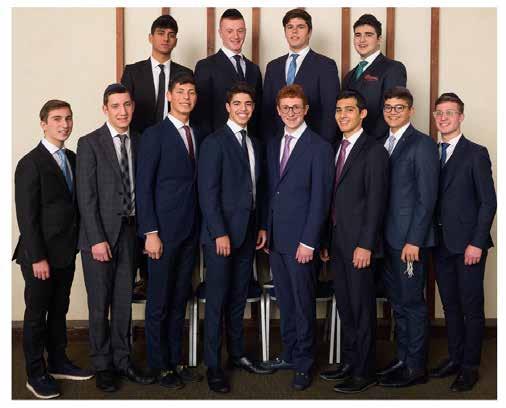


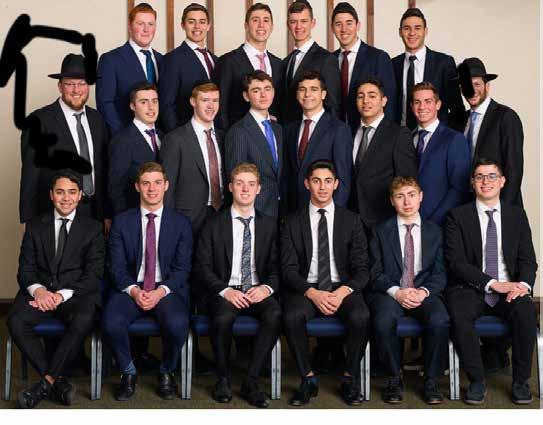

Right now, shmurah matzah is running at $40 per pound retail, which has recently brought up the following conversation in shul:
“How come we can’t make it ourselves, anymore? That’s how it used to be, you know…”
“Because there are too many things to watch out for – that’s why. Just pay your $40 a pound – like the rest of us.”
“I think that it is the commercialization that changed things around. Back then, they used to make it thick. Now it’s super-thin. It’s commercialization that caused it – not halacha.”
“Who knows...”
To get into the thick of things on the issue, it might be a good idea to examine the history of matzah making. We can possibly trace the development of this history by examining at least four different types of sources. The Machon Moreshes Ashkenaz in Bnei Brak is an important resource when it comes to understanding Ashkenazic history in general and particularly when it comes to matzos (see Yerushasainu Volume VII)
• The first source is how the Rishonim and Acharonim describe matzah and the processes involved. The problem is that there are clearly different frames of references and not always can we be sure as to what they mean exactly. Regardless,
however, we need to know the Gemara background.
• The second method is, believe it or not, through pictures found in old Haggadahs.
• The third method is through the halachos of Eruv Chatzeiros. How so? If an Eruv Chatzeiros spoils, rots or molds, it needs to be redone. Thick matzah spoils –thin matzos last.
• The fourth method is through the recollections of older people as to when specific changes happened and their mesorahs handed down from older people as to when they recall that specific changes happened.
The first mention of thickness is in the Jerusalem Talmud (Psachim 2:4). “One fulfills the obligation with thick matzah up to a hand-breadth, just like the Lechem HaPanim.”
The issue of thick versus thin is further found in the Babylonian Talmud (Psachim 36a-37a), and therein lies the heart of the matter. Bais Shammai says you cannot bake matzah aveh for Pesach; Beis Hillel says you can. (Matzah aveh, at this point, seems to be translated as “thick matzah,” but we will soon see otherwise. Also, there is a possibility that the word here “Pesach” is referring to yom tov and not Pesach, but
we will also soon see what that is about.)
Rav Huna says, “And how much is thick? – a handbreadth.” Rav Yosef attacked with a number of objections: If they said it regarding a hot oven in the Bais HaMikdash, will they also say it is permitted with regard to a cool oven? The Lechem Hapanim was baked in a metal oven that could be heated quickly; will they say the same with regard to a clay oven which doesn’t? Rav Yosef concluded that matzah aveh means merely that it required a large amount of kneading or that in this particular town it meant that there was a lot of bread.
There are no less than four different possibilities of understanding “Rav Yosef’s attack.” The first two possibilities are premised on the notion that Rav Yosef is only attacking Rav Hunah on his equating it to the Lechem HaPanim and that you can learn things out from there, but NOT on that the debate between Bais Hillel and Bais Shammai centers on whether there is a concern or not for thickness making things more susceptible to becoming chametz. But, according to this understanding, we do not know the parameters for what is the thick matzah that they are debating.
The next two possibilities (3 and 4) understand Rav Yosef as fundamentally disagreeing that the underlying issue is “chametzability,” rather, the issue is whether it is forbidden on yom tov because it is too much work.
1. The Bach and Bais Yosef in Siman 460 learn, or seem to imply, that Bais Hillel holds that as long as we keep it less than a tefach, thick matzah is permitted.
2. We should be machmir and not make it thick matzah, but we see from here that the matzah does not have to be the thinnest of the thin, since Bais Hillel holds that “thick” is okay.
3. We should be machmir and NOT make thick matzah, because only the Lechem HaPanim had safeguards in place to ensure that it not become chametz. We should, therefore, not make thick matzah, but only because they had knowledgeable kohanim who knew what they were doing, and it had a controlled baking environment.
4. The first Lubavitcher Rebbe and the Machatzis HaShekel on the Mogein Avrohom 460:4 seem to understand that there are a number of other factors that cause the matzah to become susceptible to become chametz. They imply that we can only make tefach-thick matzah with the Lechem Hapanim, but if there was someone knowledgeable and careful who can
address the other factors, it would be fine. Indeed, perhaps, even thicker than a tefach may be permitted.
These four different possibilities yield three different halachic positions.
a) Matzah less than a tefach is permitted to bake.
b) We should make the thinnest of the thin (based on possibility 2).
c) Any thickness is OK (based on possibilities 1 and 3).
Many Rishonim, particularly among the Sefardic authorities, ruled like position B. Among them were the Rashba, the Ra’ah, the Ritva, the Maharam Chalava, and the Shita Mekubetzes on Baitzah.
The Raavad, Raavya, the Ohr Zaruah and the Rashbatz, on the other hand, were all lenient and adopted the first position that anything less than a tefach was permitted.
The Ohr Zaruah Hilchos Challah 26 seems to suggest that there was a practical reason for the more lenient position. He indicates that the need for thin was only because the individual ovens that the stringent poskim held (mostly among Sefardic poskim) took a long time to get hot. However, once the switch to larger, communal ovens transpired, they could be more lenient.
Eventually, matzos developed that had drawings on them. These drawings were either stamped onto the matzos or quickly etched into the matzos by those manufacturing it. Evidence for this can be seen in the writings of the poskim immediately after the era of the Rishonim. There was a huge caveat here, however. The drawings could only be permitted if the matzos were thin. Otherwise, there would be significant problems of chametz.
There were geographic areas in Ashkenazic Europe where the trends went back and forth, but eventually, the Ashkenazic community soon fully shifted to take the B position. Mind you, this was all before the advent of machine matzah. In other words, the eventual halachic ideal of position B combined with the technological advances brought on by machine matzah production eventually yielded the ability for matzos to get thinner.
The Machine Matzah Revolution
1856 was the year everything changed, at least for some people. In Vienna, Austria, a Jewish baker created an international stir. He introduced
machinery in the production of matzah. There was an earlier machine created in 1837, too, but that one did not stir up any controversy, perhaps because it did not automate as much as the latter version.
When the issue became known in Galicia, the controversy began. Rav Shlomo Kluger wrote a response about the issue to his student, Rabbi Chaim Nosson Dembitzer, the famous rabbi and historian in Cracow and Rabbi Leib
mitted the matzos was the Ksav Sofer, the son of the famed Rav Moshe Sofer, known as the Chsam Sofer.
What were Rav Kluger’s reasons forbidding the matzah?
There were four reasons for his strict ruling: 1) He felt the requirement of Lishma was lacking; 2) He was concerned
Eventually, matzos developed that had drawings on them.
Horowitz (Cracow’s chief rabbi). The responsa is found in HoElef Lecha Shlomo (Hashmatos 32).
Later, in 1859, Rav Kluger joined up with Rav Mordechai Zev Ettinger, the author of the Maamar Mordechai, and published together the Modaah L’Bais Yisroel where the two great luminaries categorically forbade the use of machine matzos and placed it under the ban.
They gave a number of reasons for forbidding it. Rav Ettinger’s brother-inlaw and chavrusah, Rav Yoseph Shaul Nathanson, author of the SHoel UMaishiv, was a world-class posek in his own right.
Shortly after the printing of the Modaah L’Bais Yisroel, Rav Nathanson printed a booklet permitting the matzos entitled Bittul HaModaah. Needless to say, the chavrusahschaft with his brother-in-law the Maamar Mordechai ended on a somewhat sour note. A twenty-fiveyear collaboration on dozens of great halachic works came to a tragic end because of the argument.
Initially, the Maharsham of Brezen (Responsa Maharsham Vol. II #16) also issued a ruling permitting machine matzah – even for use at the Seder. This heter was based on the notion that the machinery required constant turning by human labor. Later, he rescinded the heter (Vol. IV #129) based upon the idea that the power was emanating from electricity and the human labor was merely a grama – a cause. The Divrei Malkiel, however, permitted it even with the electricity being the power source.
Another authority of those who per-
about crumbs and leftover dough that would stick to the machines; 3) He was concerned that the feeling for whole or broken wheat kernels which is normally done by hand would no longer be performed; and 4) He provided a sociological reason for the poor. Since the cost of matzos would lower considerably, people would no longer provide them with charitable contributions.
The Sanzer Rebbe, Rav Chaim Halberstam (Divrei Chaim OC #23, and #24), agreed with the position that forbade the matzos. The Sochetchover in Avnei Naizer (OC #537) also came out strongly against machine matzos and cited the Sanzer Rebbe as well as the Gerrer Rebbe forbidding it.
In modern times, it is well known that Rav Elyashiv, zt”l, and his family used machine matzos. Rav Chaim zt”l, and his family used hand matzos.
Let’s keep in mind that whatever matzah is used, we should remember that the more we eat of it, the greater dveikus B’Hashem and emunah we develop. The Zohar calls it “food of emunah” for a reason.
Have a chag kasher v’sameach!
This article should be viewed as a halachic discussion and not practical advice. The author can be reached at yairhoffman2@ gmail.com.



In1979, when Mrs. Sharon Aryeh Haymov was in her early teens, her parents made the difficult decision to uproot their lives in Tehran, the capital city of Iran, and relocate to New York. The Shah of Iran, who had always been benevolent to the Iranian Jews, had been ousted from government and the new regime headed by the religious fanatic Ayatollah Khomeini was taking over. Leaving their home meant quite literally leaving their home and all their worldly goods behind.
“We left with just the clothes on our backs. Our home, cars, investments, real estate, bank accounts…we left it all behind,” Sharon recounts. Although they had been a well-to-do, prestigious family in Iran, the Aryeh family arrived in New York with barely anything.
Though 1979 marked the first time Sharon, her three siblings, and her mother would be moving out of Iran, Sharon’s father’s family had emigrated to America in 1947, shortly after World War II.
“There was unrest in Iran. Jewish stores were set on fire, and other anti-Semitic acts were being perpetrated against the Jews. My grandfather decided to move his family to Palestine,” Sharon shares.
However, things didn’t go according to plan. Sharon’s grandfather had an import/export business based in the United States which necessitated frequent back and forth traveling from America to what was then called
Palestine. It was too difficult for Sharon’s grandmother, who was left alone with the children for long periods. And so, after that first year, they decided to relocate to America. Sharon’s father attended yeshiva and college in New York. After finishing his schooling, he, too, opened an import/export business. Though most of his family remained in America, Sharon’s father returned to Iran for a business opportunity. Shortly thereafter, he met his future wife, Sharon’s mother, and together they settled in Tehran, remaining there until they were forced to leave many years later.
While most Persian Jews in the latter half of the 20th century were traditional, most were not religious. Sharon’s family was one of the few religious families in Tehran, tracing their yichus of chachamim, rabbanim and dayanim back an incredible 18 generations on her father’s side and nine generations on her mother’s side. Some of her more well-known forbears on her father’s side include Rav Yitzchak Abarbanel, a Rishon and advisor to King Ferdinand of Spain, as well as another famous Rishon and commentary, Ibn Ezra. Her mother’s lineage includes the great Torah sage and holy mekubal Rabi Moshe HaLevi of Spain (whom even the Muslims regarded as holy). But as far as religious education in Iran in the ‘70s, Sharon says, “We went to a Jewish school but it wasn’t like an American yeshiva. We studied Chumash, Ivrit and learned about
the chagim but the religious and spiritual aspects we got mainly from our home.”
The Shah, Mohammad Reza Pahlavi, ruled Iran from 1941 until 1979, when he was exiled and overthrown by the Ayatollah Khomeini during the Iranian Revolution.
“When the Shah ruled,” Sharon recalls, “life was good for the Jews. He westernized the country, and we enjoyed many modern conveniences.”
At that time, there was no bias against Jews, and Sharon retains only positive memories.
“Every year on Purim, I remember visiting the tomb of Esther and Mordechai in Hamadan. Many people used to go there. We would pray and light a candle – it was a beautiful experience.”
Life in Iran before 1979 was traditional, though it has remained traditional in a sense, just oppressively so. Men were the providers for the family, and most women stayed at home, tending to the children and household duties.
“Many men I knew would travel to America for higher education and then return to Iran as architects and engineers,” Sharon notes. “Persians highly valued education. In fact, when I arrived in America and was in the tenth grade, I found that the girls were learning subjects I had already covered in the eighth and ninth grades.”

The Shah of Iran was a friend of the Jews
As for the treatment of women, in those days, women were allowed to wear makeup and could walk outside of their homes without any problem.
“My mother served on school committees and was, in general, an important partner to my father in raising the family,” Sharon adds, highlighting the active role women played then in society and family life.
That all changed when Khomeini came to power. Women had to cover themselves with a chador (a fullbody cloak, typically black and covering everything but the face) and were forbidden to wear makeup. If a woman’s hair was uncovered on the street, she was arrested or beaten with a belt.
“The civil unrest began when Khomeini’s thugs burnt down a cinema with all the people inside. They spread a rumor that the Shah had ordered the killings, thus stirring up the population against the Shah,” Sharon explains.
Schools were closed, and rebels set cars on fire. There was looting and rioting, and people were taken away, never to be seen again. The mullahs were fanatics, and the Jews especially suffered. The economy plummeted. There was gas and bread rationing.
“We’d have to wait in long lines out the door for hours to purchase a loaf of bread,” recalls Sharon. “And there was a curfew. We couldn’t leave our house at night after 10 pm.”
Banks were closing and people’s assets were frozen.
“Our family’s villas and other real estate that we owned was frozen. In the end, most of it we never got back.”
After their family fled Iran, Sharon explains, her father flew to the Hague, the international court of law in the Netherlands, to try to retrieve his land and other assets but only met with limited success.
“It was a totally chaotic time. We had to leave everything behind, taking with us only what we could pack. There wasn’t even time to sell anything. Loudspeakers were yelling, ‘Allah Akbar’ all day. Flags were being set on fire, and we were growing increasingly scared,” Sharon recalls. “My mother’s parents had a beautiful house with stunning architecture, including a fishpond on one floor. We had to leave that behind of course as well. It was particularly sad, however, because we heard the fanatics eventually demolished it to put up an apartment building.”
The family was especially apprehensive because their last name was “Aryeh.”
“We feared my father – a well-to-do businessman, whose uncle was a senator and influential in the Shah’s government – would be taken away and murdered,” shares

Girls singing in a choir in a Jewish school in Iran, 1947 Jewish boys in a school in Tehran, 1960s

Sharon. Sharon’s great-uncle was so close to the Shah, in fact, that when the Shah was exiled in 1953, her father’s uncle handed his supporters a blank check and said, “Whatever it takes to bring him back, bring him back.” The Shah ultimately was brought back and ruled until 1979 when he was again deposed but this time for good.
Sharon’s mother’s family was also in danger. Her mother’s father was heavily involved in charitable organizations within the Jewish community. He was the chairman of the only Jewish hospital in Iran, and as such he had pictures of him taken with the Shah’s wife and President Eisenhower’s wife on one of their tours through the hospital.
“Of course, he had to destroy the pictures once Khomeini took over,” Sharon says.
As time wore on, the Aryehs grew more and more frightened for their safety.
It wasn’t an unwarranted fear. Sharon recalls her friend’s uncle, an influential, well-known Jewish millionaire by the name of Elganian, who was close to the Shah. The Shah advised him to leave along with all his fellow Jews because the new regime was bringing bad times for the Jews. The day after the Shah escaped, Elganian was taken away and hanged.
“He was accused of being a spy for Israel. This was totally false. He was Jewish, that’s why they killed him,” asserts Sharon.
The Aryehs were not forced to escape via camelback traveling through the desert of dangerous countries in the dark of the night, thank G-d! Nevertheless, their escape was nerve-wracking.
“We had to have all our paperwork in order, and when we were ready, we had to take our suitcases and head for the airport,” shares Sharon. Unfortunately, the family was repeatedly turned back and informed that they were missing paperwork even though they knew they’d complied with all the required documentation.
“Finally, my uncle living in America went to the U.S. Consulate and put pressure on them to get the Iranian government to let us leave.”
By then, it was, however, the very last flight out of Tehran and it was on EL AL to Israel. There were no more direct flights to the United States.
“The EL AL flight was packed but they were instructed to wait for us,” Sharon recalls. Nevertheless, some of her siblings had to sit on their parents’ laps because there was simply no room on the plane.
“We didn’t care. We were leaving and that was the
only thing that mattered.”
And who knows? Had the family been turned back one more time, they might indeed have ended up having to traverse dangerous lands by camelback to make it out of Iran – or even worse, they might’ve been taken away by Khomeni’s people.
The good news was the foresight of her father, which Sharon attributes to the hand of G-d. It was before the Revolution, but her father already had an idea of which way the wind was blowing. When he was in New York on business in 1978, he decided to purchase a home in the Five Towns, just to have in case they needed to leave. Instead of, like most other refugees, playing the role of the wandering Jew and staying with relatives until finding a proper residence, the Aryehs had a home to move into right away.
This is also why Sharon’s family came to New York while the rest of her mother’s family ended up on the West Coast, in Los Angeles.
“That part was difficult,” shares Sharon, “because we were very close to our aunts and uncles on our mom’s side and now we had a huge distance between us.”
One of Sharon’s uncles on her mother’s side went to Israel after fleeing Iran because he was married to an Israeli woman and Israel sent EL AL into Iran to take back all their citizens.
When a child moves from one part of even the same big city to another, there will be challenges, such as having to meet new friends and going to a new school. When you’re young, it can be exciting; you may not feel the stress as much. For Sharon’s father, the transition wasn’t as difficult because most of his extended family was in New York.
“For my mother, it was the hardest because all her family went to California or Israel, and they were such a tight-knit family.”
Thankfully, Sharon and her siblings had learned English in school in Iran, and since their father had been in the United States for so long, they even spoke English sometimes at home. Thus, they did not face the barrier of language.
Having their own house to move right into was incredibly helpful. Nevertheless, there were still challenging aspects to transitioning to a new life in America. There were many cultural differences that Sharon and her family had to acclimate to. For example, “We grew up with my mother’s family and were very close to them. We went on
vacation together, we often spent Shabbat and yom tov with our cousins. We were in and out of each other’s homes all the time. It’s very formal here in America even with family,” Sharon reflects. “You can’t just knock on the door and walk into someone’s house. You have to call first and set up a time and see what works for everybody. That was a big adjustment.”
The idea of going on vacation to Europe and other countries for chagim was novel for Sharon as well.
“In Iran, we stayed put. No one went to a different country to spend yom tov. But people around here do that. This was another foreign concept (for us) to get used to.”
The types of food they ate in Iran were also different than what people eat here. Persian Sephardic cuisine consists more of greens and spices, and less of the sugary foods that characterize Eastern European Ashkenazi foods.
The davening was also quite different.
“There was no Sephardi shul, let alone a Persian shul, in Far Rockaway or the Five Towns when we came,” maintains Sharon. “We attended the White Shul in Far Rockaway for many years.” And as nice as the davening there was, it was not what Sharon was accustomed to. The pronunciation of Hebrew words was different, the order of the prayers varied, and, of course, the niggunim were not the same. For chagim, Sharon says, they would use one of the side rooms in an Ashkenazi shul for a Sephardic minyan until years later a Sephardic shul was eventually opened in Cedarhurst. “My brother-in-law is the president, my brother is the vice president, and they put together events like shiurim, father and son learning night and ladies classes,” shares Sharon. “But that didn’t come about until many years later.”
“Oh yes,” continues Sharon, “there was one other major difference that was hard for me in the beginning.” Actually, it’s still something Sharon has never gotten completely used to.
In Iran of those days, respect and appropriate etiquette and manners were next to G-dliness. “For example, in school, we had to stand up when the teacher walked in. We were only permitted to sit when the teacher sat down. The same thing with parents. There was great emphasis in the home and school on respect for elders and knowing your place.” Sharon and her siblings always stood up when their parents or grandparents or anyone older, even an aunt or uncle entered the room.
“The first time I saw a student in my class joke around with a teacher, I was shocked,” shares Sharon. “One time, a fellow classmate rolled up a piece of paper into a ball and threw it playfully at the teacher. I remember thinking, ‘Whoa, we would’ve gotten into so much trouble for that in Teheran!’” A child calling out in the middle of class was out of order in Iran. If the teacher was talking, no student was ever allowed to interrupt.
Students and teachers in America are almost like friends, very different than the way Sharon grew up. Even in the U.S., as a young parent to her kids in school here, Sharon says she looked up to teachers and couldn’t imagine joking around with them. In the U.S. today, the Haymov family has kept the tradition of showing exceptional respect to their elders.
“Whenever my mother or older relative walks into my home, I will go over and greet them. I’ve taught my children to behave this way as well. You don’t wait for the aunts and uncles to say hello to you, I tell them, you

rise and go over first and then invite them to sit down. If I invite my mother to dinner and she’s running late, we’ll wait until she comes, no matter how long it will be.”
Sharon says she’s absorbed many lessons from her experience as a hated minority escaping her country and having to begin again as a new immigrant in a foreign country.
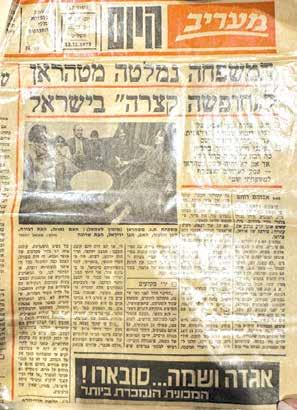
“One thing I’ve learned,” she shares, “is that we humans are inherently afraid of change. Starting over is challenging, particularly when it involves leaving behind our possessions and the people we love. However,” she
“I’ve come to realize that despite our fears, we possess a remarkable resilience.”
continues, “I’ve come to realize that despite our fears, we possess a remarkable resilience. We are capable of, and indeed do, adapt to new situations. Leaving our community, our synagogue, our school, and our loved ones was difficult, but we did it and we thrived despite (or maybe because of?) the difficulty.”
Another lesson Sharon maintains she has acquired is that having to uproot and relocate is the sad reality of the Jew. Sharon’s father was forced to leave his homeland twice.
“As Jews,” she reflects, “we are always in danger of being kicked out of the country we live in. Ultimately, I believe the safest place for us is Israel. I say that now even in the midst of a bloody war. My children are always begging me to move to Israel. My daughter made aliyah last November, and my other daughter is seriously thinking about making aliyah. Especially after the antisemitism we’ve witnessed and are witnessing in the United States today, there is no reason to feel secure here anymore.”
The Jew must always bear in mind, where will be the next place he can run to. Sharon’s grandfather warned her father when he arrived in the U.S. in 1979, “Always be ready, son, because you may have to move again.”
“In my opinion,” Sharon reiterates, “the next place to
run to has to be Israel. There’s no place else to go and it’s our home.”
Despite the difficulty they went through leaving Iran and setting up roots in America, Sharon says she believes they were meant to come here. It was all part of Hashem’s plan that they ended up in New York.
“Our five children were able to learn about their heritage, to go to yeshiva, to become the amazing spiritual, religious people they are today,” says Sharon. “For example, not a day goes by that my eldest daughter doesn’t post a lesson from Torah Anytime or from Rabbi Ashear on the family chat and the shul group chat. My middle daughter is involved in non-stop chesed. She works with babies born with serious issues and their families. And my youngest daughter who lives in Israel does kiruv. When one of my sons was in college, he attended Sh’or Yoshuv at the same time. Now that he’s working, he still maintains a chavruta and goes to weekly shiurim. My other son is a lawyer. He takes on pro bono cases for his fellow Jews. He’s told me on several occasions how his strong foundation in Gemara learning in yeshivah helped him in law school and his law practice.”
Remaining in Iran would have meant Sharon and her husband’s future generations might have drifted from religious observance. With most of the population traditional but not observant, what kind of homes could they have hoped to set up? Today, all of Sharon’s children and grandchildren not only are Torah observant, baruch Hashem, but are learned and knowledgeable.
Sharon concludes, “Of course, no one knows why anything happens for sure, but perhaps at least part of the reason that Hashem led us to settle in the Five Towns, where there’s a yeshiva every ten blocks and where our children could find and marry solid, frum Jewish partners, is so that we could ensure the continuation of our proud heritage and proud lineage as strong, G-d-loving Jews.”




Every Jew has a soul, an inner being that represents the Yid’s true essence. The neshama is a divine spark; a piece, so to speak, of G-d Himself. When we realize that a human being’s external “deficiencies” are merely layers within which an internal perfection is encased, we can begin to love all members of our nation.
Hashem gives every individual the exact resources and abilities needed to accomplish their mission in life, and in that sense, we are all equal. Regardless of our own personal challenges or life
circumstances, we each, without exception, have exactly what we need to make the world a better place.
The principle of valuing a person’s inner qualities and recognizing the fact that every individual has the potential to change the world encapsulates the remarkable mission of the Friendship Circle.
The Friendship Circle is an international organization that emphasizes the beauty of every Jewish soul, the importance of chesed, and the universal need for friendship. Through a wide range of programs, the Friendship Circle, with
When hashem gives someone a deficiency in one area, he gives them a special ability in another area. so why refer to them by their deficiency if you could refer to them by their special ability?
Every person in this world is here for a reason. Every day that a neshama comes to this world is something they have to do. a nd that applies to everyone, no matter what the person’s ability is, or lack of ability. hashem put that neshama there today, and there’s something for them to do. a nd it’s our job to help them shine.
you have to show the kid that you believe in them and that they could grow and they could be part of Klal yisrael. Chinuch, educating our kids, is the most important mitzvah because every little thing that happens in a kid’s life has an exponential effect on how it affects them as an adult.
help from volunteers, provides support to children, teenagers, and adults with special needs. But the Friendship Circle isn’t just an organization. Rather, with eighty-one branches throughout the world, it is, in the words of the nonprofit’s co-founder and executive director Rabbi Levi Shemtov, one big family.
While Rabbi Shemtov didn’t originally imagine himself founding and managing an organization meant to help people with special needs, he knew from an early age that he wanted to do something that would help the world. Growing up in Crown Heights, he found himself looking up to many people, including his father, who served as an advocate for the community, and his grandfather and several other family members, who were Chabad shluchim. But most of all, he felt a deep admiration for the Lubavitcher Rebbe. Rabbi Shemtov’s life-long dream was to become a shliach of the Rebbe.
“I got married two weeks before the histalkus (the passing) of the Rebbe. Before we got married, me and my wife, who shared my dream, got an apartment in Crown Heights, and we were planning to live near the Rebbe for a couple of years before becoming shluchim,” Rabbi Shemtov explained.
But when the Rebbe passed away in June of 1994, the young couple stopped waiting; instead, they decided to become emissaries of the Rebbe right away. Just two months later, in August, Rabbi Levi Shemtov and his wife Bassie moved to Detroit, Michigan, to pursue
their shared dream.
Rabbi Shemtov’s uncle, Reb Nachman Sudak, a”h, was the head shliach of the United Kingdom, but before he arrived in England, he asked the Rebbe: “What should I do when I get to London?”
The Rebbe replied, “There’s a thousand things you can do. And when you get there, you’ll figure out what needs to be done.”
“I guess this [the Friendship Circle] was one of the thousand things. The Rebbe never said anything about Friendship Circle, but it is one of the thousand things, because if you understand the Rebbe’s Torah and you understand the Rebbe’s guidance – if you go to a place and you’re looking for what needs to be done – this is what needed to be done,” Rabbi Shemtov said.
The Friendship Circle was originally created in honor of Danny Sobel, a likable young man who tragically passed away at the age of twenty-eight after suffering for years with mental illness. Before his tragic death in 1993, Danny Sobel was great friends with Rabbi Yitschak Meir Kagan, a”h, the associate director of Lubavitch of Michigan.
At Danny Sobel’s shiva, his parents told Rabbi Kagan that they would like to fund a project that would help “future Danny Sobels”; people who are at-risk. Eventually, the opportunity to start such a project was presented to Rabbi Shemtov, who was instantly interested in making the idea a reality.
“I heard about this opportunity, and I said I wanted to look into it. I was told:
‘Nah, you’re too ambitious for that…’ So, my wife and I talked about it, and we said: You know what? This is much bigger [than what it seems],” said Rabbi Shemtov. “What happened here? What was the relationship between Rabbi Kagan and Danny Sobel? On the outside, they had nothing in common. And yet, they had the most beautiful, profound relationship. And the reason for that was because Danny had so many labels attached to him, but he didn’t see himself for all those labels. Rabbi Kagan saw Danny for just his neshama.”
Set on starting the project, Rabbi Shemtov and his wife began asking the following question: “Who else would benefit from people seeing them for their neshama?”
The Friendship Circle, founded by Rabbi Shemtov and his wife, was originally focused on counseling individuals with mental illness and addiction, but it soon became clear to the couple that the organization could help a different group even more: children with special needs. And soon after, they had, what Rabbi Shemtov calls, an “aha moment.”
“My wife was a very good teen motivator. She was a good teacher, and she was motivating teens. So, we got it: let’s motivate teenagers to become friends with children with special needs,” explained Rabbi Shemtov. “The breakthrough moment for Friendship Circle was when we realized the success that we were having in recruiting volunteers. Volunteers were pouring in.
“What we realized was happening was that we discovered another part of the population that needs people to see them for their neshama and not for everything around them. And that part of the population is everyone else – all of us,” added Rabbi Shemtov. “The teens were so hungry for this relationship. Some of them came in for their community service hours…or because their

parents pushed them or peer pressure, but they stayed for the soul connection. When they have this pure relationship that they have with a child that they met at Friendship Circle, it’s real, it’s pure, and it’s strong, and they keep coming back for it.”
Soon enough, Rabbi Levi Shemtov and his wife Bassie realized that, because the Friendship Circle is a family, the organization should also support adults with special needs. After all, family is family regardless of age; there’s no reason to stop helping someone just because they’ve turned twenty-one. Thus, Rabbi Shemtov and his wife decided to conduct an investigation into how to best support adults with special needs. They began traveling the country to see how other organizations were helping adults, and they found two things in particular that interested them: 1) cafes and restaurants that employ adults with special needs, and 2) art studios that could serve as a creative outlet. The couple opted for the latter, and soon thereafter, an art studio was built for adults in the Friendship Circle.
One of the people who would often come to the art studio was Carly, a girl who had cerebral palsy. She was in a wheelchair, she couldn’t move her hands, and she couldn’t speak, but she wanted to be an artist. Thus, the people at the Friendship Circle attached a paintbrush to her foot and she was able to make a nice, simple drawing of a howling wolf. But when she expressed that she wanted to make a self-portrait, they didn’t know what to do.
“She used a thing called a Tobii, where the person’s eyes are tracked by the computer. And we realized that she types with her eyes, so maybe she can also draw with her eyes,” recalled Rabbi Shemtov. “So, the art teacher that we had there asked her, ‘Could I borrow your Tobii for a while?’ He was an ex-
This article is based on a podcast, “Inspiration For the Nation,” hosted by Yaakov Langer. To catch more of this conversation, you can watch it on LivingLchaim.com or YouTube.com/LivingLchaim or listen wherever you listen to podcasts (just search for “Inspiration For The Nation”) or call our free hotline: 605-477-2100.
perienced artist – thirty years – and he drew with his eyes something similar to a face – hardly.”
The art teacher taught Carly a few techniques and told her to not get discouraged if it takes her two years to draw something comparable to what he had done.
“Within two, three days, she drew a self-portrait. And six weeks later, she drew a piece that we sold at an auction. It was called ‘The Dancer in a Wheelchair,’” he said.
On one occasion, Rabbi Shemtov introduced a very wealthy donor to Carly, and she communicated with the man with her eyes. After the meeting, the donor told Rabbi Shemtov, “I can’t imagine how sad and depressed she must be.” Rabbi Shemtov responded: “She doesn’t rank anywhere near the top of the list of the saddest people I know – and all those people are able-bodied, wealthy,
successful people.”
One day, several people, including Carly, were having a conversation at the studio, when the following question was posed to the group: If you could be someone else for a day, who would you want to be? Everyone had an answer, except for Carly, who said: “I don’t want to be anyone else. I only want to be me.”
With locations in Israel, Canada, Australia, Brazil, South Africa, Puerto Rico, the United Kingdom, and the United States (including one in the Five Towns), the Friendship Circle is a family. Although it was founded in 1994, the Friendship Circle continues to this very day, nearly thirty years later, to bring joy and companionship to individuals with special needs, enriching lives all over the world.
Everybody needs a friend, and it is the Friendship Circle’s mission to make sure everybody has one.


Hi. I really enjoy reading your column each week, and I really like hearing from the wonderful columnists who offer sound advice.
My son is dating a wonderful girl. They are both youngish (he is 23 and she is 21). They are on their fifth date already, and we are very excited.
Yesterday, the shadchan called me up and asked me an interesting question. She told me that because the girl’s family is well-off, they ask each of their sons- and daughtersin-law to sign up a prenup before they get married. (The girl my son is dating is the fourth child to be dating in the family.) This not a halachic prenup, that some people do. She was talking about a financial prenup in case things don’t work out in the marriage.
My initial gut reaction was revulsion. I felt so grossed out that this was something on their minds, when their daughter was dating someone and liking them. Why are they thinking about if things don’t go well in the marriage? Also, although they are well-off, my son is not dating this girl because she has money. We heard wonderful things about this girl and so we decided to proceed with the shidduch. Why are they bringing money up at this time?
After I got off the phone, I spoke with my husband, and we both decided not to tell my son about this yet until we can see if there is a way to bring it up to him without any bias.
So here are my questions to you:
Is this something that you have heard of from people? Do people sign these prenups before marriage?
How do we get the bad tastes out of our mouths? The thought of this makes us uncomfortable.
Also, if we can figure out how to get comfortable with this, how do we present it to our amazing son in an uncomplicated, normal way?
I don’t blame you for feeling uncomfortable and having a bad taste in your mouth. As far as my experience goes, this is unusual. This is very concerning for this point in the dating journey even if you all think that five dates makes this close to a finish and you and your husband were excited.
Take this very, very seriously and look at this like a bright orange flag, if not a red one. Something is wrong if this is being proposed without them even getting to know you and your son well. And is money more important than a comprehensive prenup that would include halacha? The trust level you have in them is probably at near zero by now. They may want to break this shidduch up and are hiding behind safeguarding their dollars.
The shadchan should have refused to pass this message on. Where are her/his scruples? This should be done directly.
There is probably a whole lot more that you don’t know. Confirm your information from other mechutanim of theirs. Get your rabbi involved; he may be able to get some information that you will have trouble accessing. Find other sources. And if it is true, open up to your son and decide how to withdraw from this situation.
The topic of prenups has been a topic that has been abuzz around the frum world in the past year or so. I realize you are not talking about a halachic prenup, but even so. When a family is so well off to that degree, from what I have been told, it is considered irresponsible to avoid the issue. Although you and your son are very excited about this
match regardless of the family wealth, you have to recognize that there are families who are not blind to the elephant in the room.
As a shadchan, this is not a surprise. Her family must be extremely wealthy, and they have been advised on the steps to take for each of their children to put in place a safety net. If one is not in that financial bracket, I’ve been told, one cannot understand the pain and pressure which happens if there is no safety net. This has nothing to do with “predicting about the marriage ending” just as making a will is not predicting an impending death. It is merely a safety net to allocate funds a certain way so that the government does not have the full authority to do so.
I don’t think you should talk to your son about it, rather, if the shidduch progresses to engagement, sit with your future mechutanim and be open minded about it, and work it out through them.
As an aside, mazel tov on your son meeting a wonderful girl that he sees himself marrying. That is not a small thing!
Hmm, I completely understand all the “icks” and discomfort your experiencing. Anything related to finances in a relationship can often bring discomfort, tension, and conflict of values. I don’t have a lot of experience on the topic, but it’s a very, very important one. From my understanding, this topic lacks a lot of very important education and information within the Orthodox community. I think the most important piece to notice is that although finances feel emotional, it’s a very transactional decision based on protecting the parties involved. It may feel like it represents judgement, caution and distrust, but rather it’s each party planning for the worst case scenario to be cautious and prepared for any unforeseen circumstances.
Dr. Jeffrey Galler
There are three important issues here. Issue #1 – The idea of a prenuptial contract
A financial prenuptial agreement is rare, but not unheard of, in the Orthodox community.
I can understand why the girl’s affluent family feels strongly about this. The ugly reality is that in the United States today, 40% of first marriages end in divorce. In our Orthodox community, the percentage drops to around 10%, but that is still an ugly reality.
Their request fills you with revulsion, understandably. But consider how you would feel if the shoe were on the other foot. If your family happened to be fantastically wealthy, with great amounts of inherited wealth, you can be sure that your family’s lawyers and financial advisors would advise, very, very strongly, that your children’s potential mates sign prenuptial agreements.
In that scenario, it is likely that you, too, might be concerned about protecting your family’s legacy and request that your children’s potential mates sign financial prenups.
(Actress Zsa Zsa Gabor, who was divorced seven times, famously said, “I am a marvelous housekeeper. Every time I leave a man, I keep his house.”)
If you do proceed with this shidduch, make sure, of course, that your own lawyer looks over the prenup contract before signing!
Issue #2 – The girlfriend from a wealthy family
I am not that concerned about the unusual request for a prenup. I am, however, concerned about the girlfriend who grew up in a wealthy household.
You write that you “heard wonderful things about the girl,” but please be careful. After marriage, is she going to feel “entitled,” and demand that your son continue to support her at the same level that she was supported by her Daddy?
Will she be very high maintenance?
Look at this like a bright orange flag, if not a red one.
Will expensive vacations be a requirement? Will she expect a closet for her shoe collection, that is larger than your son’s current bedroom?
(A good friend of mine – B.K. – told me a relevant story. Years ago, an accountant friend of his proudly told his date that his firm pays him $9,000 a month. His un-impressed, high maintenance girlfriend replied, “I spend $10,000 a month.”)
Will your son be earning a decent salary? Will he be dependent upon the generosity of his in-laws? Will his in-laws treat him like they “own” him?
Besides doing your own research, it might be advisable to suggest that your son double date with his girlfriend’s sisters and husbands. He can personally evaluate their family dynamic.
Issue #3 – The way to present this to your son
If you (and your son) determine that this young lady and this shidduch would be wonderful, you will need to utilize great sensitivity in discussing the prenup issue with your son.
You will need your very best motherly skills to avoid causing your son to permanently dislike his in-laws. The threshold for getting upset with in-laws is much lower than with one’s nuclear family.
Help your son understand the issue from the perspective of the girl’s parents. Do everything in your power to avoid causing an unnecessary, unpleasant, lifetime of animosity and feuding.
In addition to all your other motherly jobs, it is your job to keep shalom in the family and ensure that everyone gets along lovingly.
(If you succeed in creating harmonious relationships, your children will never feel a need to relate the old joke: “Adam and Eve were the happiest, and the luckiest, couple in history. Neither of them had in-laws.”)
Dating and Relationship Coaches and Therapists
Thanks for writing! I can certainly understand how this would leave a bad taste in your mouth. Here everyone is looking at the prospect of marriage and a lifetime together, and your son’s potential in-laws are talking about assets, protection and divorce.
With that being said, I encourage you to take a deep breath and not
throw out the baby with the bath- water or this prospective shidduch. Of course your son is not dating this girl for her money and this isn’t something that impresses you all that much either, but there are some people who do specifically look for affluence and lifestyle.
Putting yourself in their shoes, let’s try to give them the benefit of the doubt and imagine they are simply trying to protect their daughter from being taken advantage of or used for the family’s finances.
With that being said, I recommend calmly asking to see the prenup agreement and having an attorney review it. Commenting on anything legal is outside the scope of my practice. I do recommend you meet with an attorney to review the prenup and make sure you understand.
With regard to your son, I think when you feel calm, you present this
Consider how you would feel if the shoe were on the other foot.
very factually without putting his potential in-laws down or painting them in any sort of light. You then explore with your son how he feels about the prenup.
Wishing you the best, Jennifer
Jennifer Mann, LCSW is a licensed psychotherapist and certified trauma healing life coach, as well as a dating and relationship coach working with individuals, couples, and families in private practice at 123 Maple Avenue in Cedarhurst, NY. To set up a consultation or to ask questions, please call 718-908-0512. Visit www.thenavidaters.com for more information. If you would like to submit a dating or relationship question to the panel anonymously, please email JenniferMannLCSW@gmail.com. You can follow The Navidaters on FB and Instagram for dating and relationship advice.
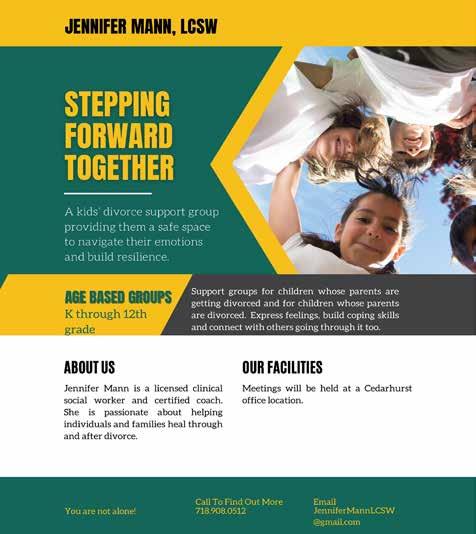


Iwas recently talking with the mother of a local teen regarding her child’s upcoming Pesach vacation schedule. It’s a tough balance. Pesach requires extensive physical preparations and cooking. Teachers, too, need time at home to prepare their families. But our children’s learning is important, and we don’t want to waste precious school time.
Each school has its own schedule, often with different grades having their own Pesach vacation start dates. The
average person may think of many reasons why schools begin vacation when they do. “Well, the teachers need more time at home to prepare.” “Keep the kids in school longer, the little ones are underfoot.” “Take the kids out of school earlier – we need their help!” Then you have many arguing for separate rules for boys’ schools from girls’ schools.
While we’ve often hear about the importance of kids helping out at home, there has been a lot of concern that many children are becoming bored by


the extended break. For families that are going away, there may be little work for the kids to do.
Children need a balance of free time and structure. Everyone needs time to themselves, and children thrive being given the opportunity to just be kids. Let them run in the grass, jump rope or read a book. Like adults, children also require structure. They need to wake up, go to sleep and eat at normal times. Every child has their own balance, with some kids becoming bored from too much freedom and others feeling pressured from too much outside work.
I don’t want our readers to think I am telling the schools what to do or how they should arrange their calendar. They certainly don’t need my help nor is it my place. This article is geared towards helping families maximize the time their child is home. Regardless of their Pesach plans, parents will decide what’s best for their child. The important part is for parent to plan in advance and have an idea of how their child will spend this time.
Pesach is a major holiday, both in importance and preparations. Often, parents need everyone’s assistance. Additionally, Pesach preparations are part of the yom tov and enhance the holiday for those that have contributed. Chessed begins at home, and there are many ways for even the youngest of
children to feel like they’re contributing. Older children, in particular, can make a meaningful impact on the to-do list.
Children don’t fully understand our intentions when we say “clean the counters” or “check the coat pockets.” It’s helpful to give clear directions for each task. “Use this cloth and cleaner to wipe down each of these counters. Here, I’ll show you.” “Stand over a garbage pail and turn each pocket inside out. Brush all the crumbs into the pail –like this.” It’s best to demonstrate each step. Things that seem obvious to us –such as putting crumbs into a garbage bag and not the floor – are not so clear to children. Also, mention if you would like items to be put away afterwards.
Children are still learning how to do these yearly tasks. They will not do them exactly as you like nor in the best way possible. It can be difficult to step back and accept a poorly done job, but it’s important to give our children the opportunity to learn and feel proud of their accomplishments. Praise the work they’ve done – even if you need to make some changes. This refers to children that worked hard and not children that were intentionally lazy.
While it’s true that children should help their parents without any other rewards, it’s my humble opinion that it’s best to show appreciation to our helpers. Not only does it show gratitude, it also adds some excitement and enhances their Pesach memories. Rather than picturing Pesach as feeling like slaves, they
can remember the fun well into adulthood. Whether it is a prize for working hard or a surprise pizza party for lunch (instead of the original tuna and crackers), children can – and should – associate Pesach with joy.
There are many reasons why a parent will not need their child’s help. Many families go away, most to visit other family members and some to official programs. Young couples, in particular, will stay with their parents. For many families, Covid was the first year they remained home. Suddenly, they had to learn how to prepare their homes and cook and purchase all the items for Pesach.
For these families on the go, there may be little for the children to do during the pre-Pesach vacation period. These children may find themselves bored or underfoot.
This is the perfect time for older children to assist their neighbors or other family members. Perhaps the grandparents could use someone to carry up the Pesach dishes or peel potatoes. Maybe a neighbor’s toddler is
bored, and your child can play games with him. The many organizations that distribute Pesach provisions may need a few extra helpers. More than just fighting boredom, this time can be meaningfully spent and give a child the chance to recognize how much they can accomplish in their “spare time.”
them. Remember, this should be pleasant for your child.
More children are out and walking during vacation periods. Drivers need to be extra careful, especially around shop -
It’s important to give our children the opportunity to learn and feel proud of their accomplishments.
Your child’s needs come before others. Please make sure the situation is a safe and comfortable one for your child before they set out. Know who your child will be with and provide supervision for them. All tasks should be age appropriate. Adults that are unfamiliar with your child or their capabilities can inadvertently assign them too many jobs or ones that are too challenging for
ping areas where kids tend to gather in large groups and be less aware of their surroundings.
Please remind your child to never read or play on their phones when they’re walking. It’s upsetting how many children walk right into traffic because they are oblivious of their surroundings. Teens should keep their devices off or in their pocket when they’re on the move.
It sounds ridiculous to say, but please remind your children – even teens –how to safely cross the street. Even with phones out of sight, I’ve seen an alarming number of children and teens walk right into the street, completely unaware.
Biking is a healthy and enjoyable way to travel. Helmets need to be worn at all times and bikers of all ages must obey traffic laws.
Motorized bikes and scooters can be dangerous, both for riders and pedestrians. Please carefully evaluate if your child is ready to ride them.
Pesach is a special time for our nation. Together we celebrate becoming a united people, devoted to our divine purpose. Rather than the “suffering” many associate with Pesach preparations, this busy time should be enjoyable for all of us. Enjoy the extra time with your children, and may we soon experience the ultimate geulah.
Sara Rayvych, MSEd, has her master’s in general and special education. She has been homeschooling for over 10 years in Far Rockaway. She can be contacted at RayvychHomeschool@gmail.com.


Q:Dear Etti, I have been meaning to write for a while. Now is as good a time as any. I hope you can respond.
My second grade daughter came off the bus distraught that Hashem is mad at her. Turns out that her teacher saw her take a bite from an apple without a bracha. While I agree that she should have said a bracha, I am not sure that telling her in a stern voice that Hashem is angry at her for stealing was the correct approach. My older daughter, a seventh grader, said that they are routinely told that it is their fault Moshiach is not here yet. I remember my son coming home one year with stories of fire and brimstone and Gehinnom.
I know not every teacher talks like this, but even one is too many. I am not in chinuch and have tons of respect for those who are. Am I wrong to think that teaching Torah should be done through Ahavas Hashem, not Yiras Hashem?
- Worried
A:Dear Worried, I am sorry to say that you are totally correct. Whether it is parenting or teaching, adults who use aggression or an authoritarian style to control children are ineffective. While it might solve short-term problems of asserting control or getting compliance, in the long term, it backfires.
Once upon a time, adults thought scaring children worked. Whether it did or did not can be debated, but adults routinely threatened children into compliance. Paddling was a recognized form of discipline in schools. Yelling was accepted as a “normal” reaction to what was labeled bad behavior. Threatening children with horrible future events if they behaved in a certain way was commonplace. (“If you make that face, your face will freeze that way.”)
These responses may solve the issues in the short term and the bad behavior will perhaps stop when the
adult is around, but it will probably continue out of sight. Dr. Rick Lavoie, in his famous video “When the Chips are Down” (relevant today even though it was first presented in 1996) reminds us that positive feedback actually can change a child’s behavior and motivate them to continue to improve while negative feedback only stops the behavior for now.
Through love and acceptance, a sense of
“I believe in you,” and “it’s OK to make a mistake,” we can accomplish so much more.
Karen Quail, a parenting expert who runs Peace Discipline workshops, explains “that the aim of being coercive is to scare the child so much that the child will feel forced into doing what you want them to do.” There is an obvious problem with that approach. “This kind of discipline does not help your child be more cooperative and respectful; instead, it’s undermining what you’re trying to do in your discipline and is more likely to have negative results.”
When it comes to Yiddishkeit, however, the problem is much bigger. A child might write off Hashem and His Torah, chas v’shalom, due to such a coercive approach, as the child will be unable to separate the well-meaning but misguided adult’s approach from the religion itself.
Through love and acceptance, a lesson we see again and again from so many of the Gedolim’s biographies and articles that are published weekly, a sense of “I believe in you” and “it’s OK to make a mistake,” we can accomplish so much more.
Be the role model your children need, and revel in the fact that your children feel close to you to tell you when something doesn’t feel right, so you can gently correct the message imparted.
Be careful not to put down the adult even as you correct the message, as that will model other troubling behaviors (like speaking negatively about our teachers,
judging, etc.) that we do not want to impart to our children.
Hatzlacha, - Etti
Q:Dear Etti, My daughter is in sixth grade, and she hates learning Chumash. It hurts me to hear her moan and groan about doing Chumash homework or reviewing the pesukim for a test.
Any ideas?
- Loving Torah
Dear Loving Torah, As soon as we made Chumash into a subject in school we ran the risk of treating it like any other subject that one can moan and groan about.
Can you make sure that her distaste for the subject does not affect her feelings for the Torah itself? There are so many wonderful children’s parsha books out now that you can buy or borrow and have in the house that even a sixth grader will find interesting. There are so many shiurim and podcasts that could be playing in your house or car in the background, and so many “pull quotes” you can share over supper or a seudah. They don’t have to be long, but they do have to be interesting. It is even better when your children heard your story or vort already and can excitedly fill you in on what they know!
The positive messages about Torah and the atmosphere in your home can negate any negativity she feels about the subject.
Don’t leave educating exclusively to the educators!
Have a good yom tov,
- EttiMrs. Etti Siegel holds an MS in Teaching and Learning/Educational Leadership and brings sound teaching advice to her audiences culled from her over 35 years of teaching and administrative experience. She is an Adjunct at the College of Mount Saint Vincent/Sara Shenirer. She is a coach and educational consultant for Catapult Learning, is a sought-after mentor and workshop presenter around the country, and a popular presenter for Sayan (a teacher-mentoring program), Hidden Sparks, and the Consortium of Jewish Day Schools. She is a frequent contributor to Hamechanech Magazine and The Journal for Jewish Day School leaders. She will be answering your education-based questions and writing articles weekly for The Jewish Home. Mrs. Siegel can be reached at ettisiegel@gmail.com.

Before you know it, you will be sitting down for the Pesach Seder. We will be surrounded by all the delicious food and desserts, some so tasteful they even taste like chometz. However, as with any holiday, it can also be a time of overindulgence, with tasty foods and treats tempting us at every turn. Here are some easy tips to help you stay on track and feel your best this Pesach.
Erev Pesach is a pretty busy day from finishing your last bites of chometz to biur chometz to finishing up the last minute things around the house. Regardless of how busy you may be, making yourself a priority and fueling your body is key. It’s important you make sure to eat all your meals, especially the day of Pesach. Having the mindset to save your calories for later will backfire, causing you to overeat later on. Studies have shown that skipping meals can be a predictor of weight gain/ overweight and obesity. Aim to eat a high protein breakfast, which will help set your day up for success by giving your body the energy it needs. Some high protein breakfast ideas include a vegetable omelet with whole wheat toast, oatmeal topped with fruit and chia seeds, and a yogurt parfait, which are all quick and easy breakfast ideas to start your day off with success.
While you may be running around and pretty preoccupied, make sure to sit down for lunch, as the Seder does not start until very late. Another recommendation is having something small before yom tov such as a protein like chicken or soup, as to not go into the seder famished.
The Sedarim are a really special time, so try being patient and staying present. After eating all the matzah and wine, you will probably be pretty full. I’m sure there will be delicious food served whether you are home or away. Be in tune with your body and eat until you are satisfied; you don’t need to try everything on the table.
Chol Hamoed usually involves exciting trips and are a memorable time. Some people may find it trickier to eat healthy while away all day, understandably so. Firstly, always remember to pack your snacks. No one wants to be hungry or around people

who get “hangry.” Waiting too long between meals will only cause you to overeat later on. Additionally, packing snacks will help you have more energy which is most needed if you’re going to be out all day. Some snacks that are easy to prepare and pack are hardboiled eggs, string cheese sticks, avocado, fresh fruit, and sliced vegetables.
on a slice of whole wheat matzah or crackers, or a chicken or turkey salad.
During any holiday, it can be easy to slip into a sedentary lifestyle, spending hours sitting at the table or relaxing with family and friends. However, staying active is important for both your physical and mental health. Try to incorporate some physical ac-
While it’s important to stay on track with your health goals over Pesach, it’s also important to practice moderation.
Meal prep ahead of time so it’s not too overwhelming. You can prepare tuna ahead of time for sandwiches, wash and check the lettuce for salads (or buy prechecked), and boil hardboiled eggs and keep in the fridge. Prepping ahead of time will make eating healthy less stressful.
Remember, balanced meals are key. Some healthy lunch ideas are salmon with roasted vegetables and a baked sweet potato, a hardboiled egg salad, vegetable tuna
tivity into your day. Take a walk after your meals and try to get some fresh air, which is both mentally and physically healthy. If you are traveling to a warm place, then you should definitely be taking advantage of the weather. Go for a swim, bike – move your workouts outdoors. Exercise has endless health benefits. From weight loss to reducing the risk of certain diseases, being physically active is key. Especially after eating so many meals and sitting around,
physical activity is so important. Exercise helps reduce anxiety, stress, and enhances your overall mood. If you are feeling overwhelmed over the long holiday, get outside!
Staying hydrated in general is always imperative but especially over Pesach and with the warmer weather ahead. Drinking plenty of water can help you boost your metabolism and keep your energy levels up. With the abundance of food being served, most contain higher sodium content than usual, so be extra mindful to stay hydrated. Studies have shown that meals that contain higher sodium may lead to increased hunger and overeating. Start drinking as soon as you wake up; don’t wait until the end of the day to take your first sip. Drinking enough water also helps improve your mood and sleep quality. Try aiming for at least 8 cups of water daily.
While it’s important to stay on track with your health goals over Pesach, it’s also important to practice moderation. Don’t restrict yourself too much. Telling yourself that something is completely off limits will only make you want it more. Allow yourself to have some of your favorite food or treats, but in moderation. One or two pieces won’t ruin your progress. Try to stick to a healthy balance of nutritious foods and listen to your body’s hunger cues. Try to get in exercise, even if it means you can only do a little bit. A little bit is better than nothing. Exercise is an incredibly healthy outlet that does wonders for you mentally, so whatever you can do, do it.
As I always say, the most important thing is to remember to be present. Yom tov comes and goes so quickly so it’s important to just enjoy all the wonderful moments.
Have a beautiful Shabbos and Pesach!
Tehila Soskel is a registered dietitian nutritionist with a private practice in the Five Towns. She sees clients for weight loss, diabetes, and other various diseases. Appointments can be made for in-person or virtual sessions: 516-457-8558, tehilasoskelrd@gmail.com, tehilasoskelnutrition.com.


Pesach is coming, and we look forward to gathering around the Seder with the various generations: parents, grandparents, cousins, grandchildren, and so forth. We celebrate Pesach, drink the four cups of wine and keep all the wonderful mitzvos of this special yom tov. We share the story of Yetzias Mitzrayim.
As Abie Rotenberg’s “Memories” song from Journeys: Vol 2 goes: What will become of all the memories?
Are they to scatter with the dust in the breeze?
And who will stand before the world knowing what to say?
When the very last survivor… fades away…
Some are on the sidelines, listening, and need to be drawn out and engaged in conversation. Others try to reminisce and no one really listens. Or even worse, no one asks.
Now that I’ve been in the category of “grandparents” for some time now, I note the value in sharing and listening. Regardless of whatever role I take, storytelling or story listening or bystander, I’m more sensitive to time passing.
My desire to capture the moments in speech, picture, song or prose is more intense.
As a child, I was one of the few who had grandparents. Most of my friends’ bubbies and zeides had passed away in the Holocaust, and my friends’ parents had emigrated to the U.S. to start new families. My grandparents each survived the war and traveled to the U.S. with their children – my parents – in the late 1930s and early 1940s, respectively.
Many of my friends tell me that they didn’t grow up hearing stories about the Holocaust from their survivor parents. Aside from the stamps their parents had on their arms indicating their years in concentration camps, there was little proof that they had experienced atrocities. These survivors were reticent to share their horror stories with their children and grandchildren.
Some open up more willingly. In his later years, my father-in-law, who passed away in 2001, freely shared stories of how he and his brother escaped from Poland, and my husband and his siblings lapped up these stories.
Children ask a lot of questions, but adults don’t always want to prod. They
may wonder, do the elders really want to talk? Are their memories really accurate? Is this act of eliciting reminiscence really for their catharsis or therapeutic benefit? Or is it for us so we can record it all for posterity? How do we know if we are being sensitive to their needs?
Both my father, a”h, and mother, may she live till 120, survived the Holocaust. One thing that sticks out in my memory is my father telling us bedtime stories about his childhood in Antwerp before the war. A few years before his passing, my brothers recorded him as he spoke on tape about some of the more fascinating escape stories, leaving Belgium and France and coming to the U.S.
As the sandwich generation, it is up to us to make sure we don’t miss the chance – whether formally or informally – to have these important conversations with the older generations. The message of Pesach is to delve into our memories to benefit ourselves and the next generation. Later we may regret those missed moments and conversations. And with that knowledge, let’s share with our grandkids our values and heritage, and let’s glean wisdom from our elders. Take out a pen and paper, pull out
the phone’s recording app and document your parents’ or grandparents’ voices. Then take those thoughts and consider writing down your own memories. Make a collage or scrapbook using old pictures. Interview them, tape them and send a link of the memories to the cousins.
Back to Abie Rotenberg: There’s nothing I can say or do to make this change…
Time has a way of passing by so fast…
And like a fleeting shadow, no one will recall… the faces of the past…
Whatever generation you’re part of – the Baby Boom, Gen X, Millennial or Gen Z – there’s so much to learn from each other. Know that and act upon it. Your grandchildren will thank you for it. An original version of this piece appeared in Los Angeles Jewish Home in 2022.
JWOW! is a community for midlife Jewish women which can be accessed at www.jewishwomanofwisdom.org for conversation, articles, Zoom events, and more.
Miriam (Pascal) Cohen understands your life. She knows how much work goes into Pesach preparations and, especially, Pesach cooking. She knows that the best Pesach recipes are about balancing beloved traditions with surprising innovation, for delicious meals that fit your lifestyle.

Pareve
Yield 2 pies, 6-8 servings each
The first yom tov i spent with my in-laws was rosh hashana, which means that i didn’t have to wait long to be introduced to a beloved family favorite: my mother-inlaw’s leek pie! she serves it for one of the rosh hashana simanim, but with a little tweaking, i turned this delicious family favorite into a perfect Pesach side dish that presents beautifully and freezes well, too!
Ingred I ent S
Caramelized Leeks
• 2 Tablespoons olive oil
• 1 onion, diced
• 2 teaspoons kosher salt
• 6 large leeks, white and light green parts only, cut into half-moons
• 6 cloves garlic, minced
• ½ teaspoon ground black pepper
Batter
• 6 eggs
• ½ cup oil

• ½ cup potato starch
• 1 teaspoon kosher salt
• 1 teaspoon ground black pepper
Pre Parat I on
Prepare the caramelized leeks: heat oil in a large, deep frying pan over medium-high heat. add onion and salt. cook, stirring occasionally, for about 5 minutes, until softened.
add leeks, garlic, and pepper. reduce heat to medium-low; cook, stirring occasionally, for at least 15 minutes, preferably 30 minutes, until leeks are golden in color. set aside to cool.
Prepare the pie: Preheat oven to 350°F. Grease 2 (9-inch) round pans well; set aside. in a large bowl, whisk together eggs, oil, potato starch, salt, and pepper until combined.
add cooled leek mixture. stir to combine. Divide mixture between prepared pans. Bake for 35-40 minutes, until the tops are golden brown.
Plan ahead
leek pie can be frozen, well wrapped, until ready to serve. reheat, covered, until warmed through.


Meat
Yield 6-8 servings
When i think of Pesach food, it’s hard not to think about caramelized onions. When i was growing up, we didn’t use any spices on Pesach other than salt and pepper, so i learned from my mother to coax the maximum amount of flavor out of all the fruits and vegetables we cooked with. This melt-in-your-mouth flanken really doesn’t need much to be perfect. Just a heaping ton of onions and a whole lot of time in the oven makes for the most extraordinary meat you’ll enjoy all Pesach long.
Ingred I ent S
• 6-8 strips bone-in flanken
• kosher salt, for sprinkling
• ground black pepper, for sprinkling
• oil, for searing
• 2¼ cups caramelized onions (from 3 onion; page 264)
• 1 cup dry or semi-dry red wine
• 1-inch fresh ginger, minced, or 2 frozen ginger cubes
• 2-4 Tablespoons sugar, optional
Pre Parat I on
Preheat oven to 275°F. Prepare a large baking dish.
sprinkle salt and pepper very generously over the entire surface of the meat. Turn meat; repeat on the second side.
in a large frying pan, heat oil over high heat. add flanken; sear for 1-2 minutes per side, until the outside is nicely browned. Place into prepared baking dish. spread caramelized onions over the meat.
in a small bowl, combine wine, ginger, and sugar (if using); pour over the flanken. cover tightly; bake for about 5 hours, until fork-tender.
Plan ahead
This flanken freezes nicely, well wrapped. rewarm, covered, until heated through.
Var I at I on instead of flanken, you can use other cuts of meat that work well with a low and slow cooking method, such as second cut brisket, minute steak or minute roast.



recipes reprinted from Real Life Pesach Cooking by Miriam (Pascal) cohen, published by art scroll.
Pareve
Yield about 4 dozen
how many batches of a recipe must one bake to call it the “ultimate”? i don’t know, but i am pretty sure i passed it with these cookies! Because my year-round chocolate chip cookies are my ultimate, most famous, and most popular recipe, i knew i needed a Pesach cookie to rival it! i tried so many times, scrapped so many ideas and batches, until finally i was satisfied that i am indeed sharing the Ultimate Pesach chocolate chip cookie recipe with you. Try these and i’m confident you’ll agree!
Ingred I ent S
• 1 cup oil
• 1 cup brown sugar
• ½ cup sugar
• 1 egg
• 1 egg yolk
• 2 teaspoons vanilla extract
• 1 teaspoon baking soda
• ½ teaspoon baking powder
• ½ teaspoon sea salt
• 1 cup ground pecans
• 2 cups potato starch
• 2 cups almond flour
• 1 (9-oz) bag chocolate chips
Pre Parat I on
Preheat oven to 375°F. line 2 baking sheets with parchment paper; set aside.
in a large bowl, whisk or beat together oil, brown sugar, sugar, egg, egg yolk, vanilla, baking soda, baking powder, and salt until combined and creamy.
stir in ground pecans, potato starch, and almond flour to form a cohesive dough. stir in chocolate chips.
roll heaping tablespoons of dough into balls. Place on prepared baking sheets. Bake for 9-10 minutes, until the tops are set.
Plan ahead
cookies can be frozen, well wrapped, until ready to serve.
Var I at I on S
you can bake these in numerous other forms, adjusting the baking time as needed.
cookie sticks: 20-25 minutes.
cookie pie (inside a Pesach crust): about 35 minutes.
Jumbo cookies: 12-14 minutes.
9x13 bars: about 35 minutes.
 By Naomi Nachman
By Naomi Nachman
This recipe went viral a few years back, and I thought it would be perfect for Pesach if you substitute the rice for cauliflower! It’s a great light lunch or dinner, and you’ll be wanting to make it all year.
◦ 4 salmon fillets, skinless (about 2 pounds)
◦ Olive oil, for drizzling
◦ Salt, for seasoning
◦ Pepper, for seasoning
◦ 2 14-ounce packages Riced Cauliflower
◦ 2 tablespoons oil
◦ 1 teaspoon salt
◦ 3 tablespoons kosher l’Pesach imitation soy sauce or coconut aminos
◦ 1-2 tablespoons sriracha sauce
◦ 4 tablespoons mayonnaise
◦ 1 avocado, sliced
◦ Roasted seaweed, cut into matchsticks
◦ French-fried onions, for garnish (optional)

1. Preheat oven to 350°F.
2. Place salmon on a baking sheet lined with parchment paper. Drizzle with olive oil and sprinkle with salt and pepper. Bake for 25 minutes. Remove from oven and allow to cool. Transfer salmon to a bowl and flake it with a fork.
3. While the salmon is cooking, prepare the cauliflower rice: In a large frying pan, heat the oil. Add the cauliflower and sauté until lightly brown. Add one teaspoon salt and stir. Remove from heat and transfer to a bowl.
4. Add flaked salmon, soy sauce, sriracha, and mayonnaise. Mix together with a fork, mashing the salmon as you mix. Serve with slices of avocado and pieces of roasted seaweed. Garnish with French-fried onions, if desired.
MizrahiNaomi Nachman, the owner of The Aussie Gourmet, caters weekly and Shabbat/ Yom Tov meals for families and individuals within The Five Towns and neighboring communities, with a specialty in Pesach catering. Naomi is a contributing editor to this paper and also produces and hosts her own weekly radio show on the Nachum Segal Network stream called “A Table for Two with Naomi Nachman.” Naomi gives cooking presentations for organizations and private groups throughout the New York/New Jersey Metropolitan area. In addition, Naomi has been a guest host on the QVC TV network and has been featured in cookbooks, magazines as well as other media covering topics related to cuisine preparation and personal chefs. To obtain additional recipes, join The Aussie Gourmet on Facebook or visit Naomi’s blog. Naomi can be reached through her website, www.theaussiegourmet.com or at (516) 295-9669.
This column features business insights from a recent “Mind Your Business with Yitzchok Saftlas” radio show. The weekly “Mind Your Business” show – broadcasting since 2015 – features interviews with Fortune 500 executives, business leaders and marketing gurus. Prominent guests include John Sculley, former CEO of Apple and Pepsi; Dick Schulze, founder and Chairman Emeritus of Best Buy; and Beth Comstock, former Vice Chair of GE; among over 400+ senior-level executives and business celebrities. Yitzchok Saftlas, president of Bottom Line Marketing Group, hosts the weekly “Mind Your Business” show, which airs at 10pm every Sunday night on 710 WOR and throughout America on the iHeartRadio Network.
Since 2015, Yitzchok Saftlas has been speaking with leading industry experts on the “Mind Your Business” show, sharing insightful business and marketing strategies.
In this article, we’ve gathered five examples from non-profit leaders who have leveraged for-profit business techniques to propel their organizations toward success.
TreaT DonaT ions Like sT ock Maury Litwack, Founder and CEO of Teach Coalition
One of the great educators in fundraising was a guy named Jerold Panas, who wrote very insightful books. One interesting thing that he wrote about was the need for board members to give donations to their own board, because it’s similar to a stock market company, or a publicly traded company, looking at how much insider buying occurs. For example, if Jeff Bezos were to buy a lot of Amazon stock, you would say, “What does he
know that I don’t?” It builds intrigue and gives outsiders confidence in regard to buying in. When Elon Musk announced that he would not be selling any more Tesla shares for two years, that was a major confidence boost for the investors. So, I think what Panas is saying is also very important from the perspective of running your non-profit like a business. As much as donors are investing money with their heart, you owe them a balance sheet. You owe them transparency and accountability like a business. This will help you build a strong and long-lasting relationship with your board and major donors.
Don’ T Manage
By a nec D o T e
Allen Fagin, Former Executive Vice President of the Orthodox Union
Many non-profits tend to manage by anecdote. Meaning, that we hear from a program participant, a beneficiary, or their parents, “We were so blessed to be able to participate in your program. It was great.
The staff was fantastic. We got so much out of it,” and we pat ourselves on the back and use this anecdote as a measure of our success. I think that this is a mistake. Maybe we are doing a terrific job, but we can’t truly know that solely based on those notes and calls that we receive. Like a business, we need to be much more objective and introspective when it comes to measuring our success. We need to take a careful look at ourselves in the mirror and ask, “Is every penny that we’ve spent being spent well? Is every program that we’re running being run in an optimal way? Is every program that we’re running meeting the needs of the population that it was designed to serve?” And if we’re not constantly asking those kinds of questions, and insisting that we continuously do better, we’re not serving the populations that we need to be serving appropriately.
Think aB ou T your sharehoLDers
David Mandel, CEO of Ohel Children’s Home and Family Services
If you’re in charge of a non-profit organization, just like in a business, you have a responsibility to your shareholders. Those shareholders are your board of directors, your donors, your benefactors, the people that you serve, etc., so you have to manage it like a business. The underpinning of business education is that there is only one goal the CEO of a company has. And that goal is return on shareholder value. To the extent that you can increase the profit, the quarterly earnings, and the stock price of your company, you’re a star. So, how does that translate into public service? At first glance, it doesn’t. The IRS doesn’t permit IPOs (Initial Public Offerings) in the non-profit sector, meaning that they can’t list their shares on a stock exchange. But, I posited to my friends on Wall Street that perhaps in non-profits, the return on shareholder value is the good feelings that you get from seeing people get better, being able to know that you’ve made a difference in the world. I asked my friends on Wall Street, on that basis, if would it be possible to invest in the public sector, for organizations like Ohel. They told me, “It’s a very nice thought, but that’s just not how we sell IPOs.” Lo and behold, years later, someone out of Harvard worked out a similar method that has allowed us to now issue IPOs in the non-profit sector.

There’s a famous chart that was created by Susan Kenny Stevens called, “Non-profit Lifecycles.” In this chart, she shows that the easiest dollars to raise in the fundraising process are the first dollars and the last dollars, because people are excited by the idea of being the ones who help start a project and being the ones who help finish a project. It’s in that middle section where the money becomes hard to raise. In the beginning, people are excited. They want to be entrepreneurial and get involved in this new cause, so you don’t really have to worry about publicity or marketing. But, as we reach this middle portion, we have to switch to the more for-profit mindset of asking ourselves, “What do we do when we reach our peak of activity, to either
continue that peak or expand even further?” Like a business, you have to ask yourself, “What potential targets are not
Someone who had been working in the non-profit world for some time once told me that “there are a lot of folks
In non-profits, the return on shareholder value is the good feelings that you get from seeing people get better.
yet involved that we can bring in?” This is what will help your organization continue to thrive and grow, as that initial novelty for donors begins to wear off.
Learn T o Manage your Mission
Chip Paillex, President and Founder of America’s Grow-a-Row

who have great missions, but they don’t know how to market or manage them.” And that’s really true. There are a lot of organizations out there that have great intentions. But, without that necessary business acumen, you just aren’t going to get very far on good intentions alone. I would argue that running a non-profit organization is much more difficult than running a for-profit company. Remember, in the non-profit world, there’s no revenue attached to the products you’re producing or the services you’re providing. So, it’s a very different model, but some of the principles are very much
the same. Some of the key transferable skills I would say are networking, maintaining communication, and building up relationships with your donors, just like a business would with their clients. These are the business skills that will help your organization survive and thrive.




Since this government was formed, the Left has not given it peace. The protests, the violence, the court. They have not allowed the government to govern from day 1.
- Likud MK Minister David Amsalem in an interview with Kol Chai Radio
I thought that something would change after Simchat Torah, and it changed for a short time, but the Left continues its path of blocking roads and creating anarchy.
- Ibid.
We are fighting on two fronts: There are over 80,000 people who are not at home, and the Left remains unmoved. We will defeat Hamas, and after that we will deal with all of the weeds who are not allowing the State to function. They formed a movement and planned to burn down the Prime Minister’s home – people who were in the defense echelon, and you don’t hear the Attorney General saying anything about that –only when it pertains to Charedim. Their goal is not to enlist the Charedim but to bring down the government.
- Ibid.
Next Monday, a solar eclipse will totally block out the sun over parts of America, and we’re all looking forward to having one brief moment when you can look up into the sky and see something besides the door of a Boeing airplane plummeting to the ground.
— Desi Lydic, “The Daily Show”
[AOC’s] jurisdiction looks like a third-world country... I wouldn’t let her manage a candy store.
- Shark Tank’s Kevin O’Leary talking about Rep. Alexandria OcasioCortez (Dem/Socialist-NY), on Fox News

There’s a silent majority that remains committed to the U.S.-Israel relationship. I think people have to be careful not to mistake the astroturf for the genuine grassroots.
- Congressman Ritchie Torres (D-Bronx), who is a staunch supporter of Israel, in an interview with the Times of Israel during his recent trip to Israel
I think we have to be careful not to mistake a visible vocal minority, amplified on Twitter, for a majority. My overarching message to the Israeli people is that Israel is not alone. Despite the background and the ways of American politics, the majority of America stands with Israel, the majority of Congress stands with Israel. You might never know that if you live on Twitter, but Twitter is not the real world. It’s a distortion of reality.
- Ibid.
If you drink too much or you eat too much or you walk too much, if you do too much of anything, you are going to suffer eventually.
- Englishman John Tinniswood, 111, who just became the world’s oldest living man
There are no innocent citizens there.
- Released hostage Nili Margalit, 42, in an interview with a French newspaper, disclosing that she was actually taken hostage by Gazan civilians, not Hamas
They negotiated with Hamas to sell me. When they were paid, I was taken straight into a tunnel.
- Ibid.
When you get to a certain age, everybody starts saying, “Oh, you can’t do that. You’re too old to do that kind of thing.” Just tell them to jump in the river and be positive. Give it a try. If you don’t try, the next day you’ll regret it.
- Joy Ryan, 94, of Ohio, who is on a quest to visit all 7 continents, in an interview with Fox News Digital

1963, 1972, ‘79, ‘84, ‘88, ‘91, ‘94, ‘98, ‘99, 2012, 2017, 2023.
– 105-year-old Texas resident LaVerne Biser in an interview with a local TV station listing off the solar eclipses that he has seen
I probably won’t be around for the next one.
– Ibid., predicting that he won’t make it to the next solar eclipse which will take place in 2045
12.3 million children died in the Gaza Strip and in Israel because of the war.
- Brazilian President Luiz Inácio Lula da Silva
I forgot to include scattered earthquakes in today’s weather rating. My bad.
– Tweet by New York Metro Weather


There are some things that are just fundamental human decency, and when I ask you if what happened on October 7 is something you condemn, and you say, “Well, you have to look at that by looking at hundreds of years of conflict.” No, you don’t. That’s either right or it’s wrong, and it was wrong, and I don’t need a hundred years of conflict to know it was wrong.
- Dr. Phil to two Palestinian activists on his show
In fact, since October 7, I personally don’t differentiate between Hamas and the so-called Palestinians because, actually, there is no Palestinians, there are tribes. There is a tribe of Hamas, and there is the tribe of the Islamic Jihad … and each one has different interests, and all of them are conflicted. If they did not have Israel as the common enemy, they would kill each other. This is the reality.
- Mosab Hassan Yousef, the son of Hamas co-founder Sheikh Hassan Yousef, who fled to Israel, on the Dr. Phil Show
You have heard the word full moon. A full moon is that complete rounded circle that is made up mostly of gases… The sun is a mighty powerful heat; it’s almost impossible to go near the sun. The moon is more manageable.
- Rep. Sheila Jackson Lee (D-TX), who once led the House Science Committee’s space subcommittee, lecturing high schoolers, who hopefully won’t be taking a planetary science test any time soon
When Biden droned 10 civilians in 2021 during the Afghanistan pullout, Blinken & the cretins currently on their high horses in front of TV cameras condemning Israel took zero responsibility. They stonewalled Congress and the media. This is all a big, phony, cynical show.
- Tweet by Noah Pollak
Hamas hasn’t changed its demands in five months, and they’re right not to. Every time Hamas rejects a deal, Biden somehow blames Israel and escalates his pressure on Netanyahu. Hamas and Biden are on the same team in the negotiations.
- Ibid.

Leftist and antisemitic pro-Hamas “activists” are vandalizing buildings, threatening Jews, cheering on martyrs, and shutting down events. Where are all the government officials who keep warning us that anyone wearing a MAGA baseball hat is probably the next Timothy McVeigh? It’s not like radicalized Muslims ever engage in terrorism, I guess.
– David Harsanyi, The Federalist
Biden, it should be noted, is a vacuous political zombie who has never met a position he hasn’t dropped for a vote. Today, he is surrounded by Obamaera advisors and Hamas sympathizers — though I repeat myself — who have long wanted the U.S. to be aligned with mullahs of Iran, as a counterbalance to colonialist Western capitalists of Israel. And now that Democrats like Chuck Schumer have sold out the Jews to the vultures for a few votes in Dearborn, nothing holds back progressive Democrats from normalizing the antisemitism that already infects the hard left.
– Ibid.
All those things together would maybe lead one to believe that either climate change exists or something is really going on.
- “The View” co-host Sunny Hostin blaming the solar eclipse, Friday’s earthquake and the expected cicada breeding season on “climate change”
I experienced my first earthquake in NJ. We never get earthquakes. The climate crisis is real. The weirdest experience ever.
- Tweet by Green Party member Christina Amira Khalil, who is running for the senate in NJ


Perhaps Prime Minister Benjamin Netanyahu wasn’t blowing smoke. After the announcement of a withdrawal of Israel Defense Forces troops from southern Gaza, he pledged that a date had been set for an offensive into Rafah to complete the job of destroying Hamas’s last remaining active military units. If true, that would mean the assumption that the Israeli retreat from Gaza signaled the end for all intents and purposes of the war that Hamas began on Oct. 7 was, at best, premature.
As the six-month anniversary of the Hamas attacks on Israel was marked this past weekend with remembrances of the fallen, as well as prayers and demands for the release of the more than 100 hostages still held by Hamas, Israeli optimism about the ultimate outcome of the conflict was hard to maintain. Indeed, contrary to Netanyahu’s words, the Biden administration’s opposition to further efforts to defeat Hamas has forced Israel’s government to back down and accept what appears to be a ceasefire with the current leadership of the terrorist organization without a single hostage being released, then the current situation must be judged to be an unprecedented disaster for the Jewish state.
While Israel’s armed foes and their antisemitic allies throughout the world may have reason to celebrate these events, the outcome of this conflict is not yet decided. Israel’s armed forces have already achieved a great deal in its effort to degrade Hamas’s military capabilities and destroy much of its underground fortress system, and can, given more time, finish the job. Moreover, it’s hard to believe that Netanyahu or anyone tasked with leading the Jewish state will accept an outcome in which it not only suffered the worst mass slaughter of Jews since the Holocaust but then allowed those pledged to its destruction to defeat it through international pressure and a propaganda campaign.
By Jonathan S. Tobin
An honest assessment of events that have transpired these last six months must deem them among the most awful in modern Jewish history. And while it’s easy to get lost in the details of military, political and diplomatic problems, the world should never lose sight of the one element that explains the virulence of Hamas’s murder campaign and indifference to Israel’s rights and security: antisemitism. If the first six months of the war have been filled with disappointments and mistakes, what follows need not be a disastrous conclusion to the conflict. The Israel-haters have hypocritically helped convince liberals in the United States to oppose the continuation of the war; however, efforts to counteract these lies and build support for Israeli victory loom greater than ever.
The war that began with the Hamas rampage of murder, assault, torture, kidnapping and wanton destruction on Oct. 7 dealt a cruel blow to Israel’s ability to deter its foes. Rather than inspiring sympathy from the rest of the world for the IDF’s efforts to ensure that these crimes would never again be committed, the spectacle of Jewish suffering did the opposite. Even before the counteroffensive into Gaza to
take down the Oct. 7 murderers began, worldwide media and the leftist-dominated chattering classes had flipped the script about the conflict to treat the Palestinians, who were the perpetrators of unspeakable crimes, as the real victims of the war, and the Israeli victims as criminal violators of human rights. Hamas lies about “indiscriminate” and “disproportionate” Israeli bombings, and Palestinian casualties being almost solely women and children were not just believed but treated as truthful by a biased press. It even turned around the Biden administration, members of which think that the president might lose his re-election chances in certain swing states because he was insufficiently hostile to the Jewish state.
Just as ominously, throughout the West—and most particularly, in the United States—antisemitic mobs in the streets of cities and on college campuses helped normalize calls for Israel’s destruction and terrorism against Jews in public discourse. Even in a country where, in contrast to Europe, support for Israel is still strong and where official antisemitism has been unknown, Jews are starting to feel increasingly unsafe.
While hostage negotiations continue, President Joe Biden’s pressure campaign
has removed all incentive for Hamas to budge an inch from its ransom demands that not only include a massive release of terrorist prisoners held by Israel but also an end to the war. Moreover, should the conflict that began on Oct. 7 conclude with Hamas still in possession of any part of Gaza—and with an active, if heavily damaged, military force still intact—then Palestinians, their enablers and fellow travelers abroad, not to mention their Iranian funders, will rightly consider them to be the victors of the war.
The consequences of such a turn of events for Israel are unthinkable. Hamas’s goals remain the destruction of Israel and the genocide of its population.
Ever since the massacres on that Black Shabbat, the prime minister has been telling his country and the world that Israel would not stop until the Islamist group was decisively and completely defeated. But six months into the conflict, that goal has not been achieved. It’s now apparent that the United States—Israel’s main ally, and principal source of the arms and ammunition — has no intention of letting Hamas be defeated.
While the current withdrawal of forces is being represented by Israel’s government as merely an effort to regroup and prepare the IDF for the final battle in Gaza, it’s impossible to ignore the underlying context. Biden’s gradual pivot away from his position of strong support for Israel and for the elimination of Hamas after Oct. 7 culminated in the threats he issued to Netanyahu last week in a phone call. The administration let it be known that Biden said if Israel attacked Hamas in Rafah, then he would withhold further military aid. What’s more, it soon became clear that Biden’s foreign-policy team was also making it clear that it would not veto efforts in the U.N. Security Council to pass a binding ceasefire resolution or to grant recognition of Palestinian statehood.
These are not the sort of threats that any Israeli government can ignore or take lightly. Israel depends on U.S. arms to maintain its ability to deter or defeat the forces that seek its destruction. Most Israelis still ignore the United Nations as an irrelevant talking shop. But a binding ceasefire and formal recognition of Palestinian statehood would set in motion a series of events that could make the antisemitic fantasy of transforming the democratic Jewish state into a pariah state shunned and sanctioned by the entire world into reality.
There are reasons to believe that—after a pause of undetermined length—Netanyahu still hopes to make good on his promises. The IDF is reportedly preparing to provide a way for the Palestinians living in the remaining Hamas stronghold a path to escape the fighting and then resume the offensive. But for the moment, the achievement of Israel’s post-Oct. 7 war aims—the total defeat of Hamas and the release of all of the Israeli hostages it holds—are beyond its reach.
There’s plenty of blame to go around for the mistakes that led to this situation. Nevertheless, the main priority for friends of Israel now is to not succumb to recriminations or despair. The Israeli people will ultimately decide whether and when Netanyahu as well as the country’s military and establishment will be held accountable for Oct. 7. And history will determine whether or not Israel’s post-Oct. 7 military campaign was conducted as well as it could have been.
But for now, the priority for both Israelis and Americans who care about the Jewish state must be to loudly and ceaselessly speak about the consequences of letting Hamas emerge triumphant from the fighting.
The chattering classes in the United States and their acceptance of the Hamas narrative about Palestinian suffering have helped generate the anger at Israel that pushed Biden to pressure Netanyahu. The influence of leftist woke ideologies on American discourse, which falsely brands Israel as a “white” oppressor populated by “settler/colonialists,” played a key role in enabling this to happen.
Many in the pro-Israel community thought they could ward off such an outcome by speaking solely of the suffering of the Israeli hostages or trying to remind the world about the truth of what happened. The hostages shouldn’t be forgotten and Biden’s abandonment of them, including the Americans still held by Hamas, is disgraceful. So, too, is the willingness of the
world to treat Oct. 7 as insufficient reason for Israel to no longer tolerate the existence of a genocidal terrorist state on its southern border.
By now, we should have learned that no matter how many Jews are slaughtered, the Jews can never win the victim game as long as they are also willing to defend
the consequences of that decision is one in which no one in the West should consider themselves safe.
For the moment, the Palestinians—the vast majority of whom support Hamas and the atrocities they committed—have succeeded in portraying themselves as the victims of the conflict they began and
Too many of those who claim to support Israel have foolishly accepted that it’s possible to compromise with those who hold onto such genocidal and antisemitic fantasies.
lamists pledged to kill the Jews or hold onto myths about their willingness to accept a world in which Israel still exists.
Now, more than ever, the case must be made that the only chance for peace in the Middle East and to stop Iranian-backed terror against the West is for Israel to win this war. The eradication of Hamas is the price not merely for the preservation of Israeli security and existence, but for halting an Islamist wave that Americans—who have tolerated a porous southern border for the past three years —would be foolish to think can’t hurt them.
themselves, as Israel must. An international community that already treats Israel as undeserving of the same respect and rights given every other nation on the planet just cannot tolerate Israeli military action, no matter how defensible.
Biden has shown that he cares more about appeasing antisemitic voters on the far left and bowing to the dictates of progressives who have made it clear that they will not tolerate an Israeli defeat of Hamas. Indeed, he appears to believe that he must defeat and/or topple Netanyahu before he can beat former president Donald Trump in November. Biden’s supporters also claim that Hamas cannot be really vanquished because it is as much an idea as an organization.
Yet it’s also obvious that the lingering belief on the part of his team of Obama administration alumni running U.S. foreign policy in the need for a rapprochement with Iran is behind this disingenuous conclusion. Ideas can be overcome if those who support them are militarily defeated and left with no choice. But at the moment, the problem is that Washington is refusing to allow one of Tehran’s terrorist clients to be crushed. And it is the tolerance of that fundamentally antisemitic rogue regime and its genocidal allies that has generated this decision.
Supporters of Israel therefore should not merely plead for mercy for the hostages or sympathy for the Oct. 7 victims. They must point out that if the United States is going to let terror win this war, it’s not just Israelis who will suffer. A world in which Islamist terrorists are permitted to invade a democratic nation but then be saved from
which they see as just the latest battle in a century-old war to evict the Jews from their ancient homeland. Too many of those who claim to support Israel have foolishly accepted that it’s possible to compromise with those who hold onto such genocidal and antisemitic fantasies. Even after the crimes of Oct. 7, many still think that the only reasonable outcome to this round of fighting is a willingness to coexist with Is-
Biden’s feckless politically motivated policies may have forced a pause in this existential war for both Israel and the West. Yet the surge in antisemitism in the United States created by apologists for Palestinian murderers should be a warning sign that if this is allowed to stand, the consequences will be felt by more than just one Israeli politician. The war with Hamas is not just one for Jewish survival but also part of the battle to defend the West. Americans of goodwill—both Republicans and Democrats—must make it clear to the administration by one means or another that they oppose this misguided move and support letting Israel do what it must to wipe out Hamas. (JNS)

Last week, Susanne DeWitt, an 89-year-old Holocaust survivor who later became a molecular biologist, spoke before the Berkeley, California, City Council to request a Holocaust Remembrance Day proclamation. After taking note of a “horrendous surge in antisemitism,” she was then heckled and shouted down by protesters at the meeting when she mentioned the massacre and rapes in Israel of Oct. 7.
At the same meeting, a woman testified that her 7-year-old Jewish son heard “a group of kids at his school say, ‘Jews are stupid.’” She, too, was heckled: “Zionists are stupider,” a protester said. At the same meeting, others yelled, “cowards, go chase the money, you money suckers” and “you are traitors to this country, you are spies for Israel.”
Protest movements have an honorable place in American history. But not all of them. Not the neo-Nazis who marched in Chicago in 1978. Not the white supremacists who chanted “Jews will not replace us” at their Unite the Right rally in Charlottesville, Virginia, in 2017.
And not too much of what passes for a pro-Palestinian movement but is really pro-Hamas, with its calls to get rid of the Jewish state in its entirety (“from the river to the sea …”), its open celebration of the murder of its people (“resistance is justified …”) and its efforts to mock, minimize or deny the suffering of Israelis, which so quickly descend into the antisemitism on naked display in Berkeley.
How did this happen?
It wasn’t a response to the human suffering in the Gaza Strip in recent months. A coalition of Harvard student groups issued a statement on Oct. 7 holding “the Israeli regime entirely responsible for all unfolding violence.” Pro-Hamas demonstrations broke out worldwide on Oct. 8. A Black Lives Matter chapter posted a graphic on Instagram of the Hamas paragliders who murdered hundreds of young Israelis at the Nova music festival. A Cor-

nell professor said he found the massacre “exhilarating,” and demonstrators rallied in his support.
Nor is it a matter of seeking a Palestinian state — another fact the demonstrators openly avow. Among the popular chants at many protests is “We don’t want no two states! We want all of ’48!” — all of what had been Mandatory Palestine before the creation of Israel. Israeli soldiers and
expresses itself routinely in the tactics adopted by so many of its leading activists and followers.
Tactics like the grotesque and routine removal or defacement of posters of Israelis kidnapped to Gaza. Or holding a loud and aggressive demonstration outside New York’s Memorial Sloan Kettering cancer hospital (“Make sure they hear you, they’re in the windows,” said one of
The central, animating sentiment behind much of the protest movement is neither humanitarian nor liberationist. It’s eliminationist.
settlers vacated Gaza almost 20 years ago. The towns and kibbutzim that Hamas invaded on Oct. 7 are only “occupied” if one believes that all of Israel, in any kind of border, is a form of occupation.
In other words, the central, animating sentiment behind much of the protest movement is neither humanitarian nor liberationist. It’s eliminationist. And it
the protest leaders), apparently because the hospital has collaborated with Israeli medical institutions. Or forcing a Jewish teacher at a public school in Queens to flee her classroom for safety as hundreds of teenagers rioted through the school, some waving Palestinian flags. Or shouting down Rep. Jamie Raskin at the University of Maryland for being “complicit in geno -
cide” when he came to the campus to give a talk on democracy and “the threat to reason in the 21st century.” Or surrounding a theater at the University of California at Berkeley that was supposed to host a talk by an Israeli lawyer, smashing windows, breaking through locked doors, spitting on and grabbing at least one student by the neck and forcing Jewish students to flee through an underground exit.
This is only a partial list. But it reveals the bullying mentality at the heart of the pro-Hamas movement. It isn’t enough for them to speak out; they must shut other voices down. It isn’t enough for them to make a strong or clear argument; they also aim to instill a palpable sense of fear in their opponents. American civil libertarians of the past once understood that inherent in the right to protest was the obligation to respect the right of people with differing views to protest as well. That understanding seems to be wholly absent from the people who think that, say, heckling Raskin into silence is also a form of democracy.
In this sense, critics of Israel who claim that American Jews must choose between Zionism and liberalism have it backward. The illiberals aren’t the people defending the right of an imperfect but embattled democracy to defend its territory and save its hostages. They are the people who, like former Iranian president Mahmoud Ahmadinejad, want Israel wiped off the map and aren’t ashamed to say so. Not surprisingly, they also seem to share Ahmadinejad’s attitudes toward dealing with dissent.
It’s true that in nearly every political cause, including the most justified, there are ugly elements — the Meir Kahanes or the Louis Farrakhans of the world. But the mark of a morally serious movement lies in its determination to weed out its worst members and stamp out its worst ideas. What we’ve too often seen from the “Free Palestine” crowd is precisely the opposite.
© The New York Times

KYIV - On the computer screen, you can see the thicket of Russian jammers and antiaircraft missiles that obstructs a simulated Ukrainian drone attack from “Launch Site Alpha,” near Kherson, to “Target Site Oscar” in Russian-occupied Crimea.
The menacing images I watched here were sketched using signals captured by sensors from land, sea, air and space. The Russian air-defense systems appeared as towering cylinders, miles wide and thousands of feet high. The electronic warfare jammers look like jagged fences of crosshatched lines. The system also captured weather, wind speed and ground obstacles like tall buildings.
Ukrainian drone operators can instantly map a safe route to the target using this system, which was developed for them by the U.S. software company Palantir. To demonstrate it for me, a Palantir engineer pressed a key: The simulated drone headed south, turned east in a wide semicircle to avoid one air-defense zone, carved a semicircle west around another, zigzagged a route through the jammers – and finally hit the target.
This software-driven attack system is part of an astonishing wave of innovation driven by the Ukraine conflict. Fifteen months ago, I described the automated intelligence and targeting systems of “the algorithm war,” as technologists here described it. We’re now at version 2.0 – or maybe it’s 4.0. The race for advantage keeps accelerating. Russia, after a slow start, is proving nearly as adept at innovation as Ukraine.
“The nature of warfare has changed,” explains Giorgi Tskhakaia, a defense adviser to the Ukrainian Ministry of Digital Transformation. “It’s a technology war. If you don’t know the path to evade air defense and EW (electronic warfare), you will lose most or all of your drones. It’s
By David Ignatius
a cat-and-mouse game. We are learning, and the oppressor is learning, as well.”
President Volodymyr Zelensky has pledged that Ukraine will build 1 million drones this year to supplement its dwindling supply of weapons and artillery from the West. On any given day, each side has nearly 3,000 drones in the air, Tskhakaia says. The front line has become a digital shooting gallery.
Ukrainian officials tell me that electronic jammers are everywhere at the front, blocking GPS and other signals. But some drones get through. Gruesome videos showing them pursuing desperate soldiers until they connect in a white burst of light look like military versions of a snuff film.
I traveled here with a team from Palantir that’s advising the Ukrainian government on software tools for this constantly evolving battlespace. “The question is how fast you can adapt,” explained the Palantir engineer who’s coordinating the company’s operations here. Technology cycles evolve every few months, with each countermeasure producing an offsetting response. This revolution in combat is powered by an extraordinary tech ecosystem. Over the
past 18 months, the number of Ukrainian drone companies has grown from seven to nearly 300, says Tskhakaia. These local enterprises are aided by high-tech entrepreneurs from around the world who have banded together in a modern version of the idealistic “international brigade” that fought with Spanish Republicans against the fascists in the Spanish Civil War.
This tech cadre is one of the most fascinating and least understood aspects of the war. In addition to some big companies like Palantir and Microsoft, Ukraine’s tech supporters include several prominent American billionaires, an array of U.S. start-ups and entrepreneurs from across Europe to North America and Australia. It’s a weird fusion of Silicon Valley and trench warfare.
Ukrainian technology has evolved from simple quadcopters that can travel a few miles to big fixed-wing drones that can reach deep inside Russia. The next step is to equip these drones with virtual mapping and artificial intelligence so that they can get to their targets even through a blizzard of Russian jamming. A half-dozen companies here are already perfecting that AI technology – and making it cheap enough
to power thousands of smart drones.
Using these new technologies, Ukraine is bringing the war home to Russia. The Ukrainians launch drones in waves, hoping that some will reach their targets. On March 12, for example, Russia said that Ukraine attacked with 25 drones, including one targeting Nizhny Novgorod, about 200 miles east of Moscow. On March 17, Ukraine sent 35 drones across the border, with one causing a fire at a refinery in Krasnodar.
Francisco Serra-Martins, the chief executive of a start-up drone-maker called Terminal Autonomy, told me he’s now producing an “AQ 400 Scythe” drone that can fly nearly 500 miles. The company is also working on a version that will travel 1,200 miles. An émigré with roots in Australia and Portugal, he’s an example of Ukraine’s international high-tech ecosystem.
Each month, Terminal Autonomy is now 100 Scythes, which Serra-Martins says he could ramp up to 500 or more. In competition with other start-ups, Serra-Martins says he’s learning to cut costs. He builds the drones with cheap wood in converted furniture factories.
“That’s the key to winning this war,” he says – low-cost, expendable but potent drones. His company’s slogan: “Strategic warfare, democratized.”
“Our motto is, ‘The drones are fighting, not the people,’” says Tskhakaia. He thinks autonomous weapons will save precious lives, Ukraine’s scarcest resource. The country’s roughly 20,000 drone operators can work away from the front lines, often in protected underground bunkers, he notes.
The long congressional delay in approving military assistance for Kyiv has had an unlikely upside. Countries starving for weapons, like Ukraine, learn to innovate and make their own.
She attended the elite Holton-Arms School for girls in the suburbs outside Washington. On weekends she strolled with friends on shopping trips through the Tysons Corner Center mall in northern Virginia. Three U.S. secretaries of state — Colin Powell, James Baker and Madeleine Albright — were regular guests in her parents’ home.
These days, Princess Reema Bandar al-Saud, 48, the daughter of Prince Bandar bin Sultan, one of the most powerful diplomats in Washington when he was Saudi Arabia’s ambassador to the United States for more than two decades, occupies her father’s old job.
It has not been easy.
She landed in Washington as the first woman in the post in July 2019, less than a year after Jamal Khashoggi, a Washington Post columnist, was murdered and dismembered by Saudi agents. She faced the formidable task of trying to rehabilitate Saudi’s de facto leader, Crown Prince Mohammed bin Salman, who was assessed by U.S. intelligence agencies to have approved the grisly killing of Khashoggi. By early 2021 she was navigating the switch from the warm embrace of the Trump White House to the hostility of President Joe Biden, who as a candidate in 2019 called the kingdom a “pariah.”
In the five tumultuous years since her arrival, Saudi Arabia’s fortunes in Washington, and Reema’s, have turned. Russia’s invasion of Ukraine and the need for Saudi support in the oil markets led Biden to a diplomatic fist-bump with the crown prince in Jeddah in the summer of 2022. Reema, with the assistance of her kingdom’s multimillion-dollar lobbying and publicity machine, has been a high-profile part of the grudging détente.
“In the relationship that the king-

dom and the U.S. have had, there have been multiple highs and multiple lows,” she said during a recent interview in the American English of a person who grew up in the United States from a young age. “And part of my responsibility was to remind everybody in America what the highs looked like and really work collaboratively to get ourselves back there.”
The return to friendlier relations has not been seamless. The White House was outraged by the kingdom’s decision to slash oil production just months after Biden’s visit. The killing of Khashoggi — Reema has backed up the crown prince’s avowals of innocence — has left deep scars in the psyche of journalists and politicians. Despite legal gains for women in Saudi Arabia, the authoritarian government has worsened its crackdown on dissent.
But Reema is in the room at a critical time. She was in Jeddah in mid-March for meetings with the crown prince and Secretary of State Antony Blinken on continuing plans, stalled for now because of the war in the Gaza Strip, to
normalize relations between the Saudis and Israel. A week later, she met in Riyadh with the crown prince and Sen. Lindsey Graham, R-S.C., a major proponent of the potential Saudi-Israel pact, to discuss U.S. defense measures for the Saudis as part of any such deal.
Ultimately the crown prince will make the decisions, and it is unclear how much influence Reema has in the talks. Her greatest value to Riyadh may be as a Saudi woman promoting a new vision of the kingdom to the United States and as a friendly face with longtime family ties in Washington soothing egos and tensions on Capitol Hill.
“I can accept that we are not always going to agree,” she said in her embassy office, located across the street from the Watergate building on a street that municipal authorities have renamed Jamal Khashoggi Way.
Her manner was approachable but regal, befitting the direct descendant that she is of King Abdul Aziz Ibn Saud, the founder of Saudi Arabia. During the interview, she pointed to a black-and-white
photograph on her wall of the 1945 meeting between President Franklin D. Roosevelt and the king aboard the American cruiser USS Quincy in the Suez Canal, an encounter that set the tone for eight decades of U.S.-Saudi relations. The king expressed the strong opposition of Arabs at the time to the creation of a Jewish state in a partitioned Palestine.
Shortly after Reema arrived as ambassador to Washington, she called on Powell, her father’s old friend, for advice.
“Please remember you are not your father,” Reema recalled that Powell, who died in 2021, told her. “If you try to be your father, you’re going to fail.”
“I didn’t know I needed to hear those words,” she added, “but I did.”
Bandar was unique in Washington. His close ties to Presidents Ronald Reagan and Jimmy Carter and particularly to both Presidents Bush gave him extraordinary access to the government’s highest echelons and earned him the nickname “Bandar Bush.” Charismatic, ingenious and relentless, he gave sumptuous dinners at his sprawling residence overlooking the Potomac River and courted friends of Saudi Arabia at a beach house in Jeddah and at homes in Aspen, Colorado; London and the south of France.
During his years as ambassador — 1983 to 2005 — Bandar worked to keep the uneasy alliance between Saudi Arabia and the United States stable through economic tensions over the kingdom’s use of oil prices to flex its power, two wars in Iraq and the terrorist attacks of Sept. 11, 2001.
His daughter is working in a far different environment.
“There are far fewer times when our interests intersect with Saudi Arabia than the foreign policy consensus would have
you believe,” said Sen. Chris Murphy, D-Conn., who has met with Reema. “I think the Saudis have pulled one over on the foreign policy consensus in Washington for the last 20 years.”
To try to counter that sentiment, Reema has assiduously worked the Hill. Clad in a loose hijab with her long hair flowing out, she has canvassed the committees crucial to the Saudis, foreign relations and armed services, and built up relations with Democrats and Republicans. She has had visiting Saudi government ministers meet with U.S. officials over Middle Eastern appetizers at her home in McLean, Virginia, the same place where she grew up. She has traveled the United States, spreading the word on Saudi modernization.
Middle East experts note that the work became even more laborious after President Donald Trump left the White House.
“Reema obviously faced a different issue set from Trump to Biden, but she kept the same approach of looking for shared interests,” said Brian Hook, a former senior State Department official who worked closely with her under Trump. “The Biden administration eventually found them, which only increased her role.”
After Graham threatened a “bipartisan tsunami” in 2018 against the crown prince if he was deemed to have been responsible for Khashoggi’s killing, Reema set about winning him over when she got to Washington. Graham said that at her behest — and sweetened by a $37 billion order from the kingdom for Boeing aircraft, to be assembled by workers in South Carolina — he met with the crown prince in his royal court in Riyadh last April.
“I said, ‘Thank you for buying the jets. I’d like to have a new relationship,’” the senator recalled telling the crown prince at that meeting.
During a dinner at the restaurant Cafe Milano that included Gen. David Petraeus, a former CIA director, Reema was seated near Rep. Ro Khanna, D-Calif., who has been highly critical of Saudi Arabia. In conversation that evening, Khanna blamed the Saudis for the mounting humanitarian crisis in the Saudi-led war in Yemen. He said he expected an icy retort from Reema but received an invitation instead.
“I just said, ‘Maybe dinner is not the place to have a conversation, but can I come to your office?’” Reema recalled. “He was very, very welcoming, very, very open.”
During their meeting on Capitol Hill,
Khanna said, he told the ambassador that the bombing in Yemen had to stop and the blockade of the country lifted for Saudi Arabia to avoid further eroding support among U.S. lawmakers. Reema said she conveyed his message to her leaders and assured Khanna that the kingdom, too, wanted to work toward peace in Yemen.
Saudi Arabia had spent years mired in Yemen but eventually scaled back its
lyzed by Open Secrets, the nonpartisan research organization that tracks money in politics. It was a small but notable slice of the $56 million that the kingdom spent on lobbying, publicity and U.S. operations last year.
LS2’s task was a more Main Street-oriented lobbying push for Saudi Arabia around the country. Starting in 2020 in emails and texts to local businesses,
“Please remember you are not your father. If you try to be your father, you’re going to fail.”
military involvement, partly because of U.S. pressure, and Saudi officials entered peace talks with the Houthis.
Khanna now describes Reema as “one of the most thoughtful and dynamic leaders on Middle East issues.”
Born in Riyadh as the second of eight children to Bandar and his wife, Princess Haifa al-Faisal, Reema lived in McLean from age 7.
She graduated from George Washington University in 1999 with a degree in museum studies, worked U.S. trade fairs as a retail buyer of clothes and beauty products for a family-run fitness boutique in the kingdom, had two children, then returned to Saudi Arabia at age 30, the same year her father stepped down as ambassador. There she worked as a retail executive, a breast cancer activist and a women’s sports official for the Saudi government at a time when gyms, stadium space and public restrooms for women in athletic complexes were rare.
By the time she was named ambassador in February 2019, she was divorced. Under the kingdom’s stringent guardianship laws, she needed her father’s permission to travel to the United States.
Once in Washington she relied on former members of her father’s inner circle, including Powell, as well as a new and expanding circle of her own. She established a kinship with Yousef Al Otaiba, the United Arab Emirates ambassador to the United States, and his wife, as well as with her counterparts from Jordan and Kuwait.
She also hired LS2 Group, a communications and lobbying firm based in Des Moines, Iowa, for about $1 million per year, according to federal filings ana -
civic groups and journalists, LS2 pushed a narrative about Saudi Arabia’s benevolent role as a U.S. trade partner and job creator, while embracing the notions of gender equity and diversification at home. Reema was its frontwoman. She visited Cheyenne, Wyoming, appearing in the first state to grant women the right to vote in honor of International Women’s Day. In Salt Lake City, she met with leaders of the Church of Latter-day Saints,
emphasizing her country’s shared values of faith and family.
She toured a Boeing aircraft assembly line in North Charleston, South Carolina, where she thanked workers for being part of the company that helped keep her father safe during his years piloting the F-15 — and trumpeted Saudi Arabia’s $37 billion order. Boeing, in turn, presented her with a model Saudi airliner that she keeps prominently displayed in her office.
“This job is not just about meeting the very important senator; it’s about these people,” Reema said.
Today, as the Israel-Hamas war enters its seventh month, Reema has assured key lawmakers and Biden administration officials that diplomatic relations with Israel are still within reach. But Saudi Arabia will not sign on to such a pact without concrete commitments, she said, on the Palestinian issue.
“The kingdom is very, very firm,” she said. “We are happy to not just recognize Israel, but do the work that’s necessary. But there has to be a twostate solution, and it cannot be one that’s open-ended,” she said. “Right now, it has to be a finite, definitive path, with very specific dates.”
© The New York Times


President Volodymyr Zelensky delivered a stark message to Congress in an interview last week as Russian missiles were pounding southern Ukraine: Give us the weapons to stop the Russian attacks, or Ukraine will escalate its counterattacks on Russia’s airfields, energy facilities and other strategic targets.
Zelensky spoke in a sandbagged, heavily guarded presidential compound that seemed nearly empty of its old civilian workforce after more than two years of war. The security was so tight, I had to surrender my plastic felt-tip pens. But Zelensky appeared as animated and pugnacious as when he made his defiant stand in the courtyard when the war began.
Zelensky, the actor who became a wartime president, now totally inhabits this role. He wore his habitual dress of a Ukrainian military sweatshirt and combat pants. He looked less haggard here on his home ground than he had about a month ago at a security conference in Munich. He seems to relish being the symbol of a nation at war.
The congressional delay in approving a $60 billion military aid package has been costly for Ukraine, Zelensky said. The military has been unable to plan future operations while legislators squabbled for nearly six months. He warned that hard-pressed Ukrainian forces might have to retreat to secure their front lines and conserve ammunition.
“If there is no U.S. support, it means that we have no air defense, no Patriot missiles, no jammers for electronic warfare, no 155-millimeter artillery rounds,” he said. “It means we will go back, retreat, step by step, in small steps.”
To describe the military situation, Zelensky took a sheet of paper and drew
By David Ignatius
a simple diagram of the combat zone. “If you need 8,000 rounds a day to defend the front line, but you only have, for example, 2,000 rounds, you have to do less,” he explained. “How? Of course, to go back. Make the front line shorter. If it breaks, the Russians could go to the big cities.”
“We are trying to find some way not to retreat,” Zelensky continued. After the Russian capture of Avdiivka in February, he said, “we have stabilized the situation because of smart steps by our military.” If the front remains stable, he said, Ukraine can arm and train new brigades in the rear to conduct a new counteroffensive later this year.
As Russian drones, missiles and precision bombs break through Ukrainian defenses to attack energy facilities and other essential infrastructure, Zelensky feels he has no choice but to punch back across the border – in the hope of establishing deterrence. An example is Ukraine’s drone strikes against Russian refineries over the past month. I asked Zelensky if U.S. officials had warned against such attacks on energy facilities
inside Russia, as has been rumored in Washington.
“The reaction of the U.S. was not positive on this,” he confirmed, but Washington couldn’t limit Ukraine’s deployment of its own home-built weapons. “We used our drones. Nobody can say to us you can’t.”
Zelensky argued that he could check Russian attacks on Ukraine’s energy grid only by making Russia pay a similar price. “If there is no air defense to protect our energy system, and Russians attack it, my question is: Why can’t we answer them? Their society has to learn to live without petrol, without diesel, without electricity…. It’s fair.”
“When Russia will stop these steps, we will stop,” he said.
What Zelensky wants urgently are long-range ATACM-300 missiles, which he said could strike targets in Russian-occupied Crimea, especially the airfields from which Russia launches planes with precision-guided missiles that are doing heavy damage. These missiles recently hit Odessa and several other targets.
“When Russia has missiles and we don’t, they attack by missiles: Everything – gas, energy, schools, factories, civilian buildings,” Zelensky said.
Zelensky recalled that in Munich in February, he took out a map of the targets the ATACMS could hit. “I showed them military platforms like airports, air-defense systems and other sites,” he said. When I asked whether the ATACMS are on the way, as is rumored in Washington, he laughed and said: “I can’t share with you this information. Sorry.” He said that the missiles “are not in Ukraine” now.
Zelensky touted his program for a domestically produced “army of drones, including some that can reach 1,000 kilometers or more into Russia.” But he cautioned that “drones are not enough for winning the war…. We could use naval drones to push their fleet out of our territorial waters and the entire western part of the Black Sea, yes. But it’s not enough to win. These are drones, not missiles.”
Zelensky offered a chilling characterization of his adversary. “Putin is cunning, but he’s not smart,” he said. “When you fight with a smart person, it’s a fight with rules. But when you fight with a cunning person, it’s always dangerous.”
Zelensky has been the X-factor in this war, mobilizing his country and much of the world to resist Russian aggression. I wish members of Congress who balk at aiding Ukraine could have listened to the Ukrainian leader talk about the price that Ukraine has paid for its defiance – and the risks ahead for the United States if it doesn’t stand with its friends.



The Israeli Navy has a long history that goes back to before the Israeli War of Independence in 1948. While small in terms of the number of ships, the Israeli Navy has been quite effective through the years. All branches of the Israeli military were called into action when Hamas launched their barbarous attack on October 7 of last year. For the Israeli Navy, this meant mobilizing all of its resources including its ships, special operations units, air assets and personnel. Here are some of the operations, missions and news from the navy in Israel’s current war against Hamas and other terrorist groups.
The Israeli Navy has many assets to fill the tasks they are assigned. Some of these roles include sea control, air defense, patrol, safeguarding shipping, maritime interdiction, intelligence gathering and some land operations.
Special Forces play an important part in the Israeli Navy. Shayetet 13 commandos captured hundreds of terrorists in the aftermath of the October 7 attacks and captured a top Hamas naval officer. These commandos took part in other raids, including one right before the ground invasion into Gaza that targeted a base used by the Hamas naval force, Nukhba. Shayetet 13 was also involved in the rescue of two hostages on February 12 of this year. They operated as the cover unit for Yamam commandos during the operation and transferred the released hostages back to Israel. In March, they participated in a ground operation in Khan Yunis where they arrested many terrorists and confiscated weapons that Hamas was hiding.
Specializing in underwater operations, YALTAM is another Special Forces unit in the navy. They are tasked with missions such as clearing underwater mines, checking ships, sabotage and vessels for underwater explosives, and stopping enemy divers from attacking Israeli positions. Hamas sent divers during the October 7 attack to infiltrate Israel from the coast. Several of these underwater terrorists were eliminated by YALTAM. The seaborne attack was by and large unsuccessful due to the Israeli commandos’ skillful operations. Later, they
from their base in Ashdod, the unit uses the Super Dvora Mark III patrol craft capable of reaching 50 knots and is armed with an array of cannon, machine guns and topof-the-line sensors and targeting systems. Videos were released of these patrol craft sinking or stopping at least seven Hamas speedboats with gunfire. These boats, originating from Gaza, had attempted to infiltrate Israel. The sixty or so Hamas terrorists that came by sea were eliminated. Snapir operators operated in tandem with the 916th and eliminated any remaining ter-
Other terrorists tried to swim towards the Israeli coastline and were met with gunfire coming from Snapir.
foiled other seaborne attempts to enter Israel, and subsequent dives uncovered firearms, explosives, ammunition and other weapons that Hamas left on the sea floor.
A third naval Special Forces unit called Snapir was also involved in the IDF’s effort to stop Hamas terrorists on October 7. Snapir often works with other IDF units including patrol craft while guarding the coastline and were instrumental in meeting the Hamas threat from the sea.
Naval surface units have also been patrolling the waters off of Gaza with the responsibility of securing the coastline going to the 916th Patrol Squadron. Operating
rorists in the vicinity. Other terrorists tried to swim towards the Israeli coastline and were met with gunfire coming from Snapir. Saar 6 missile boats carried out attacks in Gaza from offshore positions. They recently launched ships carry the most advanced combat systems to achieve precision hits while attacking enemy targets.
With the Israeli Air Force receiving new F-35 Lightning II planes, the navy also obtained new hardware. On December 5, 2023, a ceremony took place to introduce the Shaldag MK V patrol boats. Shaldag boats have been in service in navies worldwide since 1989, but the newest model is
an upgrade from previous models. The all-aluminum ship was designed for security missions and is more maneuverable. It was built to be cost effective and have high fire power for its size. A lot of the specifications like the armament and other capabilities have been revealed. They carry Spike missiles that were effective in offshore bombardments of Hamas positions in the Gaza Strip.
Sergeant Ofek Rousseau was a medic with Shayetet 13 as well as a volunteer for Magen David Adom. On October 7, his unit responded to calls for help at Kibbutz Be’eri. A soldier from Yahalom was hit, and Ofek, the only medic in the area, ran over under fire to attend to the wounded soldier. Ofek shielded the wounded soldier but was fatally hit while trying to arrange a medical evacuation. HY”D.
Sailors like Ofek were integral parts in fighting against Hamas on October 7. Israeli naval units are currently on the front lines battling Hamas and other terrorist organizations. Additionally, their surface boats and submarines are preventing Hamas from becoming resupplied by intercepting any suspicious vessel coming in from the sea. The Israeli naval operations have greatly reduced the capabilities of Hamas and other Iranian proxies that are operating against Israel.
Avi Heiligman is a weekly contributor to The Jewish Home. He welcomes your comments and suggestions for future columns and can be reached at aviheiligman@gmail.com.
MAJOR APPLIANCE REPAIR
Servicing Washers , Dryers , Refrigerators , Dishwasher, stoves
All work guaranteed. Call 718 3762288
VACUUM SALES AND REPAIR
All areas call Max Flam 718-444-4904
THE LEATHER SHOPPE
The spot for all your custom leather Judaica. Tallis/tefillin bags, lulav and esrog bags, havdallah sets, challah covers, shtenders, pesach sets, matzah/afikomen bags. WhatsApp: (732) 523-0007 or email: theleathershoppe732@gmail.com for a full catalog. We ship.
MY MOTTO IS DON’T WAIT TO buy real estate
Buy real estate and wait
Your realtor for life 516-784-0856 Alexandra at Realty Connect USA
PEACEFUL PRESENCE STUDIO
Men’s private yoga, Licensed Massage & Holistic Health Guidance 436 Central Ave, Cedarhurst Info. & free video training www.peacefulpresence.com 516-371-3715
GERBER MOVING
FULL SERVICE MOVING
Packing Moving Supplies
Local Long Distance. Licensed Insured 1000’S Of Happy Customers
Call Shalom 347-276-7422
HANDYMAN AVAILABLE
For big or small jobs, Sheetrock, carpentry, painting, electrical, plumbing, install & repair appliances
Call Ephraim at 347-593-4691
MANAGEMENT STAFF WILL ASSIST
you with: * Obtaining Medicaid and Pooled Income Trust
* In-home Assessments, Individual and Family Counseling
* Securing reliable home care assistance
* Case and Care Management services
Dr. S. Sasson, DSW, LCSW (718) 544- 0870 or (646) 284-6242
HAIR COURSE:
Learn how to wash & style hair & wigs. Hair and wig cutting, wedding styling
Private lessons or in a group Call Chaya 718-715-9009
ZEVIZZ WOODTURNING JUDAICA
Challah knifes, batei mezuzah, besamim holder, kiddish cups, havdalah candle holders, yad for sefer torah, pens, stenders, bowls and more 952-356-2228

DON’T GET STUCK WITH A TWO STORY HOUSE YA KNOW, IT’S ONE STORY BEFORE YOU BUY IT BUT A SECOND STORY AFTER YOU OWN IT! Call Dov Herman For An Accurate Unbiased Home Inspection
Infrared - Termite Inspection Full Report All Included NYC 718-INSPECT Long Island 516-INSPECT www.nyinspect.com
LAWRENCE Stunning One of a Kind Mid Century Modern 6 Bedroom, 6.5 Bath, Contemporary Ranch. Resort Style Home on Over an Acre of Property in Back Lawrence. Incredible Views, Regulation Size Tennis Court - Deco Turf. IG-Gunite Pool, Low Taxes, 5318 sq. ft. of Main Floor Living Space. Plus 5000 sq. ft. Basement With Very High Ceilings. Call Mark 516-298-8457 for more details Mark Lipner Associate Broker Berkshire Hathaway Laffey International 516-298-8457 mlipner@bhhslaffey.com
CAN’T AFFORD YOUR PROPERTY TAXES?
MORTGAGE?
Must sell for any reason?
Call for FREE Consultation. Call now 212-470-3856
Cash buyers available!
HEWLETT
Exquisitely renovated and modernized residence situated on a picturesque 50x200 lot. 4 bedrooms, 3 full bathrooms. First floor features dining area, huge living room, expansive kitchen with modern cabinetry, two sinks, two ovens, and two islands. Second floor features 4 bedrooms, a nursery, primary suite with WIC. Private backyard with 400 square foot inground pool house/ guest house, cabana with a kitchen and grill, playground, basketball court. Fully paid solar panels. A fully renovated basement featuring a wet bar, separate outside entrance. Close to all houses of worship. Mark Lipner Associate Broker Berkshire Hathaway Laffey International 516-298-8457 mlipner@bhhslaffey.com

HOUSES
CEDARHURST JUST LISTED
Magnificent renovated 4 bedroom 3 bathroom in SD#15, new roof, windows, plumbing + electric, gas cooking, new marble bathrooms, marble kitchen with stainless steel appliances, LED lighting, security cameras and speakers throughout the home, custom closets, outdoor patio, 1 car garage, near all. Mark Lipner Associate Broker Berkshire Hathaway Laffey International 516-298-8457 mlipner@bhhslaffey.com
NORTH WOODMERE
Stunning Split, 5 Bedrooms With 3 Full Baths. Custom Features Throughout. Well Maintained Home. Hardwood Floors, Granite Counters in kitchen, Formal Living Room and Dining Room, Den, Full Finished Basement. Relax in the Private Backyard With Inground Pool. SD#14. A must see! Close To All Houses of Worship Mark Lipner Associate Broker Berkshire Hathaway Laffey International 516-298-8457 mlipner@bhhslaffey.com
WOODMERE
Charming Colonial on beautiful tree lined street in the heart of Old Woodmere. Home features 3 bedrooms, 1.5 baths, kitchen, dining area, living room, full basement. Relatively new heating system + hot water tank. Large & beautiful backyard. Great for entertaining. Close to all. Mark Lipner Associate Broker Berkshire Hathaway Laffey International 516-298-8457 mlipner@bhhslaffey.com
HEWLETT
Exquisite contemporary colonial residence boasts a prime location set back from the street, enhancing its striking curb appeal. With 5 bedrooms and 3 bathrooms, this move-inready home is bathed in natural light thanks to its four spacious skylights. Expansive formal dining room, full basement offers 8-foot ceilings. Stunning inground gunite pool and a beautifully designed patio in the well-landscaped yard. Located in school district 14 and conveniently close to all amenities, this property is a rare find that won’t stay on the market for long! Mark Lipner Associate Broker Berkshire Hathaway Laffey International 516-298-8457
WOODMERE
Beautiful, brick, colonial boasting 5 bdr 3.5 Bth in pristine condition. Excellent location, near all! Move right in! RCUSA 516-512-9626
WOODMERE
New to the market renovated 3 bedroom 2 full bathroom ranch home with a full finished basement in the heart of Woodmere, sd#15, on a lot size 90x118, gas heat, central air conditioning, garage, new windows, roof, siding, appliances, lighting, kitchen and bathrooms. Eat in kitchen with 2 sinks, 2 dishwashers, double oven, island, lots of cabinets and storage. Spacious renovated basement with lots of storage, washer dryer and utilities, minutes to the railroad, shopping and houses of worship.
Mark Lipner Associate Broker
Berkshire Hathaway Laffey International 516-298-8457
mlipner@bhhslaffey.com
NORTH WOODMERE
Meticulously maintained fourbedroom, two-bathroom home on an expansive corner. Main floor: entrance foyer, generously sized bedroom, a full bath, attached two-car garage. On the next level: sophisticated formal living room with cathedral ceilings, eat-in kitchen, formal dining room, sleek black banisters, hardwood floors. Third floor: master suite, two additional bedrooms, and another full bath. Lower level: cozy den with brick fireplace, laundry facilities, ample storage space, and utilities. New heating system, central air conditioning, custom closets throughout, inground sprinkler system. Conveniently located near parks, shopping centers, and houses of worship, and situated within SD#15 with low taxes. Mark Lipner Associate Broker Berkshire Hathaway Laffey International 516-298-8457
mlipner@bhhslaffey.com
WOODMERE
Welcome to this stunning residence situated on a tranquil residential street in Lawrence SD#15. This spacious and flawlessly maintained home boasts 4 to 5 bedrooms. Bright, airy living room with vaulted ceilings, skylights and wet bar. Central air conditioning, elegant quartz countertops, eat-in kitchen, formal dining room, main floor den with fireplace, master bedroom with bathroom snd dressing room, Jacuzzi tub, three other bedrooms and two full bathrooms. Inground sprinklers, lush landscaping, alarm system. Spacious playroom. Two-car garage. Mark Lipner Associate Broker Berkshire Hathaway Laffey International 516298-8457 mlipner@bhhslaffey.com
LAWRENCE
New to the market 5 bedroom 3.5 bathrooms prime location with a lot size 77x130 features an eat-inkitchen, formal dining room , main floor den , formal living room with vaulted ceilings, finished basement, 2 car garage, gas heat, central air conditioning, in ground sprinkler, alarm call for more details.
Mark Lipner Associate Broker Berkshire Hathaway Laffey International 516-298-8457 mlipner@bhhslaffey.com
HEWLETT-WOODMERE School district. New to the market. 4 bedroom 3 full bathroom home features living room with a fireplace, formal dining room leading out to the deck, eat-in-kitchen with granite countertops, stainless steel appliances, 2 dishwashers, double oven, new microwave, primary bedroom with an en-suite bathroom, plus 3 additional bedrooms and 2 full bathrooms, large family room, central air conditioning, gas heat, in-ground sprinklers, hardwood floors, modern high hat lighting, custom window treatments, driveway has recently been done, 2 car garage, beautifully landscaped plus so much more.
Mark Lipner Associate Broker Berkshire Hathaway Laffey International 516-298-8457 mlipner@bhhslaffey.com
WEST HEMPSTEAD
Introducing a stunning new construction home. Nestled in a picturesque neighborhood. Large windows, open-concept layout that merges the various living spaces. The expansive living room is bathed in natural light, thanks to the windows that offer great views of the surrounding area. Gourmet kitchen with top-of-the-line stainless steel appliances, sleek cabinetry, expansive center island with a breakfast bar. Ample counter space and a welldesigned layout. Wonderful dining area providing. Large glass doors, spacious patio. Luxurious master suite with a spacious bedroom, a lavish ensuite bathroom and a large walk-in closet. Additional bedrooms. High-end finishes, premium flooring, and custom details throughout.
OPEN HOUSE SUNDAY, APRIL 14 11-1:00PM• 222 WALKER PL.
Call for pricing Mark Lipner Associate
Broker Berkshire Hathaway Laffey International 516-298-8457 mlipner@bhhslaffey.com













WOODMERE
Spacious home within school district
14 with exquisite upgrades and central air conditioning, splendid kitchen with dual sinks, five bedrooms. Main level encompasses a spacious great room, office space, complementing the formal living and dining areas. Unfinished basement, detached garage. Expansive lot, measuring 80 x 100. Conveniently located near shopping, railroad, restaurants and places of worship.
Mark Lipner Associate Broker Berkshire Hathaway Laffey International 516-298-8457 mlipner@bhhslaffey.com
WOODMERE
Woodmere just listed 3 bedroom 2 full bathroom hi-ranch in sd #15 with central air-conditioning , gas heat, 2 car garage, eat-in-kitchen, l/r, d/r, den, hardwood floors, minutes to transportation , shopping, and houses of worship Mark Lipner Associate Broker Berkshire Hathaway Laffey International 516-298-8457 mlipner@bhhslaffey.com
WOODMERE
Introducing a stunning 14-side hall colonial home in the Hewlett Woodmere School District.
Formal living room, formal dining room, den with a skylight. Eat in Kitchen, two sinks, a double oven, a warming draw and a microwave.
First floor bedroom, a full bathroom and laundry room. Two-car garage. Upper level has four bedrooms, two full bathrooms. Finished basement with playroom, storage and utilities. Well-groomed exterior with porch adjoining the master bedroom. Hardwood floors and back patio. Central air conditioning, inground sprinkler system, alarm system. Close proximity to schools, shopping centers, restaurants, and transportation options.
Mark Lipner Associate Broker Berkshire Hathaway Laffey International 516-298-8457 mlipner@bhhslaffey.com
WOODMERE
1st showing spacious bright and sunny 5 bedroom 3 full bathrooms in school district 15. Features an expanded gourmet kitchen with stainless steel appliances, 2 sinks, double oven, warming drawer, great counter space, central air conditioning, gas heat, 2 of the bathrooms are new, hardwood floors, recessed lighting, in ground sprinkler, gas line for the barbeque, 2 car garage and minutes to all.
Mark Lipner Associate Broker Berkshire Hathaway Laffey International 516-298-8457 mlipner@bhhslaffey.com
NORTH WOODMERE
New to the market magnificent 5 bedroom 3 full bathroom split level. Bright & sunny, living room with vaulted ceilings, formal dining room, eat-in-kitchen, den with fireplace, sunroom, 2 car garage, gas heating, central air conditioning, master bedroom with en-suite, hardwood floors, in ground sprinkler system, plus so much more.
Mark Lipner Associate Broker Berkshire Hathaway Laffey International 516-298-8457 mlipner@bhhslaffey.com
LAWRENCE
359A Central Av Lawrence 1 bedroom apartment, elevator building, eat-in kitchen, full bath, hardwood floors, plenty of closet space. Ceiling fan in bedroom & kitchen, laundry room in the basement. Close to the railroad, shopping, and houses of worship. $179k Mark Lipner Associate Broker Berkshire Hathaway Laffey International 516-298-8457 mlipner@bhhslaffey.com
LAWRENCE
New to the market 2 bedroom 2 full bathrooms top floor elevator building, 24 hr doorman, open concept, totally renovated kitchen, granite counter tops, stainless steel appliances, 2 dishwashers, island, 2 new bathrooms, terrace, central air conditioning, u/g parking, high hats throughout, custom closets minutes to shopping, railroad, park, and houses of worship Mark Lipner
Associate Broker Berkshire Hathaway Laffey International 516-298-8457 mlipner@bhhslaffey.com
WOODMERE
New to the market studio co-op apartment, elevator building, high ceilings, low maintenance, laundry room on premises, minutes to the railroad, shopping, restaurants and houses of worship. $130K Mark Lipner
Associate Broker Berkshire Hathaway Laffey International 516-298-8457 mlipner@bhhslaffey.com
HEWLETT
Totally renovated 1 and 2 Bedroom, Apartments with washer/dryer, kitchen with quartz countertops, stainless steel appliances. Recessed lighting, hardwood floors, storage in basement. Close to RR, shopping, and houses of worship. Mark Lipner
Associate Broker Berkshire Hathaway Laffey International 516-298-8457 mlipner@bhhslaffey.com
WOODMERE
1 bedroom apartment, elevator building, eat-in kitchen, full bath, hardwood floors, plenty of closet space. Ceiling fan in bedroom & kitchen, laundry room in the basement. Close to the railroad, shopping, and houses of worship. $179k Mark Lipner Associate Broker Berkshire Hathaway Laffey International 516-298-8457
mlipner@bhhslaffey.com
LAWRENCE
New to the market spacious 1 bedroom 1.5 bathroom condo, elevator building, central air conditioning, garage parking, 24hr doorman, many closets, kitchen with granite countertops, generous counter space, washer/dryer, minutes from shopping, park, transportation and houses of worship Mark Lipner
Associate Broker Berkshire Hathaway Laffey International 516-298-8457
mlipner@bhhslaffey.com
LAWRENCE
New to the market 1 bedroom 1.5-bathroom condo apartment, elevator building, 24 hr doorman, central air conditioning, washer/dryer, u/g parking, terrace, many closets, social room, gym, library minutes to shopping, restaurants, transportation and houses of worship. Mark Lipner
Associate Broker Berkshire Hathaway Laffey International 516-298-8457
mlipner@bhhslaffey.com
1500SF LOFT OFFICE
(formerly Shmuel Flaum Architect)
2 store/offices; ~600sf each
2 Cedarhurst offices; ~100sf each
Starting at $650
Also… Large Parking Lot & Storage available Utilities, Internet & Parking incl. with some Kosher kitchen – Minyan
Next to LIRR - No broker fee
Call/text/Whatsapp: 516-206-1100
LAWRENCE JUST LISTED
This amazing two-bedroom two full bathroom condo Features a luxurious lifestyle in the beautiful city of Lawrence. What more could you ask for? The building has a 24-hour doorman and elevator access, with a social room, library, washer/dryer inside the unit, and terrace. Plus, the added benefit of having a live-in super to ensure maximum safety and security! And don’t forget about your new kitchen complete with a gas stove, refrigerator, microwave, and even two dishwashers! The living room and dining room are spacious and have recessed lighting installed throughout. Both bedrooms feature lots of closet space for storage. To top it off, there’s even garage parking available to make your life just that much easier! Don’t miss out on this incredible opportunity. Please call for a private showing
Mark Lipner Associate Broker Berkshire Hathaway Laffey International 516-298-8457 mlipner@bhhslaffey.com
LAWRENCE
Spacious 2BR, 2 Full Bath Apt with an enclosed terrace in the heart of Lawrence. Well maintained & manicured building. New hardwood floors, updated Eat-in Kitchen with gas stove. warming draw, dishwasher & microwave. New windows on the enclosed terrace & one of the bedrooms. 3 New A/C Units & New Refrigerator. Close to shopping, transportation, library, schools, and houses of worship. $339K Mark Lipner Associate Broker Berkshire Hathaway Laffey International 516-298-8457
mlipner@bhhslaffey.com
CEDARHURST
2 bedroom 2 bathroom apartment, private entrance, washer/dryer, central air conditioning, freshly painted, hardwood floors, recessed lighting, garage parking, stainless steel appliances, great courtyard, minutes to the railroad, shopping, restaurants, park and houses of worship. Mark Lipner Associate Broker Berkshire Hathaway Laffey International 516-298-8457
mlipner@ bhhslaffey.com
WOODMERE
Totally renovated bright and sunny 1 bedroom corner unit apartment with a washer/dryer. Features quartz countertops, ss appliances, recessed lighting, bathroom with chrome fixtures, close to the railroads, shopping and houses of worship. Call for details
Mark Lipner Associate Broker Berkshire Hathaway Laffey International 516-298-8457 mlipner@bhhslaffey.com
CEDARHURST
1, 2 and 3 bedroom apartments, totally renovated private entrance , central air conditioning, hardwood floors, washer/dryer, garage parking, dishwasher, recessed lighting, private playground, close to railroad, park, shopping and houses of worship. Call for more details
Mark Lipner Associate Broker Berkshire Hathaway Laffey International 516-298-8457 mlipner@bhhslaffey.com
HEWLETT
Welcome To Luxury Living in The Heart of Hewlett! This Spacious 2 Bedroom, 2 Full Bathroom Condo Boasts in Unit Separate Laundry For Ultimate Convenience. Enjoy Lovely Courtyard Views from Your Private Terrace. With Elevator Access and A Doorman, Experience The Epitome Of Comfort In This Prestigious Building. Mark Lipner Associate Broker Berkshire Hathaway Laffey International 516-298-8457
mlipner@bhhslaffey.com

classifieds@fivetownsjewishhome.com
HELP WANTED
Has these open teaching positions available pm M-Th for 2024-5. Computer science (AP Comp Principles, Graphics, Google apps), Spanish, Algebra, AP Biology, Phys ed. Candidates with credentials and/or experience should send their resume to mshepard@shevachhs.org
5 Towns area Nursing Home management office seeking a Regional/Corporate level MDS Nurse to work in our office. Must be an RN. Regional experience preferred. 2-3 years MDS experience with good computer skills required. Position is Full Time but Part Time can be considered. Great Shomer Shabbos environment with some remote options as well. Email: officejob2019@gmail.com
• text 443-929-4003
HELP WANTED
Tutoring regents in Algebra and Geometry
A Darchei Torah instructor
Guaranteed results
Text 347-491-8045
WhatsApp 347-767-1755
TEACHING POSITIONS 2024-25
Due to expansion, Yeshiva Kol Torah in Inwood, seeks afternoon teachers for English, math, science and electives. Extremely competitive pay. Warm and professional environment. Interested candidates should submit resumes to srada@yeshivakoltorah.org

HELP WANTED
Teaching Positions 2024-25
Due to expansion, Yeshiva Kol Torah in Inwood, seeks afternoon teachers for English, math, science and electives. Extremely competitive pay. Warm and professional environment. Interested candidates should submit resumes to srada@yeshivakoltorah.org
BOOKKEEPER
Excellent growth potential, Frum environment, Excellent salary & benefits. Email resume to: resumetfs1@gmail.com
HELP WANTED
SEEKING ELA TEACHER
Teaching position for Gr. 6. Mon.-Thurs., afternoon hours. Far Rockaway/5T area. Great salary, warm, supportive environment. Training in our curriculum is provided. Teachersearch11@gmail.com
A YESHIVA IN QUEENS is looking for an experienced part/ full time secretary, 2-year-old morah, kindergarten morah, kindergarten morah assistant and Pre-1A English teacher for the 2022-2023 school year. Nice and timely pay. Please email resume to mshelt613@gmail. com or call/text 718-971-9799.
5 TOWNS BOYS YESHIVA
Seeking Elem Gen Ed Teachers
Excellent working environment and pay. Only lic/exp need apply. Email resume to yeshivalooking@gmail.com

HELP WANTED HELP WANTED HELP WANTED MISC.
A multi-tasker needed for general office work. The ideal candidate is someone who is detail-oriented, responsible, and can take ownership. Looking for someone who is eager to learn, and expand his/her skill set while possessing the ability to work independently and as part of a team. Experience with Excel required. Five Towns location. In-office position only, not remote. Please send resume to 5tpart.timecareer@gmail.com
Available in our AP department! Great benefits and generous pay!
Email resume to jobs@fcc-corp.com
In our Medicaid pending department and Medicaid billing department . Great environment, lots of room for growth!
Email resume to jobs@fcc-corp.com
GROWING SCHOOL!
Great work environment! Yeshiva in Queens seeking Lower Elementary General Studies Teacher and Preschool Assistant. Email resume with references to staffing@ ybtschools.org 718-971-9799
MATERNITY LEAVE ENGLISH TEACHER, AFTERNOON POSITION
Mid May through June.
Looking for a warm and caring teacher to work with our assistant teacher in a small 3rd and 4th grade girls’ class in a Beis Yaakov in Far Rockaway.
Great Pay! Great Opportunity!
Warm environment with administrative support!
Email resume: jlepolstat@zareinu. org or call 516-993-2142

HEAD ENGLISH TEACHING POSITIONS
Zareinu is hiring for the 24-25 school year. Head teaching positions available for both elementary and middle school classrooms. Looking for qualified teachers to teach a modified English curriculum in our small classrooms located in the different schools within the Five Towns and Far Rockaway. Great Pay! Warm environment! Great administrative support! Email resume: jlepolstat@zareinu. org or call 516-993-2142
SOCIAL WORKER POSITION
Available Looking to hire a licensed Social Worker to give 1:1 counseling, and class social skills lessons for the 24-25 School year. Our small classes are located within the different Yeshivas and Beis Yaakov’s in the Five Towns and Far Rockaway community. Great Pay! Warm environment! Great administrative support! Email resume: jlepolstat@zareinu. org or call 516-993-2142
GOING TO FLORIDA FOR PESACH?
Get your favorite wine and spirits delivered for free for all orders over $400 vintagekosher.com/pesach 646-768-8800
SHMIRAS HALASHON
Text 516-303-3868 with a time slot of your choice to be careful on lashon hara. Be a part of the 1,000 people for klal yisroel!

The Super Bowl may be the single most watched sporting event in America. But for millions of rabid and casual fans alike, nothing beats March Madness. This year, Iowa’s Caitlin Clark shattered “Pistol Pete” Maravich’s 1970 record to become the top scorer in Division I college basketball history, leading her Hawkeyes to a 31-4 record and Big Ten championship. That was enough to earn Iowa a #1 seed in the Big Dance. But nobody is a guaranteed winner, and Clark faced stiff competition from the likes of LSU’s Angel Reese, USC’s Juju Watkins, and Uconn’s Paige Bueckers. The spectacle has become so popular there’s even a men’s division.
March Madness has been entertaining fans since 1939, when the Oregon Webfoots crushed the Ohio State Buckeyes, 46-33, to emerge as champions. Since then, it’s become big business, too. This year, the men’s tournament will generate $1.2 billion dollars in broadcast rights, merchandising, ticket sales, and corporate sponsorships. The women’s tournament will add over $600 million more. So it’s no surprise that money is crowding out tradition and threatening to change the freewheeling character of the event. Naturally, that means big money for tax collectors, too.
The biggest questions right now in-

volve deciding who gets to play. Both men’s and women’s tournaments include 68 teams. Thirty-two conference champions automatically qualify, while the tournament selection committee invites the remaining thirty-six (and turns the “Selection Sunday” announcement into its own moneymaker). Naturally, there are voices calling to expand the tournaments to 76, 80, or even 96 teams. That would
who makes $3.7 million per year as commissioner of the SEC, thinks the current structure gives too many of those precious slots to the bracket-busting Cinderellas that make March Madness so much fun. In short, he wants more of his own SEC teams competing so he can make more money. (A married taxpayer earning $3.7 million in Sankey’s hometown of Birmingham pays about $1.3 million in
These questions coincide with new rules letting college athletes cash in on “name, image, and likeness” (NIL) rights.
certainly give more programs (and more tax collectors) a chance to cash in. But it could also render the regular season even more meaningless than it already is.
The current structure gives teams from smaller conferences like the Ivy League the chance to upset bigger-name schools, like St. Peter’s (who?) over Kentucky in 2022, or Yale over Auburn this go-round. But not everyone appreciates that particular diversity. Greg Sankey,
federal income tax, $95,000 in FICA, and $120,000 in Alabama tax.)
These questions coincide with new rules letting college athletes cash in on “name, image, and likeness” (NIL) rights. Players don’t get paid yet, although the Dartmouth team’s decision to unionize last month may help change that. In the meantime, college athletes can now sign endorsement deals just like the pros.
Caitlin Clark has already signed con -
tracts with Gatorade, State Farm, and Nike. (Can you imagine “Caitlin from State Farm”?) Angel Reese has signed with Coach and McDonalds and shared an ad for a Goldman Sachs investing initiative highlighting the wealth gap between black and white women. NIL rights are especially valuable for athletes from “nonrevenue” sports like gymnastics, which don’t lead to professional opportunities. And as an added bonus, they give college athletes the chance to learn about 1099s, 1040s, and K-1s at the same time they wrestle with topics like anatomy, calculus, and geology (aka “rocks for jocks”). Yay!
Basketball fans will read anything they can about March Madness—including this lame article. But where there’s big money, there’s usually a tax collector waiting to catch his share. Fortunately, we’re here to play defense for you. So polish up your footfakes and threepoint shots to make the money while we use our moves to help you keep it!
Allan J Rolnick is a CPA who has been in practice for over 30 years in Queens, NY. He welcomes your comments and can be reached at 718-896-8715 or at allanjrcpa@aol.com.

